LATINO AMERICAN TODAY - Health
Hace cosa de un mes brindamos con un ¡SALUD! por un 2025 imparable. ¡Entonces encárgate de los principales temas para que NADA TE PARE (o te siga parando) este año! Aunque no podemos predecir el futuro, hay formas de prevenir o minimizar las consecuencias de una enfermedad o accidente, proteger a tu familia y ahorrar dinero.
SALUD
Algo que puede parar o frenar nuestro avance es una enfermedad o una lesión, nuestra o de un miembro de la familia. Por eso, las medidas preventivas como buena nutrición, actividad física y los exámenes físicos anuales son súper importantes.
¿Pero cuánto cuesta hacerse un chequeo médico, tú y cada miembro de
tu familia?
Generalmente NADA o CASI NADA si tienes cobertura médica a través de MinnesotaCare. ¿Y lo mejor de todo? En Minnesota, ahora es más fácil solicitar seguro médico gratis o de más bajo costo.
COBERTURA PARA TI
Si vives en Minnesota, cumples con los límites de ingresos y no tienes otras opciones de seguro de salud a precios accesibles, puedes obtener cobertura
a través de MinnesotaCare.
No importa si llegaste ayer o naciste aquí – la salud es lo principal.
DINERO
Cualquier enfermedad podría tener fuertes consecuencias financieras. No te imaginas lo caro que pueden ser los estudios clínicos y análisis de laboratorio, las radiografías y otros diagnósticos por imágenes, y los servicios dentales. Con solo una enfermedad o lesión, ¡el costo puede ser miles de dólares! Y mucho más si hace falta cirugía. Lo bueno es que puedes encontrar seguro médico gratis o de bajo costo con cobertura a través de MinnesotaCare.
NAVEGADORES
Hay navegadores que hablan español (y otros idiomas) en el área de Minnesota donde vives, y están listos para ayudarle con MinnesotaCare y otras opciones para encontrar la cobertura de seguro médico ideal para ti y tu familia. Encuentra la hoja con sus números telefónicos aquí: tinyURL.com/navegador2025 (o escanea el código QR).
¡SEGURO!
Obtén más detalles y las opciones para conseguir seguro médico en este sitio web: mn.gov/dhs/minnesotacare-es.
La sección “Solicítelo ahora” incluye tres opciones: Ayuda individual, En línea, y Formulario en papel.
Recuerda que ya estamos en febrero: ¡no esperes! Comunícate con un navegador ahora e inscríbete en un plan. ¡Para seguir con un 2025 a todo dar!
Este mensaje cuenta con el apoyo del Departamento de Servicios Humanos de Minnesota.

Por Rico Paul Vallejos
Sabemos que más vale prevenir que curar. En el auto, a ponerse el cinturón de seguridad. Al salir en bicicleta, ¡con casco! Y en caso de enfermedad o accidente: ¡seguro médico! Porque la cobertura de salud no solo te cuida la salud física, sino también la financiera.
La realidad es que una crisis de salud podría resultar en un desastre financiero. Los servicios médicos, de la sala de emergencia de un hospital, los medicamentos y otros gastos de salud pueden ser carísimos.
Con seguro médico tienes acceso a la atención de salud, incluyendo los servicios preventivos, que a la larga te ahorran problemas, tiempo y dinero. ¿Has tenido tu examen físico anual este año? ¿Y tu familia?
Asistencia Médica y MinnesotaCare
Entre las opciones que tienes de cobertura de salud, Asistencia Médica es el Medicaid que tenemos en Minnesota para personas con bajos ingresos. Si calificas, es gratis. Si no calificas, podrías tener la opción de MinnesotaCare a un costo razonable en base a tus ingresos.
Ambos programas incluyen cobertura de salud bastante completa, incluyendo servicios dentales, de la visión, de salud mental, servicios de intérprete y traducción, servicios de emergencia, ayuda con transporte a citas médicas, y mucho más. (Pero no confundas Medicaid con Medicare: Medicare es el programa federal para personas de 65 años o más, y para personas con discapacidades.)
Comienza aquí
Con tantos nombres y programas, el seguro puede ser confuso. La buena noticia es que hay ayuda disponible. Para recibir ayuda gratis en español, ve a este sitio web y llama a uno de los Navegadores Certificados en tu zona: tinyurl.com/navegador2025. O mira más detalles en MNsure.org/spanish/index.jsp Los navegadores certificados proveen sus servicios sin costo alguno y te pueden ayudar a conseguir el plan ideal para ti y tu familia.
La importancia de “renovar” Todos los años hay que renovar el seguro de salud para no perder la cobertura. Más detalles en mn.gov/dhs/renewmycoverage-es Hazlo hoy, y pide ayuda gratis en tu idioma si la necesitas. En esa página están todos los datos.
Este mensaje cuenta con el apoyo del Departamento de Servicios Humanos de Minnesota.

Vacunación contra COVID-19
Por Rico Paul Vallejos
Hace mucho que no hablamos de las pruebas de COVID-19. Pero como el coronavirus sigue aquí, veamos los datos actualizados sobre qué pruebas hay y qué hacer si te sale un resultado positivo.
LAS PRUEBAS
Hay dos tipos de pruebas, cada una con sus ventajas y desventajas.Pruebas PCR
Ventajas: Las pruebas PCR son el “estándar de excelencia” de pruebas COVID-19. Son un tipo de prueba de amplificación de ácidos nucleicos (NAAT), y tienen más probabilidades de detectar el virus que las pruebas de antígenos. Generalmente un profesional de salud tomará tu muestra, que se transportará a un laboratorio para su análisis.
Desventajas: Los resultados pueden tardar hasta 3 días en llegar.
Pruebas de antígenos
Ventajas: Las pruebas de antígenos son pruebas rápidas que suelen dar resultados en 15-30 minutos. Los resultados positivos son precisos y fiables.
Desventajas: En general, las pruebas de antígenos tienen menos probabilidades de detectar el virus que las pruebas PCR, especialmente cuando no hay síntomas. Esto significa que una sola prueba de antígenos negativa no puede descartar la infección. Para confirmar que no tienes COVID-19, la FDA recomienda 2 pruebas de antígenos negativas para personas con síntomas y 3 pruebas de antígenos para quienes no presentan síntomas, hechas con 48 horas de diferencia.
RESULTADOS
Si la respuesta es SÍ
Qué hacer si tu prueba COVID-19 da un resultado POSITIVO
Una prueba COVID-19 positiva significa que se ha detectado el virus y que tienes o has tenido recientemente una infección.
• Toma medidas para evitar propagar COVID-19.
• Monitorea tus síntomas. Si tienes alguna señal de alarma de emergencia, busca atención médica de urgencia inmediatamente.
• Busca asistencia de salud inmediatamente para recibir tratamiento si tienes factores de riesgo de enfermedad grave. El tratamiento puede ser una opción para hacer que tus síntomas sean menos graves y acortar el tiempo que estés con la enfermedad.
El tratamiento debe iniciarse a los pocos días del comienzo de los síntomas.
Si la respuesta es NO
Qué hacer si tu prueba COVID-19 da un resultado NEGATIVO
Una prueba COVID-19 negativa significa que la prueba no detectó el virus, pero esto no descarta que puedas tener una infección. Si usaste una prueba de antígenos, sigue las recomendaciones de la FDA para repetir la prueba.
Si tienes síntomas
• Tal vez tienes COVID-19 pero te hiciste la prueba antes de que el virus fuera detectable.
• Podrías tener otra infección o enfermedad viral.
• Toma medidas para ayudar a protegerte a ti mismo/a y a los demás de los riesgos para la salud causados por los virus respiratorios.
• Comunícate con un profesional de salud si tienes alguna duda sobre el resultado de la prueba.
TRATAMIENTO
Las personas con factores de riesgo de enfermedad grave por COVID-19, como edad avanzada o enfermedades subyacentes, pueden beneficiarse con medicamentos antivirales para COVID-19. Estos tratamientos pueden ayudar a prevenir enfermedad grave, hospitalización y muerte por COVID-19.
Habla con tu proveedor de atención médica de inmediato si das positivo y tienes un riesgo elevado, porque los tratamientos deben iniciarse pronto para que funcionen mejor. Tu proveedor de servicios de salud te ayudará a determinar qué opción de medicación contra COVID-19 es la mejor para ti.
MÁS VALE PREVENIR QUE CURAR
Las medidas de prevención como las pruebas son especialmente útiles cuando:
• Los virus respiratorios están causando muchas enfermedades en tu comunidad.
• Tú o las personas a tu alrededor estuvieron expuestos recientemente a un virus respiratorio, están enfermos o se están recuperando.
• Tú o las personas a tu alrededor están en uno o más de estos grupos de factores de riesgo de enfermedad grave:
• Adultos mayores
• Niños pequeños
• Personas con sistemas inmunitarios debilitados
• Personas con discapacidades
• Mujeres embarazadas

Vacunación contra COVID-19
Por Rico Paul Vallejos
Todos los años nos vacunamos y tomamos otras precauciones para evitar la propagación de gérmenes, e incluso tomamos medicamentos antivirales para la gripe cuando nos los recetan. Lo hacemos sobre todo en invierno, cuando hace frío, porque es cuando más tiempo pasamos en ambientes cerrados, y es cuando tenemos más probabilidades de infectarnos. La idea de la “temporada de gripe” es algo que conocemos bien, y nos cuidamos más durante esa época.
¿Y con COVID-19, hay una temporada? Aparentemente no, al menos por ahora. Según datos recientes de los Centros para el Control y la Prevención de Enfermedades (CDC), parece que el COVID-19 sigue siendo una enfermedad de todo el año, con infecciones en todas las estaciones, aunque quizá un poco más en invierno. En general, la temperatura y la humedad no afectan la transmisión del coronavirus.
Diferencias
La gripe y el COVID-19 son enfermedades respiratorias contagiosas, pero son causadas por diferentes tipos de virus. COVID-19 resulta de una infección con un coronavirus llamado SARS-CoV-2, y la gripe resulta de una infección con los virus de la influenza. No se puede distinguir entre gripe y COVID-19 sólo por los síntomas, porque algunos son iguales. Algunas pruebas PCR pueden diferenciar entre gripe y COVID-19 al mismo tiempo. Si una de estas pruebas no está disponible, muchos centros de pruebas ofrecen pruebas de gripe y COVID-19 por separado. Si tienes síntomas, habla con un/a profesional de salud sobre la posibilidad de hacerte las pruebas de gripe y COVID-19.
Familia y amigos
Otro dato interesante que muestran estudios recientes es que el principal riesgo de infección por COVID-19 procede de personas que conoces, no tanto de extraños. Esto se debe a que el riesgo de infección por estar cerca de una persona infectada durante 15 minutos es relativamente bajo, pero aumenta con cada hora de exposición.
Un estudio demostró que, aunque las personas de los hogares de los participantes sólo representaban el 6% de los contactos, eran responsables del 40% de las transmisiones. Esto significa que el contacto breve y casual con desconocidos que tienen COVID-19, como la gente en una tienda, no presenta un riesgo de infección tan grande como la exposición prolongada.
LA TEMPORADA DE GRIPE TIENDE A SER DE OCTUBRE A MARZO. Y LA DE COVID-19? POR AHORA, TODO EL ANO. MANTENTE AL DIA CON LA VACUNA.
Variantes
Los principales brotes de coronavirus han ocurrido cuando surgieron nuevas variantes, como delta y ómicron. Esto ocurre porque las nuevas variantes traen nuevos aspectos del virus contra los cuales las vacunas y la inmunidad que hay en ese momento pueden no ser tan efectivas.
Según ScienceNews, “si el coronavirus cambiara con relativa lentitud como lo hacen otros virus respiratorios, COVID-19 podría haberse convertido ya en una enfermedad estacional.” Pero no es una enfermedad con temporada, parcialmente debido a los cambios que todavía tiene, las variantes que aparecen de vez en cuando.
Los CDC reportan que actualmente, la variante JN.1 del SARS-CoV-2 Ómicron tiene una prevalencia muy alta en Estados Unidos, siendo responsable de más del 95% de todas las enfermedades por COVID-19 en Estados Unidos.
Sin calendario
Una indicación de que COVID-19 no tiene temporada es la recomendación de los CDC, a fines de febrero, de que las personas mayores de 65 años reciban una dosis adicional de la vacuna. ¡A fines de febrero, cuando la temporada de gripe supuestamente se acerca a su fin! Un miembro del comité de los CDC que recomendó la dosis extra comentó que “siempre nos guiamos por los datos, y hasta ahora parece que el COVID-19 no va a desaparecer en primavera y verano como la gripe y el VRS”.
ScienceNews nos informa que, “por ahora… el coronavirus sigue su propio calendario siempre cambiante. Que acabe convirtiéndose en un virus estacional puede depender de nosotros. La fuerza de nuestro sistema inmunitario colectivo y nuestra voluntad de tomar precauciones para no contagiar ninguna enfermedad a los demás pueden acabar por someterle a ser una enfermedad de estación.”
Al ser entrevistado por TIME, el Dr. Andrew Pekosz, profesor de microbiología e inmunología en la Escuela de Salud Pública John Hopkins Bloomberg, comenta que, “Si nos fijamos en otras pandemias, un virus tarda varios años en asentarse en un patrón estacional que se parece a lo que vemos con la gripe y el VRS. Creo que nos estamos moviendo en esa dirección, pero definitivamente todavía no hemos llegado”.
FUENTES:
CDC, NIH, TIME, ScienceNews.

Vacunación contra COVID-19
Por Rico Paul Vallejos
Hace unas semanas (el 28 de febrero de 2024) el Comité Asesor sobre Prácticas de Inmunización (ACIP) de los CDC ha recomendado que los adultos mayores de 65 años reciban una dosis adicional actualizada de la vacuna COVID-19 en 2023-2024. La recomendación reconoce el mayor riesgo de enfermedad grave por COVID-19 en los adultos mayores, y teniendo en mente los datos actuales sobre la eficacia de la vacuna.
Los datos siguen revelando la importancia de la vacunación para proteger a las personas con mayor riesgo de sufrir resultados graves de COVID-19. Una dosis extra de la vacuna COVID-19 actualizada puede restaurar la protección que ha disminuido desde la vacuna de otoño, brindando mayor protección a adultos de 65 años o más.
Los adultos mayores se ven afectados de forma desproporcionada por COVID-19: más de la mitad de las hospitalizaciones por COVID-19 entre octubre y diciembre de 2023 se produjeron en individuos de más de 65 años de edad.
Los CDC y el ACIP seguirán monitoreando la seguridad y eficacia de la vacuna COVID-19. Los CDC siguen recomendando que todo el mundo se mantenga al día en sus vacunas contra la COVID-19, especialmente las personas con sistemas inmunitarios debilitados.
¿Quién tiene un sistema inmunitario debilitado?
Una persona con cualquiera de las afecciones que se enumeran abajo tiene mayor riesgo de enfermarse gravemente a causa del COVID-19. Si tienes alguna de estas afecciones, consulta con un proveedor de atención médica sobre cuál es la mejor manera de protegerte para evitar enfermarte gravemente a causa del COVID-19.
• Cáncer
• Enfermedad renal crónica
• Enfermedad crónica del hígado
• Enfermedades pulmonares crónicas
• Fibrosis quística
• Demencia u otras afecciones neurológicas
• Diabetes (tipo 1 o tipo 2)
• Discapacidades
• Afecciones cardiacas
• VIH
• Inmunodepresión o sistema inmunitario debilitado
• Problemas de salud mental
• Sobrepeso y obesidad
• Falta de actividad física
• Embarazo
• Enfermedad de células falciformes o talasemia
• Consumo de tabaco, actual o pasado
• Trasplante de órganos sólidos o células madre sanguíneas
• Accidente o enfermedad cerebrovascular
• Trastornos por uso de sustancias
• Tuberculosis
En base a la evidencia actual, una persona con cualquiera de estas afecciones tiene mayor riesgo de enfermarse gravemente por COVID-19. Esto significa que una persona con una o más de estas afecciones que se enferma gravemente de COVID-19 (tiene un cuadro grave de COVID-19) tiene más riesgo de:
• Ser hospitalizada
• Permanecer en la unidad de cuidados intensivos
• Necesitar un respirador que le ayude a respirar
• Muerte
Qué hacer
Protégete y protege a los demás tomando medidas de prevención contra COVID-19:
• Mantenerse al día con las vacunas contra el COVID-19
• Quedarse en casa en caso de COVID-19 confirmado o presunto
• Mejorar la ventilación
• Hacerse la prueba de detección si hay síntomas
• Seguir las recomendaciones sobre lo que hay que hacer en caso de exposición
• Acudir a un profesional para recibir tratamiento en caso de COVID-19 si el paciente tiene un alto riesgo de enfermarse gravemente
• Evitar el contacto con personas con COVID-19 confirmado o presunto
• Considerar usar mascarilla o respirador
• Aumentar el espacio y la distancia
“Esta recomendación permite a los adultos mayores recibir una dosis extra de la vacuna COVID-19 de esta temporada para dar mayor protección. La mayoría de las muertes y hospitalizaciones por COVID-19 del año pasado se produjeron entre personas de 65 años o más. Una dosis más de vacuna puede subir la protección que puede haber disminuido con el tiempo para las personas con mayor riesgo.”
Mandy Cohen, M.D., M.P.H.
Directora de los CDC
FUENTE: Centros para el Control y la Prevención de Enfermedades (CDC)

Vacunación contra COVID-19
Por Rico Paul Vallejos
Si has tenido COVID-19, tal vez ya sepas que te recuperas en cuestión de semanas. Pero si sigues teniendo síntomas después de un mes, probablemente sufres de COVID Crónico.
Según los Centros para el Control y la Prevención de Enfermedades, en Estados Unidos 1 de cada 9 adultos que han tenido COVID-19 sigue padeciendo COVID Crónico con una amplia variedad de síntomas. Muchos síntomas son debilitantes y afectan la capacidad de los pacientes para trabajar e ir a la escuela.
Muchos nombres, mucho tiempo
El COVID Crónico abarca las afecciones posteriores al COVID-19 que también se conocen como Condición post-COVID-19, COVID-19 de larga duración, Síndrome del COVID-19 persistente, Síndrome pos-COVID-19, COVID Prolongado, COVID Largo,
y COVID Persistente.
Los síntomas pueden ser nuevos, recurrentes o continuos, y el COVID Crónico podría durar meses o años, e incluso causar discapacidad.
Según la Clínica Mayo, los efectos de COVID Crónico “también podrían provocar el desarrollo de afecciones nuevas, como la diabetes o alguna enfermedad del corazón o del sistema nervioso.”
Síntomas
Según el Departamento de Salud de Minnesota, las personas con COVID Crónico pueden tener uno o muchos síntomas, como distintas combinaciones de lo siguiente:
• Dificultad para respirar o falta de aliento
• Cansancio o fatiga que interfiere en la vida diaria
• Dificultad para pensar, concentrarse o recordar cosas (a veces denominada “niebla cerebral”)
• Síntomas que empeoran tras un esfuerzo físico o mental
• Tos
• Dificultad para dormir
• Dolor de cabeza
• Fiebre
• Latidos del corazón rápidos, irregulares o fuertes (también conocidos como palpitaciones cardíacas)
• Opresión o dolor en el pecho
• Mareo o vértigo al ponerse de pie
• Dolor articular o muscular
• Sensación de pinchazos
• Dolor de estómago
• Diarrea
• Problemas cutáneos como erupciones de piel
o caída del cabello
• Cambios de humor, incluyendo depresión
o ansiedad
• Cambios en el sentido del olfato o del gusto
• Cambios en los ciclos menstruales
Prevención
La mejor manera de prevenir COVID Crónico es evitar infectarse o reinfectarse con el virus que causa COVID-19. Cuantas más medidas tomes para protegerte, mejor.
La vacunación es la mejor manera de reducir tus probabilidades de infección grave. Cada vez hay más pruebas de que la vacunación también puede reducir el riesgo de síntomas y complicaciones a largo plazo. Mantente al día con tus vacunas COVID-19, incluyendo las de refuerzo. Visita vacunas.gov para encontrar una vacuna COVID-19 en tu zona.
Factores de Riesgo
Tienes mayor riesgo de COVID Crónico si:
1. No te has vacunado contra COVID-19.
2. Has padecido COVID grave, especialmente si te has internado en el hospital. Pero es importante tener en cuenta que las personas con casos leves también pueden contraer COVID Crónico.
3. Tuviste un trastorno inflamatorio multisistémico (MIS-C) durante o después de tener COVID.
4. Tenías problemas de salud antes de tener COVID, incluyendo enfermedades pulmonares, obesidad, diabetes e hipertensión arterial.
El único factor que puedes controlar
Como ves en el primer punto de los Factores de Riesgo de COVID Crónico, el único que podemos controlar es la vacuna. Los CDC recomiendan mantenerse al día con las vacunas contra el COVID-19, incluyendo las de refuerzo.
Los Institutos Nacionales de la Salud (NIH) indican que los estudios también sugieren que las personas que están vacunadas pero que tienen una infección irruptiva tienen menos probabilidades de presentar síntomas prolongados de COVID que las personas que no están vacunadas.
Lo que puedes hacer
Aquí tienes información práctica con lo que debes saber y lo que puedes hacer si crees que tú o alguien en tu familia o entorno social tiene COVID Crónico:
FUENTES: Departamento de Salud de Minnesota, Centros para el Control y la Prevención de Enfermedades, Clínica Mayo, Clínica Cleveland, Centro Cultural Mexicano, Institutos Nacionales de la Salud

Vacunación contra COVID-19
Por Rico Paul Vallejos
Esta es una historia de chico meets chica. Karla y Martín se conocieron hace unas semanas en una taquería de la Lake Street, en el sur de Minneapolis.
Fue en un evento latino con gente de toda el área de las Twin Cities. Allí estaban todos los usual suspects, la gente linda de nuestras comunidades latinas. Entre ellos, Karla y Martín con sus respectivos amigos. No se conocían, pero entre bailes, charlas y risas, se hicieron amigos.
“Casi amigos”, aclara Karla. “Recién nos conocíamos, y desarrollar una amistad toma tiempo. Aunque es verdad que nos hicimos fast friends. Fue algo muy cool, muy natural.”
En las siguientes semanas se vieron varias veces y conocieron a sus respectivas familias y amigos. Al acercarse Valentine’s Day, ya siendo un item, un día Martín fue a encontrarse con Karla en la clínica donde ella trabaja. Ella sale con folletos sobre vacunación contra COVID-19 para repartir entre sus amigos.
Martín los ve y comenta, “¡What a joke! Yo ni loco me vacuno.” Karla quedó boquiabierta. “¿No te has vacunado?” El silencio que siguió a esta pregunta pareció durar siglos.
“Bueno,” por fin balbuceó Martín, “en casa estamos divididos, porque mi mamá no cree en la vacuna, y mi papá sí. Yo decidí no ponérmela, porque parece ser un hoax... ¿me vas a dar un sermón?”
Karla sonrió y le dió uno de los folletos, titulado: “Datos (y no opiniones) sobre COVID-19 y las vacunas” diciéndole:
“Aquí tienes tu tarea mi amor. Lee bien esto, y sigue los enlaces que figuran ahí. Después de ver la información y los datos, piénsalo bien. Y me dices qué te parece, me interesa mucho, ¿sabes?” Y agrega riéndose: “¡Porque lo escribí yo!” Luego le ofrece: “Si lo quieres en PDF con los enlaces, te lo puedo enviar por email.”
Siguieron con su plan para esa noche, yendo a encontrarse con amigos a un restaurant del West Side en Saint Paul. De vez en cuando se miraban y sonreían con optimismo, sabiendo que de alguna manera resolverán sus diferencias y celebrarán Valentine’s Day juntos.
DATOS (Y NO OPINIONES) SOBRE COVID-19 Y LAS VACUNAS
Escrito con amor en febrero, el mes del amor
"¡Hechos, no palabras!" Así le decimos a alguien que nos promete cosas pero que no cumple, no? Bueno, en salud pública también nos interesan los HECHOS y los DATOS.
Sabes cuál es la principal diferencia entre DATOS (hechos) y OPINIONES? Que los datos tienen base científica, y las opiniones son puramente personales. Dos más dos son cuatro. No te gusta ese resultado? Tienes toda la libertad del mundo de opinar que 2 + 2 = 5, pero no pienses que los demás cambiaremos nuestra opinión de que 2 + 2 = 4.
Y tu opinión tampoco cambia el hecho de que 2 + 2 = 4.
Con esta aclaración, entonces, aquí tienes enlaces donde encontrarás DATOS sobre COVID-19 y las vacunas, para que tus opiniones estén basadas lo más posible en hechos y datos.

Cuidado con los mitos sobre las vacunas
Por Rico Paul Vallejos
Sí y no. Parece que hay tantas mentiras como verdades, ¿no? Los mitos que corren por ahí sobre las vacunas contra el COVID-19 ya han sido clarificados como falsos, pero la voz corre y todavía anda recorriendo los medios sociales. Aquí tienes hechos reales, realidades, datos científicos que ayudan a clarificar las cosas.
MITO:
Los ingredientes incluidos en las vacunas contra el COVID-19 son peligrosos.
DATO:
Prácticamente todos los ingredientes incluidos en las vacunas contra el COVID-19 son ingredientes que se encuentran en muchos alimentos, como grasas, azúcares y sales.
POR QUÉ:
Los ingredientes exactos de cada vacuna varían según el fabricante. Las vacunas contra el COVID-19 de Pfizer-BioNTech y Moderna también contienen el ARN mensajero (ARNm) y la vacuna contra el COVID-19 de Johnson & Johnson/Janssen contiene una versión inofensiva de un virus no relacionado con el virus que causa el COVID-19. La vacuna de Novavax contra el COVID-19 incluye partes inocuas (proteínas) del virus que causa el COVID-19; son partes de lo que suele denominarse “proteína S”. Les dan instrucciones a las células del organismo para generar una respuesta inmunitaria. Esta respuesta le brinda protección para evitar enfermarse a causa del COVID-19 en el futuro. Una vez que el organismo produce una respuesta inmunitaria, descarta todos los ingredientes de la vacuna, del mismo modo que descartaría cualquier información que las células ya no necesitan. Este proceso forma parte del funcionamiento normal del organismo.
Las vacunas contra el COVID-19 NO contienen ingredientes como conservantes, tejidos (como células fetales de abortos), antibióticos, proteínas de alimentos, medicamentos, látex ni metales.
MITO:
Las vacunas contra el COVID-19 pueden alterar mi ADN.
DATO:
Las vacunas contra el COVID-19 no modifican su ADN ni interactúan con él de ninguna forma.
POR QUÉ:
Tanto las vacunas de ARN mensajero (ARNm1) como las de vectores virales2 contra el COVID-19 les dan instrucciones (material genético) a nuestras células para que comiencen a generar protección contra el virus que causa el COVID-19.
Una vez que el organismo produce una respuesta inmunitaria, descarta todos los ingredientes de la vacuna, del mismo modo que descartaría cualquier información que las células ya no necesitan. Este proceso forma parte del funcionamiento normal del organismo.
El material genético que aportan las vacunas de ARNm nunca ingresa al núcleo de la célula, que es donde se aloja nuestro ADN. Las vacunas de vectores virales contra el COVID-19 aportan material genético al núcleo de la célula para que nuestras células generen protección contra el COVID-19. Sin embargo, el vector viral no tiene la maquinaria necesaria para integrar su material genético en nuestro ADN, por lo que no puede alterar nuestro ADN.
MITO:
Las vacunas contra el COVID-19 causan variantes.
DATO:
Las vacunas contra el COVID-19 no crean ni causan variantes del virus que causa el COVID-19. Lo que hacen las vacunas contra el COVID-19 es ayudar a prevenir que aparezcan variantes nuevas.
POR QUÉ:
Las nuevas variantes del virus suceden porque el virus que causa el COVID-19 se modifica constantemente a través de un proceso natural constante de mutación (cambio). A medida que se propaga, el virus tiene más oportunidades de cambiar. La alta cobertura de vacunación en la población reduce la propagación del virus y ayuda a prevenir la aparición de nuevas variantes.
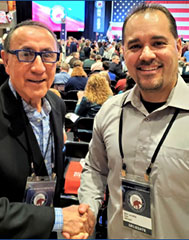
Rick Aguilar and Sen. Eric Lucero
State Sen.-elect Eric Lucero, R-Saint Michael, will be the first Latino American Republican to serve in the Minnesota State Senate. This piece of political history is not new to Lucero. In 2014 he became the first Latino American Republican to be elected to the Minnesota House of Representatives. Lucero lives in Dayton, MN with his wife Erum. He has been one of the rising stars in the Republican party and his colorful and effective social media outreach is known throughout the state. Lucero is a member of the Hispanic Republican Assembly of MN (HRAMN) and has been a keynote speaker at many of the organization’s events over the years.
“We are very proud of Eric and we know he will be an effective addition to the State Senate” stated HRAMN Chair Rick Aguilar. Lucero recently announced his new Committee Assignments which include serving on the Senate Education Finance Committee and the Republican Lead on the Senate Housing Committee in the upcoming 2023-2024 legislative session. “Both Housing and Education are high priorities for the community I represent and for all Minnesotans” Lucero stated. In November, 2022 Lucero was elected the State Senator in the newly redrawn Senate District 30 which includes the communities of Rockford Township, Hanover, Saint Michael, Albertville, Otsego, Elk River, Nowthen and western Oak Grove.
“As a licensed real estate agent and licensed general contractor, being named the Republican Lead on the Housing Committee is a good fit with my background. I’m 100% committed to a vibrant housing market that ties together our community and communities across our great state. As a strong advocate of positive solutions, I look forward to continuing my work creating the best housing options for all Minnesotans via naturally occurring affordable housing,” Lucero said. “Regarding education, Saint Michael-Albertville, Buffalo-Hanover-Montrose, Rockford, and Monticello School Districts are among the many school districts that receive significantly less per pupil funding than metro and suburban area schools. As a former educator myself and strong advocate for high quality education, I’m looking forward to advocating for educational opportunities for our children as a member of the Education Finance Committee.” The MN Legislature gavels back into session January 3rd, 2023!
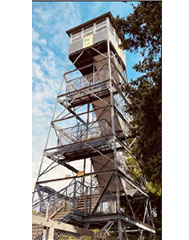
It’s 84 steps to the top of the DNR fire tower adjacent to the DNR building
By Deborah Locke, DNR Information Officer
Photos By Deborah Locke
It’s back!
During the two-year COVID pause, the Minnesota State Fair Department of Natural Resource building at the southwest corner of Carnes Ave. and Nelson St. remained closed. This year for the Aug. 25 - Sept. 5, 2022 run of the fair, the building will be open.
“We’ve reopened for business,” said Dawn Bahajak, the DNR staffer who oversees the DNR’s state fair participation. Typically, 300 employees become involved with fair preparation which kicked off this year with planning meetings in January. Early in the process on-stage entertainers and contractors are hired.
In the weeks before the fair, Fish and Wildlife Division staff catch as many as 1500 fish for the “fish dump” into the fishpond; other employees from the Forestry or Parks and Trails divisions prepare new exhibits or spruce up the old ones, or prepare for fish and deer license sales, or clear away brush and wipe off dust, or prepare brochures, or clean the huge fish tanks and fishpond, or research and write informational public lectures.
In addition to the DNR employees who keep busy, more than 500 volunteers help each fair season, Bahajak said. Some volunteers are master wildlife naturalists who answer questions from the public; some act as greeters, others don the Smokey Bear costume and become a fire-prevention mascot.
The week before the state fair opens, DNR parks and trail staff cut back shrub, trimmed low tree branches, cleared away walking paths and installed new signs. Fish and Wildlife staff checked the well and installed speakers near the fishpond. The noise from power drills rose from the DNR area, and from nearby places of business. A food services semi was parked just outside the turkey food stand behind the DNR building; women opened and cleaned a nearby Mexican food stand. Vehicles moved up and down the state fair streets; traffic into and out of the Como Ave. entrance was steady.
The busyness in that location is long-standing since the DNR building was erected in 1934 as a Civilian Conservation Corps project. At that time, gate admission was 25 cents. Since then, millions of visitors have passed through the entrance gates. The DNR building and surrounding park area are visited by about 500,000 people each year. The fishpond with its seven daily lectures is a big draw,” said Jeff Ledermann, Fish and Wildlife Education and Skills Team Supervisor. “We get up to 25,000 people each year who come by to hear the talks,” he said.
Traditionally the lecture series starts with a talk from Kao Thao, an interpretive naturalist from Fort Snelling State Park who has been speaking at the fishpond for more than 20 years. At 9:45 a.m. on Aug. 25 Thao will talk generally about fishing in Minnesota and will then focus on species in the pond.
“If a lake sturgeon swims by, I’ll describe how long it lives, that it is an ancient species, and I’ll describe other large species,” he said. The pond will be loaded with as many as 1,500 fish on Aug. 24, 2022. That encompasses about 40 different species of fish, from tiny minnows to the 40-pound lake sturgeon. Publications with translations of Minnesota fishing regulations, including a Hmong translation, are available at the information table on the north side of the DNR building. Ledermann said that planning for the fishpond starts two to three months before the fair, which means, among other tasks, determining which staff members will be assigned to the seven talks that occur each day of the fair. The 15-minute mini-lectures at the fishpond take place each day at 45 minutes past the hour starting at 9:45 a.m. and going until 4 p.m. Topics might include fish management, fish biology, fishing tips, and information of what is in the fishpond that year. A live webcam captures the fish underwater, and can be seen at https://www.dnr.state.mn.us/statefair/webcam/fish.html The Parks and Trails Division returns with a kayak and water trail display, an ATV display that includes two ATVs, activities organized by park interpretive naturalists, and the opportunity to hike the one-tenth-mile “Loon State Trail.”
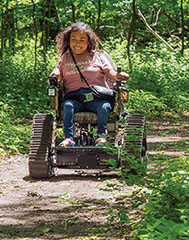
Track chairs are electric powered chairs that help visitors explore
By DNR Parks and Trails Staff
In late July, a woman who used a wheelchair received help from family members to get into the track chair at Camden State Park in southwestern Minnesota. Track chairs are electric powered chairs that help visitors explore designated trails that may not be ideal for regular wheelchairs.
The woman was very nervous, said park supervisor Bill Dinesen. Her family encouraged her to relax and give it a chance. After instruction on how to operate the track chair steering and acceleration lever, known as a “joystick,” the woman took off down the trail, gaining in speed and confidence. Her small audience of family members who walked behind the chair was delighted. Two hours later she returned, informing park staff that she would be back to use the chair again. You could say the joystick was well-named and applies to the entire chair. Her successful operation down a beautiful summer state park trail gave the woman autonomy, choices, and the ability to forge ahead. Her joy was contagious.
Throughout the state, opportunities for recreation and education are increasing for Minnesota state park visitors with disabilities. The addition of track chairs, tactile exhibits, hearing devices and more ensure that visitors of all abilities can enter a park and enjoy indoor amenities as well as those that come with the great outdoors. Here are a few of the new opportunities at state parks:
Track chairs. Currently they are available at Camden, Crow Wing, Lake Bemidji and Myre-Big Island state parks. Maplewood State Park will have a chair available this fall. The track chairs must be reserved in advance and can travel up to about three miles per hour. Park staff will not assist with transferring a chair user into the chair but will provide a transfer board. Riders are instructed to keep an eye on the battery level and to turn back once the battery life is reduced by 50 percent. There is no rental cost, but park visitors must have a $7 state park daily vehicle permit on their vehicle dashboard or must display the $35 annual state park vehicle permit. For more information and to make a reservation with the park, see https://www.dnr.state.mn.us/state_parks/track-chairs.html
Beach chair. McCarthy Beach State Park in northern Minnesota, home to one of the most beautiful swimming beaches in the state, features an adaptive floating beach wheelchair. For more information on the park and the chair (which is used on a first come, first serve basis), go to the park website.
Adaptive bike trails. In the Brainerd area, the Cuyuna Country State Recreation Area has been a top destination for mountain bikers for 20 years. New in 2022 is the Sagamore Unit, which added more than 15 miles of new trails, including the first adaptive bike trails in the state park system. The seven miles of adaptive trails are suitable for three and four-wheel bikes. In addition, a new 1.5-mile accessible hiking trail provides two scenic overlooks as it follows the shoreline of the Sagamore Mine.
Renovated visitor center. St. Croix State Park, near Hinckley, recently celebrated the grand opening of the Walter F. Mondale Visitor Center. The remodeled center offers sensory pens and other accessible features that allow people with vision or hearing limitations to engage with the exhibits. Bronze relief tactiles with raised lettering and braille are featured. The voices of local residents can be heard on a column exhibit with the use of a handset, or the words can be read on the column. The entire exhibit is audio described. A new ramp to the outdoor program space on the back deck adds a second accessible exit to the building.
Wheelchair accessible prairie/bison tour. For several years now visitors to Blue Mounds State Park in southwestern Minnesota have enjoyed 90-minute prairie/bison tours on a tour bus that can accommodate wheelchairs. The tour through the bison range gives visitors the rare opportunity to take in the colors, sights and smells of a Minnesota prairie.
Signage. The DNR is in the process of updating wayfinding signs for state parks and trails. Wild River State Park is one example of a park with updated signs that include information like trail width, running slope, cross slope and surface.
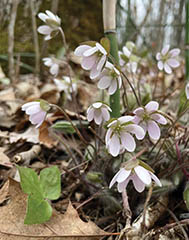
The Hepatica flower
Story by Minnesota Department of Natural Resources Staff
Photos by Megan Johnsen
During her career as a naturalist for Minnesota Parks and Trails, Megan Johnsen eagerly observed the many wildflower species that bloomed in the parks where she worked. A naturalist’s job is to educate park visitors, helping them enjoy natural resources with conservation in mind. Those visitors anxiously anticipate the arrival of spring wildflowers, which proclaim winter’s departure. Seasons blend as the first blooms emerge from the melting snow and subsequent waves usher the forest from brown to green.
Johnsen, who now works as an exhibit developer for the Parks and Trails Division, has observed this transition for years at Banning State Park off Interstate 35, north of Hinckley. She encourages park visitors to make more than one visit in the spring wildflower season because plant species bloom at different times.
“Multiple visits allow you to watch the growth progression,” she said. “The same spot might look totally different in a week’s time.” Beginning with the skunk cabbage plant’s stinky flower in a mysterious flame-shaped fortress, these blossoms carry us through the final days of cold to the intoxicating hopefulness of spring.
Johnsen’s favorite flower patch is along the 1.8-mile Quarry Loop Trail at Banning State Park. Walking just half a mile from the picnic area, hikers will find a seasonal waterfall tumbling down a rocky hillside. A boardwalk protects both hikers’ footwear and the fragile plants covering a forest floor. Look for hepatica, an early bloomer tucked among last year’s fallen leaves. The small, elegant purple flowers can be found in woodlands stretching from Minnesota to Maine, and down the eastern coast to Florida and west to Alabama.
The third course for spring pollinators is a pairing of trout lily and trillium, both abundant at Banning State Park. The trout lilies appear as a carpet of green speckled leaves with yellow or white flowers that change colors over the season. Trillium’s large blossoms blush from white to pink during their brief few weeks in bloom. This park is so well known for its flowers, it has trails named for them. Bring mud boots for the soggy Skunk Cabbage Trail and branch off onto the wooded Trillium Trail.
The best time to observe the early plant life at Banning State Park is on a weekday, since weekends tend to attract crowds of visitors. Johnsen cautions hikers to always stay on the trail for safety. Spring is an active time for ticks, which are most likely to hitch a ride on people and pets if you explore off the maintained trail. Staying on the trail also protects the delicate plants.
“If you walk off trail to get to a hepatica flower, you are likely crushing spring beauties and trout lilies that have not bloomed yet,” she said. “We also never pick spring wildflowers. They need to live out their life cycle to continue as a species and provide for pollinators that are critical to our environment.” Another reason not to pick the flowers is so very visitor after you can enjoy the same view.
To learn which flowers are blooming at a Minnesota state park, check the park website visitor alert, or call the park office.
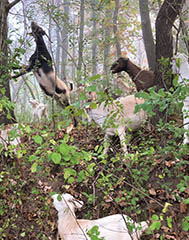
Above is a part of the 60-member herd of goats brought to Afton State Park last fall for buckthorn removal
By Deborah Locke, Information Officer, Department of Natural Resources
Last fall at Afton State Park near Hastings, 60 fenced-in goats ate about three acres of buckthorn leaves and bark per week, which ultimately stresses and kills the buckthorn. It took four weeks to clear the area. On a recent chilly afternoon at the park, workers moved branches of the invasive species to a massive pile for later burning.
No matter what the season, staff with the Department of Natural Resources Parks and Trails Division removes invasive species like the pervasive buckthorn or bush honey suckle. What if they didn’t? “Park visitors would notice,” said Anton Benson, a DNR regional resource specialist. “If buckthorn invaded a savannah or grassland, it would transition in a few years and visitors couldn’t walk through the thorny brush.” Nearby vegetation feels the effect of the pesky species, as well, as it hogs all the sunlight trying to reach the forest floor. Nate Renk, area resource specialist out of Forest Lake, said that open prairies are vulnerable to buckthorn, which covets an open space to expand into and dominate. Over time, remnant prairie pockets like those at Afton State Park would disappear.
Park staff have a bevy of tools for invasive species removal, like hungry goats, heavy equipment including brush mowers, chippers and power saws, and prescribed burns. Winter provides a good environment for burning piles of brush since the ground is frozen and snow covers nearby flammable grasses and undergrowth. Sensitive areas such as wetlands freeze and are better protected from the use of heavy equipment.
Also, some rare species like bats hibernate during the winter so they sleep through the disruption of invasive species removal. Finally, brush is better if it’s burned in large piles, so when there is at least three inches of snow on the ground, the wildfire risk is removed. Other benefits to staff include the fact that a minimal number of wood ticks are active, and park visitors aren’t inconvenienced by the activity. Volunteers, private crews, and Conservation Corps employees assist park staff in invasive species removal.
From the above, perhaps the goat contribution affords the greatest curiosity. Goats? Yup. The animals naturally browse on vegetation, and prefer the new growth at the top of the plants. Sometimes the buckthorn is too tall for goats to reach the tasty top leaves, so a larger, older goat will knock it over. Nate Renk heard about this phenomenon but didn’t believe it until he saw it. After an older female goat brought down the buckthorn, five or six younger goats rushed over to chow down.
Benson said that the goat owners raise the animals as professional consumers that are moved in trailers from location to location. Portable electric fences assure that the animals stay in place.
“We pay them (the goat owners) to feed their goats,” Benson said. “They have a financial incentive to haul the goat herd in. The goats are accustomed to being moved around from site to site.” Park and Trails staff and the herd owners check on the animals throughout their stay. Sometimes after the goats have been in a place long enough to learn the lay of the land, they notice tempting plant life beyond the fence and try to make a run for it. Or a deer will damage the fence at night. Vigilance is required.
The results from the fall buckthorn consumption were good, and the goats will be on grazing duty in the spring. After the grazing season, prescribed burns will remove the remainder of the buckthorn. Prescribed burns don’t work on areas heavily infested with buckthorn due to the density of the growth which prevents the ground from drying in the sun. Challenges to invasive species removal include a need to access a site without impacting groomed trails. To that end, sometimes equipment is dragged to a site on utility sleds. Also, park visitors need to be steered away from heavy equipment as a safety measure. Finally, staff need to stay warm when operating the saws in winter, and they need to stay cool while burning the massive piles.
All of that is left to the humans to figure out. To the goats, Afton State Park offers a grazing wonderland where the only obligation is to show up with an appetite.
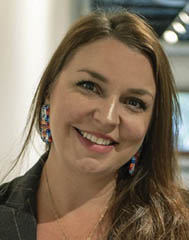
Melissa Anderson, The Greenery Minneapolis, Comcast RISE recipient
Comcast recently announced a major expansion of its Comcast RISE program to now include all women-owned businesses regardless of race or ethnicity in Comcast services areas nationwide, including the Twin Cities. This expansion of the Comcast RISE program furthers its efforts to advance digital equity and help provide underrepresented small business owners with access to the digital tools they need to thrive.
In its first year alone, Comcast RISE provided more than $60 million in grants, marketing and technology services to more than 6,700 small businesses owned by people of color, including Black, Indigenous, Hispanic, and Asian Americans, among others. Of the 6,700 Comcast RISE recipients to date, nearly 70% are businesses owned by women of color, which spurred Comcast to take a deeper look into the unique challenges faced by women entrepreneurs.
According to a study by the National Association of Women Business Owners, 42% of businesses in the U.S. are owned by women, with more than 1,800 new businesses being started every day. That’s nearly five times the national average. However, according to the same study, women-owned businesses are growing at only half the rate of those run by men, namely because women struggle to access capital and other resources to help them succeed.
Comcast RISE, a multi-year, multi-faceted initiative launched to help strengthen small businesses hard hit by COVID-19, is accepting applications now through June 17, 2022. Twin Cities small businesses owned by people of color and all women-owned small businesses are encouraged to apply for the chance to receive consulting, media, and creative production services from Effectv, the advertising sales division of Comcast Cable, or technology upgrades from Comcast Business, based on their specific needs.
“This opportunity is a positive aspect to my business and the community. Not only will we be able to reach more prospects, we’ll also be able to add a few employees to the team,” said Henrietta Smaller of Stunning Beauty Supplies in Burnsville, Minnesota. “It feels great to know someone believes in me and my dream.”
Comcast RISE, which stands for Representation, Investment, Strength, and Empowerment, is part of Project UP, Comcast’s comprehensive initiative to advance digital equity and help provide underrepresented small business owners with access to the digital tools and funding they need to thrive. Over the next 10 years, Comcast is committing $1 billion to programs, like Comcast RISE, and partnerships to reach an estimated 50 million people with the skills, opportunities, and resources they need to succeed in an increasingly digital world.
Comcast RISE, which just celebrated its one-year anniversary, will continue to be open to racially and ethnically diverse small business owners. The expanded Comcast RISE eligibility to all women-owned businesses is effective now. More information and the applications to apply for marketing and technology services are available at www.ComcastRISE.com.
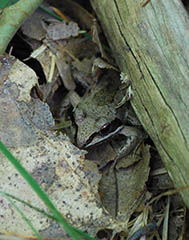
Some species of frogs appear to freeze solid, but their cells contain a kind of antifreeze that protects the cell during the cold months.
By Deborah Locke, DNR Information Officer
Photos provided by the DNR
How do animals survive Minnesota winters? Two Department of Natural Resource Parks and Trails naturalists, Kao Thao, (Fort Snelling State Park), and Jenni Webster, (Interstate State Park), weighed in on techniques that animals take to survive severe weather. To sum up: animals may migrate away, build up a food supply, hunt during the day as well as at night, or sleep through the winter. For smaller critters, the snow actually enhances their quality of life.
“Animals use unique adaptions in unexpected places,” Jenni said. “As we walk through the woods, there’s a whole strange world under our feet.” That strange world emerges when thick snow creates a pocket space between the ground and snow cover that is just big enough for a vole or shrew. Snow cover protects these small mammals from predators, wind and cold; the temperature close to the ground is consistently just above freezing. Shrews tunnel through the snow to reach the surface, which is why you may notice a small exit hole in the snow surface that also provides ventilation.
Animals also adapt with the growth of a thicker coat, Jenni said. White tail deer, for example, grow a winter coat of special hair that is hollow, which helps insulate their bodies. The same principal applies to humans who wear down coats that appear puffy. The puffiness is due to warm air that’s trapped inside the coat, providing heat. Chickadees grow extra feathers that fluff up so air is trapped close to their bodies. The small birds may hide in a small tree cavity and then will shiver all night long to generate warmth.
Kao Thao, Fort Snelling State Park naturalist, said animals adapt in three ways. Fight, flight, or “night-night.” Animals that fight the cold don’t migrate and instead, stay active all winter, Kao said, like deer and fox. Animals will also gather and store food for the winter months, like beaver. In the fall months, beaver collect the tender branches from a tree and pile them in front of the lodge located in a river, pond or lake. “Beaver will swim through the lodge entry, grab a branch and go into the lodge to eat,” Kao said. Fox and bobcats survive winter by hunting more because prey is limited. “You’ll see them running around in the daytime although they’re typically active at night,” Kao said.
Finally, the “night-night” winter survival participants, who sleep for all or most of the winter. Chipmunks sleep with reduced heartbeat rates and a low body temperature. Poke one in the middle of winter, and it will appear to be dead, Kao said. Bears can be aroused quite easily and will wake and go outside for a while, Kao said. Squirrels remain active all winter but if the temperature drops dramatically, they will sleep for a day or two. Some species of frogs appear to freeze solid, but their cells contain a kind of antifreeze that protects the cell during the cold months. In the spring, the frog’s body thaws and a chemical shocks their heart so it starts to beat. The frog will wake in a few hours.
Perhaps the easiest evidence for animal activity and adaption to the winter is snow cover. Take a walk through a state park, or just look out at your yard in daylight. Tracks lead off in every direction. It’s almost like some animal party took place. Like humans, animals adapt to cold weather, and even thrive.
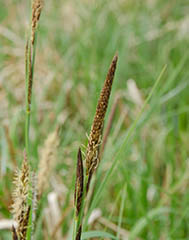
Wild rice shaft
By Deborah Locke, DNR Information Officer
Photos provided by the DNR
For centuries, Lake Ogechie on the Mille Lacs Reservation in central Minnesota produced thousands of pounds of wild rice each season. Old photos show as many as 100 two-person canoes on the lake’s shallow water during the harvest.
This year, for the first time in almost 50 years, Mille Lacs Band members will harvest wild rice from Lake Ogechie following the lowerng of a dam in 2015. To some of you, that may not sound like a big deal. But to the Ojibwe, for whom wild rice represents life itself as a sustaining gift from the Creator, this is one big deal.
“To open this lake after it was impaired for so many years is almost like a healing for our people,” said Kelley Applegate, Mille Lacs Band Department of Natural Resource Commissioner and an enrolled Band member. “This shows that when things go wrong, they can get better. To have this lake open to harvest is proof that when we work together to improve the earth and care for its natural resources, it benefits all inhabitants of the planet.”
The wild rice restoration project helps preserve an important piece of state history, said Kris Erickson, Mille Lacs Kathio State Park Manager. Park staff are charged with preserving the culture and history of an area, which led to efforts by the Mille Lacs Band of Ojibwe and the Department of Natural Resources to restore this significant cultural resource. An added bonus: lowering the lake level also created new wildlife habitat where waterfowl like ducks and geese can feed on wild rice before migrating south.
Conversations about changes to the dam started in about 2004 between the Band and the DNR, said Perry Bunting, Director of Environmental Programs for the Band. There’s nothing simple about making that happen. The 400-acre lake is within reservation boundaries and is managed partly by the Band and by the state DNR. Environmental impact studies took place, hydrologists tested for the impact of a lower water level on the Rum River and Mille Lacs Lake and archeologists surveyed for evidence of habitation. The Band contracted with Canadian researchers who drilled to learn pollen levels from a century ago and earlier. Those tests showed that indeed, the lake had a long history of growing prodigious amounts of wild rice.
Additionally, the lake had a long history of dams. The first was installed in the late 1800s or early 1900s to aid the lumbering industry, according to Kris Erickson with the DNR. In the 1930s, the dam was used to create a water source for farmers in the area that is now Mille Lacs Kathio State Park. The most recent dam, known as the Buckmoore, was completed in 1952 as a way to re-establish the Mille Lacs Lake water level. Lowering the Buckmoore Dam by three feet lowered Lake Ogechie by 18 inches, Erickson said.
When that occurred, an earthy smell emerged, Bunting said. Lake sediment became visible, and before long, the wild rice started to grow again. The rice also grew during a 1988 drought, proving the Band’s point that the dam had created a water level too steep for healthy rice growth. After the Buckmoore Dam was altered, no seeding was required. It’s as if the wild rice – which is actually a grain – knew that a time to flourish would return.
The ricing season lasts for about two weeks starting in late August of each year. Each Minnesota Ojibwe band selects one person who determines when the rice is ripe. Then the work starts – the bending of yellow brown shafts into a canoe floating on shallow water, which knocks the rice to the canoe floor. It’s hard, sweaty work, but you can bet that this year on Ogechie, lifted spirits and a certain joy will ease the labor, contributing toward a great harvest.

Wild rice shaft
By Deborah Locke, DNR Information Officer
Photos provided by the DNR
For centuries, Lake Ogechie on the Mille Lacs Reservation in central Minnesota produced thousands of pounds of wild rice each season. Old photos show as many as 100 two-person canoes on the lake’s shallow water during the harvest.
This year, for the first time in almost 50 years, Mille Lacs Band members will harvest wild rice from Lake Ogechie following the lowerng of a dam in 2015. To some of you, that may not sound like a big deal. But to the Ojibwe, for whom wild rice represents life itself as a sustaining gift from the Creator, this is one big deal.
“To open this lake after it was impaired for so many years is almost like a healing for our people,” said Kelley Applegate, Mille Lacs Band Department of Natural Resource Commissioner and an enrolled Band member. “This shows that when things go wrong, they can get better. To have this lake open to harvest is proof that when we work together to improve the earth and care for its natural resources, it benefits all inhabitants of the planet.”
The wild rice restoration project helps preserve an important piece of state history, said Kris Erickson, Mille Lacs Kathio State Park Manager. Park staff are charged with preserving the culture and history of an area, which led to efforts by the Mille Lacs Band of Ojibwe and the Department of Natural Resources to restore this significant cultural resource. An added bonus: lowering the lake level also created new wildlife habitat where waterfowl like ducks and geese can feed on wild rice before migrating south.
Conversations about changes to the dam started in about 2004 between the Band and the DNR, said Perry Bunting, Director of Environmental Programs for the Band. There’s nothing simple about making that happen. The 400-acre lake is within reservation boundaries and is managed partly by the Band and by the state DNR. Environmental impact studies took place, hydrologists tested for the impact of a lower water level on the Rum River and Mille Lacs Lake and archeologists surveyed for evidence of habitation. The Band contracted with Canadian researchers who drilled to learn pollen levels from a century ago and earlier. Those tests showed that indeed, the lake had a long history of growing prodigious amounts of wild rice.
Additionally, the lake had a long history of dams. The first was installed in the late 1800s or early 1900s to aid the lumbering industry, according to Kris Erickson with the DNR. In the 1930s, the dam was used to create a water source for farmers in the area that is now Mille Lacs Kathio State Park. The most recent dam, known as the Buckmoore, was completed in 1952 as a way to re-establish the Mille Lacs Lake water level. Lowering the Buckmoore Dam by three feet lowered Lake Ogechie by 18 inches, Erickson said.
When that occurred, an earthy smell emerged, Bunting said. Lake sediment became visible, and before long, the wild rice started to grow again. The rice also grew during a 1988 drought, proving the Band’s point that the dam had created a water level too steep for healthy rice growth. After the Buckmoore Dam was altered, no seeding was required. It’s as if the wild rice – which is actually a grain – knew that a time to flourish would return.
The ricing season lasts for about two weeks starting in late August of each year. Each Minnesota Ojibwe band selects one person who determines when the rice is ripe. Then the work starts – the bending of yellow brown shafts into a canoe floating on shallow water, which knocks the rice to the canoe floor. It’s hard, sweaty work, but you can bet that this year on Ogechie, lifted spirits and a certain joy will ease the labor, contributing toward a great harvest.

Come and discover what’s so awesome about Mystery Cave!
By Mollie Miller, Minnesota DNR
A place called the “Dragon’s Jaw” might not sound like a place you’d want to find yourself in without some magical powers or at least your trusty sword – unless you happened to be talking about the Dragon’s Jaw located in one of Minnesota’s most interesting state parks.
Hidden in an underground network of million-year-old caverns, the Dragon’s Jaw in Forestville/Mystery Cave State Park is a magical place where adventure-seekers can traverse an expanse of dark passageways and pools of turquoise water surrounded by ancient, triangular cave formations that look like the teeth of dragons. It would make the perfect background for a fairytale, but this natural wonder is real, it’s only a few hours’ drive from the Twin Cities, and anyone can come explore it.
Discovered in 1937, Mystery Cave is located in the Driftless Area of southeast Minnesota, a region that escaped the flattening effects of the glaciers which covered most of the state during the last ice age about 10,000 years ago. It’s an area of deeply carved river valleys and karst bedrock that can be dissolved and worn away by water flowing underground, creating sinkholes and caves.
Today, the best way to investigate Mystery Cave’s 13 miles of limestone and shale halls is by guided tour with caving experts from Minnesota’s Department of Natural Resources (DNR). The most popular Scenic Tour offers an hour-long trek down fully lit passages and paved walkways through the most developed areas of the cave, giving first-time spelunkers an opportunity to get deep into passages lined with features like stalactites, stalagmites, and flowstone.
Like hiking or biking, recreational caving (known as spelunking), is great fun for any outdoor enthusiast. It’s also a good way to learn about the geologic processes and formations that occurred in prehistoric times, and how they manifest themselves today. The rocks that form modern day Mystery Cave, for example, developed more than 400 million years ago when the land that is now Minnesota was located closer to the equator and was covered by a shallow sea.
“Our state’s natural history is marked by impressive geologic formations, many of which are found in Mystery Cave’s unique environment,” says Dawn Ryan, Cave Supervisor at Mystery Cave State Park. “The cave’s shale and limestone walls entomb fossils of sea-dwelling animals that lived a million years before dinosaurs roamed the earth!”
The Wild Cave Tour, reopening next year, suits people in coveralls, elbow and kneepads, helmets, and headlamps and takes cavers even deeper off the trail, on their hands and knees, and into crevasses and passageways – some only a foot and a half tall! Most people crawl, stoop walk, and even slide on their stomachs to pull through the small passageways.
“Spelunking at Mystery Cave was a fantastic, otherworldly adventure,” says Marcus, a nature enthusiast who recently went below ground with the DNR and Outdoor Afro Minnesota, a community organization with a mission to reconnect African-Americans to natural spaces through recreational activities. “The unforgettable journey was strenuous, and it was one of the best days of my life.”
The sport of exploring underground caverns calls for curiosity. Some people want to seek out and overcome obstacles, while others are on a quest to understand prehistoric life and times. Whatever the reason to embark on a subterranean journey, caving is a recreational activity for everyone.
“After every expedition I lead at Mystery Cave, I am more hopeful for a new generation of spelunkers and cavers,” Ryan says. “Whether for curious beginners or experienced cavers, Minnesotans have access to one of the best caving experiences right under their feet.”
For a deeper dive
Local groups or families interested in learning more about caving in Minnesota
and exploring Mystery Cave are encouraged to call the DNR. Each
guided tour takes you underground through different areas, highlighting
scenic pools and a variety of cave formations.
As of July 1, Mystery Cave will offer the Scenic Tour only, hourly 10am to 4pm, Thursday through Monday. All other caving adventures, including the Geology, Lantern and Wild Tours will open again in 2022. Reserve your tour now at www.mndr.gov/mysterycave.
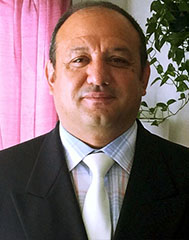
El pastor Saúl Carranza
Por Saúl Carranza
Este cuatro de Julio Celebramos 245 años de independencia de los Estados Unidos de América. Durante estos casi dos siglos y medio se ha conformado la gran nación a la que hoy llamamos hogar. El acta de independencia aprobada por el congreso de Filadelfia el 4 de Julio de 1776 proclama “Sostenemos como evidentes estas verdades: que todos los hombres son creados iguales; que son dotados por su Creador de ciertos derechos inalienables; que entre éstos están la vida, la libertad y la búsqueda de la felicidad; que para garantizar estos derechos se instituyen entre los hombres los gobiernos, que derivan sus poderes legítimos del consentimiento de los gobernados;”.
Jorge Washington, El comandante de las fuerzas revolucionarias y primer presidente de la nación dijo: “La libertad, cuando empieza a echar raíces, es una planta de rápido crecimiento”. Para sembrar esa planta se peleó una guerra de más de ocho años. La regaron con la sangre de más de 25000 personas y se fertilizó con el esfuerzo, pensamiento e ideales de muchos patriotas. La libertad de vida, de expresión, de elegir y ser elegidos y de poder hacer lo que mejor nos parece es un logro muy caro que disfrutamos.
Celebrar el 4 de Julio es más que solamente conmemorar un logro patriótico. Es reconocer el legado de bienestar, libertad y paz que podemos vivir en esta nación. Cuando se compara la vida en los Estados Unidos de américa con otros países entendemos el significado de las palabras del premio Nobel de Literatura, el peruano Mario Vargas llosa quien dijo: “A todos los socialistas les deseo: La abundancia de Venezuela, el salario de Cuba, la justicia de China y la libertad de Corea de Norte.” Nuestro sistema no es perfecto, pero está basado en grandes principios y ha producido grandes logros. Y todos tenemos igualdad de derechos para obtenrlos.
Entendemos como funciona nuestro sistema en otra de las famosas frases de Washington “Es imposible gobernar rectamente al mundo sin Dios y sin la Biblia”. La base de la verdadera libertad es la conciencia limpia y el reconocimiento de nuestras limitaciones, y la necesidad que tenemos de principios firmes que nos guíen. Al celebrar el 4 de Julio celebramos a una nación bajo un Dios y entendemos que la grandeza de este pueblo se encuentra en seguir la enseñanza del Dios de sus padres y reconocer que la verdadera justicia y libertad son regalos del Creador. Tenemos libertad de conciencia, de religión y de expresar lo que pensamos. Todo ello para decidir en libertad lo que es mejor para usted, para su familia y para la nación que todos seguimos construyendo.
Feliz 4 de Julio. Feliz día de la independencia. Dios te bendiga.
“Creo que la Biblia es el mejor don que Dios jamás haya dado a los hombres.” Abraham Lincoln.
*Saúl Carranza es pastor de la Iglesia Familia de Dios en Dayton MN. pastorcarranza@gmail.com (763)245-2378.
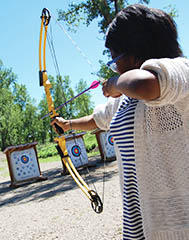
Ever thought it might be fun to learn how to hunt or target shoot with a bow and arrow? Register for the free “Getting Started In Archery” webinar on July 14 to learn basic archery terms and skills necessary. Get info on different types of bows and how to select one to fit your needs. Pre-registration for the free webinar is required.
By Harland Hiemstra, Minnesota DNR
Ever thought it might be fun to get a bow and some arrows and take up the sport of archery? Or perhaps you’ve wanted to take your kids fishing, but aren’t quite sure where to go or how to get started? Maybe you’re just looking for something new to try?
The Minnesota Department of Natural Resources’ has started an online skills building series that could be just the ticket to some new experiences. Or it could help you learn more about outdoors activities you already enjoy.
The DNR started the Minnesota Outdoor Skills and Stewardship Series in March to share how-to knowledge relevant to current Minnesota outdoor seasons and activities. Most of the webinars have focused on fishing or hunting skills. Some have covered other outdoor activities such as kayaking or foraging. Each Wednesday at noon, DNR staff and guest experts spend 30 minutes discussing a particular topic with time for questions at the end.
“We’re excited about reaching people interested in developing their outdoor skills,” says Benji Kohn, volunteer mentor program coordinator for the DNR. “Sometimes all it takes to try something new are a few good tips and some encouragement, and that’s what these webinars are all about.”
The webinar series expands the DNR’s online offerings beyond the turkey and deer hunting classes developed during the COVID-19 pandemic. Past topics in the weekly series have included an introduction to fly fishing and special techniques for pursuing walleye and bass.
Joining the latest webinar lineup are more programs on fishing, as well as programs on archery, fish and wildlife biology, and skills taught through the DNR Becoming an Outdoors Woman program.
While DNR will be resuming more in-person classes over the summer, these webinars are short, require no travel and can reach those with limited free time.
“Even as we add more in-person events, we want to keep our webinar series going because it has been a fun and effective way to share information with people,” Kohn says. “Much of our audience is made up of outdoor enthusiasts who are interested in trying something new — deer hunters who want to try hunting turkeys or anglers who want to catch more bass or walleye, for example.”
Recruiting, retaining and reactivating hunters and anglers is one way the DNR is acting on its strategic plan to connect people to the outdoors. The webinars are a way to broaden access to knowledge and information about outdoor opportunities available in Minnesota, primarily related to fishing and hunting. That knowledge has traditionally been shared among family members or friends. “Say you want to try hunting or go catch your first muskie, but don’t know a hunter or how to pick a muskie lure — that’s where we can help steer people in the right direction,” Kohn said. “People can join a webinar during a lunch hour, and use what they learn to get ready for an upcoming season or simply try something new on the weekend.”
Webinars are scheduled every Wednesday through the summer. Each takes place at noon. The courses are free, but participants are required to pre-register. Summer series topics are as follows and registration pages for the webinars are available on the DNR website:
• June 2 - Metro muskie fishing basics
• June 9 - Take a kid fishing
• June 16 - Shore fishing 101, simple tips and techniques
• June 23 - Introduction to catfish angling
• June 30 - Basic firearms maintenance
• July 7 - Shore fishing 102, down by the river
• July 14 - Getting started in archery
• July 21 - Finding trout in Minnesota streams and lakes
• July 28 - Bear hunting and biology
• Aug. 4 - How to get certified in firearms safety
• Aug. 11 - Rifle basics
• Aug. 18 - Mourning dove hunting
• Aug. 25 - DNR at the 2021 Minnesota State Fair
For more information and to register, visit www.mndnr.gov and type “learn outdoor skills” in the search bar.
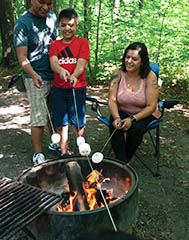
Gather around the campfire at a Minnesota state park
By Harland Hiemstra, Minnesota DNR
One of Minnesota’s favorite recreational opportunities has swelled in popularity over the past year, and officials with the Minnesota Department of Natural Resources expect that trend to continue this summer.
Unlike many entertainment and recreational venues across the state, Minnesota’s Great Outdoors remained open all last year, although services at some facilities were cut back. As individuals and families looked for safe things to do in the face of a global pandemic, large numbers of people turned to the state’s wealth of public lands: state forests, scientific and natural areas, wildlife management areas, and especially state parks and trails.
In 2020, visits to Minnesota state parks and recreation areas grew by 25 percent, up from an average of about 9.84 million in the three previous years to a record 12.3 million last year. For many people, it was their first time visiting a state park.
With 75 state parks and recreation areas to choose from, visitors can experience a wide variety of landscapes, from the pine-scented north woods of Bear Head Lake State Park, to the open prairie and resident bison herds of Blue Mounds and Minneopa State Parks in the southern part of the state; from parks like Wild River and William O’Brien, located on the pristine St. Croix River, to Beaver Creek Valley with its babbling trout stream in the southeast corner of the state. It’s estimated that most Minnesotans live within about 30 minutes of a state park.
It’s not just the landscape and scenery that offer variety. There’s a range of activities people can try out at state parks as well. Camp, hike, paddle a canoe, go fishing, watch wildlife, cook over a fire. For many people, just getting away and being immersed in nature offers therapeutic benefits that are increasingly being recognized by health care professionals as good for both your physical and mental wellbeing.
For the best experience, the DNR recommends that people planning a state park visit keep in mind three key principles:
• Arrive prepared. Buy your vehicle permit and download any park maps you
might want in advance of your trip. Services and facilities may be limited, so
bring everything you might need. It’s a good idea to check the “visitor alert”
section of the home page for the park you’re planning to visit to learn about any
special conditions that might affect your visit.
• Play it safe. Give full attention to your surroundings. Know your personal limits
and don’t take unnecessary risks.
• Follow the rules. Continue to follow all COVID-related guidance, and practice
social distancing—even outdoors. Help keep parks and trails pristine by staying
on trails and disposing of trash properly. Dogs should be leashed. Remember:
the rules are there to assure that everyone has a safe and positive experience.
For newer visitors who may be concerned about going astray while hiking around state parks, DNR offers maps that can be downloaded to a smart phone. When used along with the Avenza app, people can navigate large remote areas using DNR Geospatial PDFs (“GeoPDFs”) on their mobile device, with their current location displayed, but without needing to be connected to the internet or have cell service. For directions on how to do that, as well as information on state parks and the many opportunities they offer, visit the DNR website at www.Mndnr.gov/stateparks.

Saúl Carranza
Por Saúl Carranza
Durante cinco días las banderas del país ondearán a media asta. Es un recordatorio que en la última semana de febrero 2021 mas de quinientas mil vidas se han perdido en el país por causas relacionadas con el Covid-19. Medio millón de personas. Todas ellas eran padres, hijos, hermanos o amigos de alguien y serán extrañados. El corazón de la nación sangra y las familias lloran la pérdida de sus seres queridos.
En el marco de una pandemia que en el mundo ya ha cobrado la vida de dos millones y medio de personas, la discusión sobre si algunas de estas muertes pudieron evitarse sale sobrando. Solo podemos recordarlos y llorar su partida. Lo que si debemos preguntarnos es ¿qué puedo hacer para evitar más muertes por el Covid-19? Mientras los trabajadores de salud trabajan día y noche para rescatar vidas. Nosotros podemos contribuir guardando las medidas que se nos han indicado. Distanciamiento, uso de cubre bocas, lavarse las manos y en cuanto sea posible ponerse la vacuna.
Un Pastor conocido mío tituló su predicación: “La vacuna no es el sello de la bestia”. En respuesta a algunas personas que especulan con esa posibilidad apocalíptica. Cualquier estudioso serio de la Biblia podrá fácilmente demostrar que eso no es así. Pero la verdad es que hay muchas personas que esgrimen argumentos para rechazar la vacuna. Algunos de estos argumentos pueden ser valederos, pero he encontrado que la mayoría de ellos, inclusive los religiosos son falaces. El mismo Señor Jesucristo afirmó que los enfermos son los que necesitan médico Luc.5:31 y la Biblia dice que Dios “muda los tiempos y las edades; quita reyes, y pone reyes; da la sabiduría a los sabios, y la ciencia a los entendidos”. Dan. 2:21.
Quien realmente quiere aprender descubrirá que no hay contradicción entre Biblia y ciencia. Aunque definitivamente hay personas que por condiciones particulares y prescripción médica no pueden ponerse la vacuna. La mayoría podemos y debemos considerar seriamente el tomarla. Las razones son humanitarias. En la medida en la que más personas tienen defensas, los que le rodean se protegen también. Es principalmente un acto solidario con los vulnerables. En la medida en la que mas personas se vacunan el virus ya no puede circular efectivamente y se detiene la transmisión y con ello la enfermedad y la muerte.
Muchos no mueren por Covid-19, pero tienen que sufrir semanas o meses en unidades de cuidados intensivos en los hospitales y luego hay muchos que quedan afectados seriamente por largos periodos o inclusive de por vida. Quienes hemos tenido la bendición de pasar la enfermedad y sobrevivir sin tener secuelas démosle gracias a Dios. Si no has enfermado, con más razón se agradecido. Pero no permitamos que este flagelo siga dañando a nuestra sociedad. La biblia dice: Gál. 6:10 “mientras tengamos oportunidad, hagamos el bien a todos, y especialmente a los de casa, que son nuestros hermanos en la fe.” Al protegernos como individuos también estamos protegiendo a la familia y la comunidad.
Cada persona es libre de actuar como mejor le parezca. Si estas considerando vacunarte el estado ha establecido este sitio para conectar a las personas con la vacuna https://vaccineconnector.mn.gov/. Te invito a visitarlo o consultar a tu médico. Dios te bendiga.
El Pastor Saúl Carranza originario de Guatemala es el Coordinador de Ministerios Hispanos de la Iglesia del Nazareno para Minnesota y las Dakotas. pastorcarranza@gmail.com
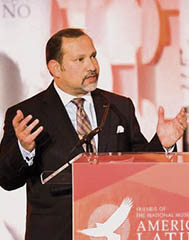
Danny Vargas
Chairman of the FRIENDS board
Dec 23, 2020, Congress approved the National Museum of the American Latino Act (H.R. 2420), which will create the long-overdue museum on the National Mall dedicated to commemorating over 500 years of American Latino contributions to the nation’s military, sciences, economic power, civil rights and the arts. The bill passed the House and the Senate yesterday evening as part of the omnibus that now moves to the President’s desk.
The Friends of the American Latino Museum (FRIENDS), the only organization dedicated to advocating for a National Latino Museum, celebrates this victory in its quarter century-long campaign.“We are thrilled that the Congress voted to approve the National Museum of the American Latino Act and we are so grateful for the many years of bipartisan support. We look forward to the President signing the bill into law,” said Danny Vargas, Chairman of the FRIENDS board. “The passage of this bill caps off a decades-long effort to create an institution that would celebrate and commemorate the over 500 years of Latino contributions to the building, shaping and defending of America; enlighten all visitors to the fascinating complexity of Latino culture and today’s Latino community; and serve to inspire future generations. The time has come to tell the stories that have been excluded from our history book and missing from our museums. We celebrate this historic moment with the countless individuals who have worked so hard over the years to make this happen and our innumerous supporters all over the country.”
“Twenty-six years in the making, the determination of so many in Congress, in business, the arts and across our communities, finally pays off. A museum that highlights the contributions of Latinos and Latinas to our nation at a time when the pandemic has so disproportionately impacted our community seems very fitting.
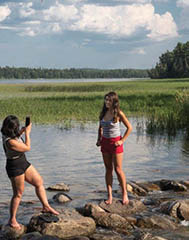
Left: Itasca State Park
By Deborah Locke, Information Officer, Department of Natural Resouces
Most people arrive at a state park and see ways to recreate, like skiing or bird watching. A scientist arrives at a state park and sees a living laboratory, rich with potential. Each year as many as 100 research projects are approved by staff with Minnesota state parks and trails, in addition to the basic university courses offered at park field stations like the Itasca Biological Station and Laboratories at Itasca State Park.
This blend of a pristine environment with research opportunities instructs the next generation of researchers in field biology. Starting in 1909, thousands of students have attended field biology classes at the University of Minnesota’s Itasca Biological Station. The Itasca Station may be the oldest continuously operating field station in the U.S., according to Dr. Jonathan Schilling, Director of the Itasca Biological Station.
“Most of the research at a Biological Station is basic and shows how things work, like the mating capacity of birds, how fish find refuge in areas of a lake and how lakes are disrupted by agricultural runoff,” he said. The 50-square mile park setting contains three ecosystems, coniferous forest, eastern deciduous forest and tall grass prairie, and offers an ideal environment for study.
“I like to say that at Itasca, you can see all three biomes in a day and be home in time for dinner,” Schilling said. (A biome is a major ecological community type, such as a tropical rain forest, grassland, or desert.) Biological station students have the luxury of seeing their professors doing hands-on fieldwork, followed by a casual meal together in the cafeteria. That is where modeling behavior begins, he said, when student-teacher connections evolve outside the classroom walls. The passion to learn is contagious in this picture-perfect environment.
Research is conducted in other state parks, as well. So far in 2020, 84 research permits have been approved. Permission to do field work research is usually granted, said Cindy Lueth, a parks and trails resource specialist. Research findings are shared with DNR park staff, and that increases the park division’s database and informs staff about research management at a particular site. For example, you may be an undergraduate student at Moorhead who is fascinated by tree rings or climate change or a certain fish or bird. “The parks become a classroom,” Lueth said.
Researchers observe, report their findings, and that increases the park division’s database and informs staff on resource management. Students count salamanders or measure alkaline levels in weeds, acting like extra sets of eyes to the park staff, noting changes that might require a new conservation approach by park staff.
Meanwhile, the parks offer amenities like toilets and trails not found in most forests, prairies or wetlands. Those amenities make research easier, and researchers are expected to adhere to park rules similar to other park visitors. The park’s role as park takes precedent over research: no sign of research should ever be evident to members of the public who visit a park. That means nothing may be left behind, no equipment or markers.
“We want visitors to experience the pristine nature of the site, and if they’re instead following lines of ribbons through the woods, that’s not an image we want them to remember,” Lueth said. “Visitors want to see trees and flowers, not ribbons flapping in the wind.”
Lueth grew up with a keen interest in the outdoors, and studied biology as an older returning college student. One of her professors spoke about his childhood years spent outside where he raced around, completely at ease. The plants and animals felt like friends, he said. Later as an adult doing research, outdoor work felt like a chance to meet up with those old friends, the animals and plants of childhood.
“That story resonates with me,” Lueth said. “I’m so lucky to work in an outdoor setting. State parks pay me to do what I would do anyway.”
She added that nature inspires curiosity, appreciation, wonder and awe, whether you’re deep in a state forest or at St. Paul’s Como Park. If you’re a high school senior, a two year college will offer an introduction to biology class that could be your first step toward understanding, preserving and protecting one of Minnesota’s most precious assets: its remarkable outdoors.
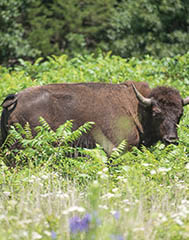
By Harland Hiemstra
Minnesota DNR
Photo by MN DNR
By Dan Ruiter, DNR Information Officer
As the sun came up on a crisp October morning, Blue Mounds State Park came to life with a buzz of activity. This was no sleepy fall day. The bright blue skies contrasted with the prairie’s brown and purple hues around the bison range’s treeless landscape, just as the quiet morning broke to the gathering 25 workers and volunteers. Their mission on this day: sorting the park’s bison herd and providing health checks and vaccinations.
With 106 bison to sort, the work needed to be done efficiently.
Walking westward towards the maze of pens, you start to hear activity.
The clanging of gates. The barking of orders.
And the unmistakable grunt of the bison.
The two conductors of this yearly orchestra are Blue Mounds State Park manager Chris Ingebretsen and park buildings and grounds supervisor Dan McGuire. They are able to give the orders to help move the bison through the system.
“Heifer!”
“Open the gates!”
“Yearling bull!”
The shouted orders from Ingebretsen and McGuire inform the crew what needs to happen. A series of wheeled gates line a narrowing chute helps direct the bison where they need them to go – a large mechanized crate that allows the attending veterinarian to examine the animal. The bison receive vaccinations before hair and blood samples are taken, which will help detect disease and lineage. The pair help determine which bison stay at Blue Mounds, and which ones go to auction.
Sorting and vaccinating this rare herd is critical. As part of the Minnesota Bison Conservation Herd, the bison are special because they rank among the five percent of bison that have no cattle genes. After being hunted to near-extinction, well-meaning ranchers and conservationists bred the plains bison with cattle in the attempt to stave off extinction.
These majestic animals that once freely roamed the nation’s prairies are now mostly confined to America’s bison ranches, but a small number have the good fortune to roam some of America’s largest national parks, and a select number of parks run by their respective states.
Such is the case in Minnesota, where the Department of Natural Resources has maintained its own bison herd for the past six decades at Blue Mounds State Park. That herd has expanded to the Minnesota Zoo, and in 2015, Minneopa State Park where they continue to educate visitors from around the Upper Midwest about these animals’ important roles in prairie ecology and Native American survival and spirituality.
This thriving herd is continually changing. The calving season from May to July bring new members, and as each park reaches its capacity of bison, the fall management determines which ones go to auction to help grow and improve herds at private ranches, and in some cases, help continue genetic diversity in other conservation herds.
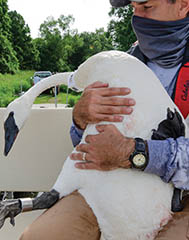
A trumpeter swan is Minnesota’s largest native bird
By Harland Hiemstra
Minnesota DNR
Photo by MN DNR
Weighing 25 to 30 pounds, with a wingspan up to eight feet long, trumpeter swans are Minnesota’s largest native birds -- big, fluffy and white, a picture of majesty and grace. But they might have been nothing more than a footnote in the history books had it not been for proactive conservation efforts spearheaded by the Minnesota Department of Natural Resources.
Prized for their feathers, meat and skin, trumpeter swans were nearly hunted into extinction. By the 1930s, only about 69 of the big birds remained in the lower 48 states, and none in Minnesota. Today, after a successful re-introduction effort that began in the 1960s, biologists estimate some 30,000 trumpeter swans in Minnesota alone. The birds’ comeback was the result of a partnership that included DNR’s Nongame Wildlife Program, the Three Rivers Park District in Hennepin County and the nonprofit Trumpeter Swan Society. This past summer, researchers made progress on a new phase of swan conservation. About 40 trumpeters were captured and collared with solar powered GPS transmitters that can update the birds’ locations every 15 minutes by connecting with cell phone towers. The work occurs when the swans are in their molting phase, lacking all the feathers they need to fly. Researchers glide up in a boat, grab the flightless bird and hug it to their chest to contain its powerful wings and calm it. Back on shore, they record data on each bird, fit it with the collar, then let it go. The collars will last for three to four years before falling off. You can follow the swans online at https://trumpeterswan.netlify.
The multi-year project is a partnership among the U.S. Geological Survey’s Minnesota Cooperative Fish and Wildlife Research Unit, the University of Minnesota, and the U.S. Fish and Wildlife Service, along with DNR and Three Rivers Parks. It will provide data on swan migration and year-round movements, as well as information on the birds’ use of different habitat types and mortality statistics. Similar research is underway in Michigan, Ohio, Iowa, Wisconsin and Manitoba, providing information on about 100 swans all together. Funding for the Minnesota study comes from state lottery proceeds, as appropriated by the legislature.
While trumpeter swans have been deemed a conservation success story, they still face a number of challenges, including habitat loss, collisions with power lines, lead poisoning resulting from their ingestion of lead fishing tackle, and an occasional shooting, usually by a hunter who mistakes it for some other bird.
Trumpeter swans also are extremely sensitive to human disturbance at their breeding sites and will abandon nests and cygnets if disturbed. They usually form a pair bond at about three or four years of age and mate for life. Their nests, which can reach up to 11 feet across and three feet high, are built on an existing structure surrounded by water, such as a muskrat den, a beaver dam or a small island. The female lays four to six oblong eggs, roughly three by five inches in size, which hatch just over a month later. Trumpeter swans keep the eggs warm by covering them with their huge webbed feet.
Those big feet also play an interesting role when it comes time for the big bird to take flight. Built more like a jumbo jet than a small plane, trumpeter swans need as much as 100 yards to take off, and as their wings flap furiously their feet rapidly paddle along atop the surface of the lake or river, almost as if they were running on water – a breathtaking sight we nearly missed out on. The DNR Nongame Wildlife Program works to maintain and enhance the state’s diversity of wildlife, restoring native populations of animals and supporting those Minnesota species that are in greatest need of help. The program protects and manages crucial habitats, conducts scientific research to better understand Minnesota’s wildlife species and the ecosystems they depend upon, and it forges connections between Minnesotans and wildlife through outreach and education.
To learn more about the program, and how you can help animals such as trumpeter swans, eagles and loons, visit www.mndnr.gov/nongame.

Danny Vargas
Chairman of the FRIENDS board
House Majority Leader Steny Hoyer (D-MD) announced this week that on Monday, July 27, the House of Representatives will advance the National Museum of the American Latino Act (H.R. 2420), which would establish a museum in the Smithsonian Institution dedicated to the preservation and celebration of over 500 years of American Latino history. With 295 bipartisan Members of Congress already in support, the Friends of the American Latino Museum (FRIENDS), the only national advocacy campaign striving for the creation of a Smithsonian National American Latino Museum, urges the full House to support the passage of this legislation.
“For over 500 years, the Latino community has been instrumental in the building, shaping and defending of our great nation,” said Danny Vargas, Chairman of the FRIENDS board. “The time has come to commemorate those contributions in a national museum that will illuminate the American story for the benefit of everyone and serve to inspire future generations.”
“This legislation takes an important step towards righting the ongoing disparities in our nation’s museums that remain today,” said Estuardo Rodriguez, President & CEO of FRIENDS. “The widespread support demonstrates just how important this museum is in filling the gaps in our history. We thank our allies and partners in the House, Representatives José Serrano (D-NY), Will Hurd (R-TX),and Tony Cardenas (D-CA) for their leadership in championing this legislation, and bringing us to historic milestones in our mission to see the contributions from generations of American Latinos recognized in the Smithsonian Institution.”
As acknowledged by the Smithsonian Institution in a 1994 report, Willful Neglect, exhibits and collections of U.S. Latino history are the most underrepresented across all of its museums. The National Museum of the American Latino Act would establish a museum dedicated to representing those stories and figures from American Latino history currently absent from the institution.
However, we still have work to do. We must pass this legislation in the US Senate!
The time is now – we’ve never been closer to seeing this museum become a reality. Will you call your Senator and urge them to cosponsor S1267 to create a #LatinoMuseumNow?
Thanks to your phone calls, letters, and messages across social media, the National Museum of the American Latino Act (H.R. 2420 / S. 1267) was unanimously passed in the House and has over 40 bipartisan co-sponsors in the Senate. Make the call today to ensure YOUR Senator supports legislation so we can make our vision a reality.
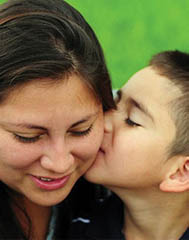 Feliz día de las madres
Feliz día de las madres
Por Rev. Saúl Carranza
Hay muchas celebraciones importantes en el mes de mayo, pero para nosotros, una de las más importantes es la celebración del día de la madre. Aunque no en todo el mundo se celebra en la misma fecha. En Noruega por ejemplo se celebra el 11 de febrero, en Costa Rica es el 15 de agosto, en Panamá la celebran el 8 de diciembre. Y muchos países tienen diferentes fechas. En México y Centro américa se celebra el 10 de mayo y en Estados Unidos el segundo domingo del mismo mes. Sin ser la fecha lo más importante, la persona si lo es. Las reinas del hogar merecen ser reconocidas por su heroica labor no solo un día en el año sino todos los días.
¿Pero porque sera que el día de las madres se celebra mucho mas que el día del padre? Pues tenemos que reconocer que en muchas familias es la madre quien ha marcado la diferencia en la vida de sus hijos, no el padre. Es la madre que ha estado a su lado, es la madre quien los ha sacado adelante en la vida, es la madre quien ha forjado sus vidas con esfuerzo y dedicación. En casa, la madre es enfermera, maestra, administradora, consejera, cocinera, policía y muchísimas otras profesiones más. A esto debemos agregar que fue ella quien llevó en su vientre al bebé, le dió su primer alimento y le cuidó debotamente durante su crecimiento.
Por todo ello, el celebrar y agradecer a la madre lejos de ser una obligación es un privilegio que todo ser humano debe apreciar. Un poema de E. Neumann dice: “Si tienes una madre todavía, da gracias al Señor que te ama tanto. Que no todo mortal contar podría, dicha tan grande ni placer tan santo.” El poema finaliza diciendo: “Más si al cielo se fue... y en tus amores, ya no la harás feliz sobre la tierra. Deposita el recuerdo de tus flores, sobre la fria losa que la encierra.”
El punto es que es el deber de todo hijo honrar a sus padres. Darles en vida honor y satisfacción. Perdonar sus errores y desaciertos y apoyarles de la mejor manera. Muchos hijos viajan a los cementerios en el mes de mayo a depositar las flores que nunca dieron en vida a su madrecita y que ella ya no disfrutará. No esperemos hasta ese momento para demostrar amor. Aún a la distancia, ella se alegra con tus noticias, sus días se endulzan con tus palabras, presume los regalos que le envías y siempre reza por ti. No te olvides de ella.
Es en vida cuando ellas se alegran, cuando se sienten orgullosas, cuando se sienten amadas. No llegues tarde con tus flores. Ama y honra a la autora de tu vida y deseale un muy feliz día de la madre y que Dios la bendiga.
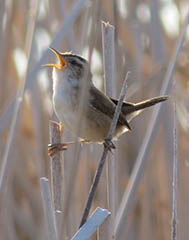 Left: A marsh wren in the wild. Photo by Conner Maloney.
Left: A marsh wren in the wild. Photo by Conner Maloney.
By Deborah Locke, DNR Information Officer
Birds aren’t doing too well in North America. A 2019 study from the publication “Science” shows a decline in the bird population of three billion since 1970, “with steep declines in every habitat.” The 2019 U.S. State of the Birds Report listed the losses as these: 22 percent fewer forest birds, 37 percent fewer shorebirds, and 53 percent fewer grassland birds.
That means the chorus of bird song from your state parks this spring has gradually dropped in volume. The decline hasn’t gone unnoticed. Conservation efforts to protect and conserve bird habitats are a priority with the state Department of Natural Resources. We asked the experts what’s being done in this two-part story that will conclude next month. Below is a Q&A with Kristin A.L. Hall, Conservation Focus Area Coordinator for the State Wildlife Action Plan. Next month we’ll feature Shawn Fritcher, a Parks and Trails District Resource Specialist at Whitewater State Park.
Kristin Hall
Why should we care about birds? The top three reasons to care about birds: They provide important ecosystem services (pest control), they are good environmental indicators (water quality) and they have high intrinsic value (imagine the return of spring without the singing of a bird).
Why do birds require special habitats? Aren’t they alike and have the same needs? Birds, like people, come in many shapes and sizes and have varying needs.
Do they all have the same kinds of habitats? How are the habitats threatened, if ever? Some birds, like European starlings or rock pigeons, are generalists and can make their home anywhere. Other birds are specialists, relying on specific habitat types and habitat quality in order to survive. Some of those specialist groups include secretive marsh birds, grassland obligates and waterfowl. Each has different and specific habitat needs.
Habitat specifications comes down to life history details for each species; what do they eat? Where do they nest? How do they move? Birds that eat insects (insectivores) need something different from those that eat fish. Similarly, birds that nest in cavities need standing dead trees and birds that swim need open water.
Habitat loss or degradation is one of the biggest threats to birds and other wildlife. Land use changes such as draining wetlands, development, grassland conversion, and unsustainable forest management are all potential habitat threats.
What steps has the DNR taken to help birds? Minnesota has about 314 regularly occurring bird species that call the state home at some point in the annual cycle. Of those, the Minnesota DNR has classified 92 bird species as Species in Greatest Conservation Need. The DNR helps protect these SGCN through habitat conservation, surveys and monitoring. We work to restore and create habitat for these birds and other wildlife on our state-owned lands, and by working with private land owners through conservation easements. We keep detailed long-term trend and population data of the birds through the Minnesota Biological Survey. We monitor the effectiveness of our habitat work by assessing species response to conservation practices. An example is the Grassland Monitoring Team that monitors plant and bird response to conservation grazing and prescribed burning practices in the prairie region.
Why are there so fewer birds across North America now? There is no one thing we can pinpoint that would explain the alarming declines in bird populations. Many threats, including: climate change, habitat loss and degradation, pollutants and environmental toxins, predation by free roaming domestic pets, and man-made infrastructure can have a cumulative impact.
I live in the city. How can I help birds? Can I create a habitat in my back yard? YES. Creating small patches of native habitat in your back yard can help birds as well as pollinators! Programs like “Lawns to Legumes” (by BOWSR) are a great way to get started. If you don’t have a back yard or if it is already a native plant paradise, legislation is another way to take action. Contact your local representative and make sure they are aware of your environmental concerns and that they are supporting legislation such as the Recovering America’s Wildlife Act currently making its way through congress.
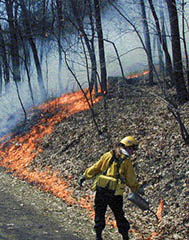 Left: Afton State Park prescribed fire
Left: Afton State Park prescribed fire
By Deborah Locke, DNR Information Officer
Photos by DNR staff photo
Fire, a destructive force, or a rejuvenating tool?
In the hands of trained parks and trails professionals, fire is a restoration tool that leads to new plant growth, open views, increased sunlight, and the containment and even elimination of invasive species.
Prescribed fires occur on a rotating basis each spring and fall at Minnesota state parks, said Shawn Fritcher, a nearly 30-year veteran of prescriptive burning. He’s been with the Department of Natural Resources Parks and Trails division for about 20 years, and has a “Burn Boss” designation which means he can oversee prescribed burns.
It takes time and repeated burns to see results, but a 450-acre burn at Great River Bluffs State Park one year succeeded in decreasing large swaths of invasive buckthorn and honeysuckle, leading Fritcher to conclude that a lot of good occurred in a single day of work.
“If we had done that by hand, it would have taken weeks,” he said. Planning for a burn starts months in advance, and can vary from a few acres to hundreds of acres, said Ed Quinn, the Parks and Trails natural resource program supervisor. Each year Parks and Trails staff burn about 3,900 acres of prairie land, and 2,500 acres of forest. The work starts in March and most of it is completed in April. Prescribed fires destroy brush but trees and plant roots survive.
Fire prediction software helps calculate when the burn takes place. Considerations include temperature, humidity and wind speed. Location, the makeup of adjacent land, and other factors determine the burn’s parameters, the equipment needed including water tanks, the number of staff need (usually at least six), a burn permit, and notification of local fire departments.
Burn areas are mapped out and include the location of burn breaks that act like a barrier against the fire leaping into a non-designated burn area, the locations of “igniters” who actually light the fire in several places. The maps also delineate the location of equipment and fire fighters. After the fire stops burning, fire fighters remain at the site, sometimes throughout the night, to ensure that the flames do not flare up.
Shawn Fritcher said the burn work is hard, uncomfortable and intense, requiring constant running up and down bluffs. Stress also plays a role. Safety is imperative. “It can be a physical and mental drain, but it’s worth it in the end when you see the impact,” he said. The wait may take 10 to 15 years of burning before invasive species are reduced. Following a burn, the prairie responds immediately with lush growth, Fritcher said.
Ed Quinn agreed, describing the way the bison herd at Minneopa State Park reacts to the new green plant growth following a prairie fire. After a winter of sparse prairie foraging, the spring offers lush greens, a welcomed diet change.
Prescribed fires are not new to Minnesota: For hundreds and even thousands of years, American Indians used prescribed fire to improve the habitat for a game species or to improve their ability to travel and see long distances.
Today burn experts use fire to restore fire-dependent forests, woodlands, and prairies, and to stimulate prairie seed production. Following a burn, the prairie produces massive amounts of seed that are collected in the fall and re-planted. The 2020 state parks and trails fire crew is deep in the planning stage for prescribed burns as of the end of February. It won’t be long before one of the crew members, like Shawn Fritcher, examines a blackened post-burn site to see the results. More sunlight. Less buckthorn. The promise of new growth.
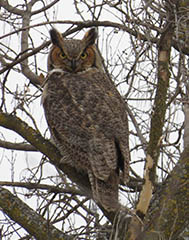 Left: A great horned owl in the wild
Left: A great horned owl in the wild
By Erica Hoaglund, Minnesota DNR
To many Minnesotans at this time of year, Winter can start to feel a little like a long road trip to Spring—are we there yet? As mammals, we humans seem to keep having to fight off the urge to slumber the winter away, to hibernate like a bat in a cave until April. While hibernation, or something like it, is one of the ways animals handle the long winter months, many people may be surprised to know that strategies to make it through the winter are just about as diverse in the animal community as among humans.
Generally, winter survival strategies for wildlife can be broken down into three broad categories that we might refer to as active, inactive and elsewhere. Let’s look at some examples of each; some may surprise you, some may make you jealous.
Inactive. This is one of the more well-known ways for Minnesota wildlife to deal with the winter, but there may be more varieties of inactive than you ever imagined! Wildlife in the frigid north has evolved a range of strategies. The common Grey Tree Frog actually produces a biological antifreeze that allows its body to freeze solid and then thaw out. Bears truly do just “sleep” the winter away in a state between true hibernation and normal sleep. Four of the eight species of bats native to Minnesota hibernate through the winter in caves around the state, their heart rates dropping from 200-300 beats per minute to 10, taking a breath only every couple minutes.
Elsewhere. Many Minnesotans have older relatives or friends whose approach to winter is to head south to warmer climes for a few months each year. Such geographic escape is a common strategy used by a variety of wildlife, too. This is known as migration. Many species such as the Ruby-throated hummingbird (a common backyard visitor in the Twin Cities) move hundreds or thousands of miles to places like Central America that stay warm all year long. While four of Minnesota’s native bat species hibernate, the other four prefer migration to hanging upside down in a cold cave for the winter months. Some species’ movements are not so dramatic. Turtles, for example, require only liquid, oxygen carrying water to sustain them over the winter, so they may move as little as a few hundred feet from shallow wetlands to deeper lakes or rivers where they remain buried in mud for the winter months.
Active! If you can’t escape it or sleep through it, you might as well embrace it. Though it might surprise some folks, there are a whole bunch of animals that seem to have that attitude toward winter, spending the season as active participants. Sometimes they can be even more active than in the summer months! Our state’s largest salamander, the aquatic mudpuppy, spends its winters very actively feeding and breeding, remaining largely sedentary in the summer as they guard their eggs under rocks. Voles are largely solitary in the warmer months, but in winter they can create a maze of tunnels beneath the snow to travel safely and socialize, out of sight of predators such as owls. Speaking of owls, they’re another species that gets very active in the deep of winter. Stand in your backyard at night and listen for them hooting to each other as they set up territories and prepare to nest.
So, as winter stretches on, consider getting outside to see what’s going on in the natural world. There’s a whole lot more happening than you might guess. Winter is a great time to look for animal tracks, and for exploring places that might be too wet, weedy or buggy in summer. Many state parks offer special activities in winter; visit www.mndnr.gov and search for the “events calendar.” You can also see a lot just looking out a favorite window and watching for wildlife that has also stuck around in the frozen north. Don’t complain about winter, learn to enjoy it!
Erica Hoaglund is a biologist for the DNR’s Nongame Wildlife Program, which helps preserve and protect thousands of Minnesota wildlife species, some of them threatened or endangered. The program is supported almost entirely through voluntary donations, either directly or by designating an amount to donate on Line 22 of your Minnesota individual income tax form (look for the loon). Visit www.mndnr.gov/nongame to learn more.
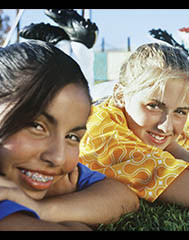 Boys and girls are recommended to get HPV vaccine
Boys and girls are recommended to get HPV vaccine
Human papillomavirus, also known as HPV, is a very common virus. Almost all people will get at least one type of HPV at some time in their lives. Most HPV infections go away on their own, but sometimes the infection stays and can lead to cancer. Every year in the United States, about 35,000 women and men are diagnosed with a cancer caused by HPV. The HPV vaccine helps protect young people from getting this virus, which means it protects them from cancer.
One of the most common types of cancer caused by HPV is cervical cancer. Cervical cancer was once the leading cause of cancer deaths among women in the United States. Cervical cancer screening, which are tests to catch cervical cancer early, have helped decrease the number of cervical cancer deaths. Now, screening and the HPV vaccine have made cervical cancer one of the most preventable cancers.
However, it is still a problem. In 2016, there were almost 13,000 new cases of cervical cancer reported in the United States, and 161 of those cases were Minnesota women. Even more women get precancers. Precancers are abnormal cells that can lead to cancer. They can be found through cervical cancer screening, but the testing and treatment of precancers can cause other health problems.
HPV vaccination could prevent more than 90% of cervical cancers and precancers. The problem is only about half of Minnesota adolescents are getting this vaccine. Boys and girls are recommended to get two doses of the HPV vaccine when they are 11 or 12 years old. Older teens and adults can also get the vaccine, but they will need three doses if they start the vaccine when they are 15 years old or older.
The vaccine works the best if given before coming into contact with HPV. Studies show the protection from the vaccine lasts a long time. Women who have received the HPV vaccine should still get regular cervical cancer screening starting at age 21 because the vaccine is not 100% effective a preventing cervical cancer.
The HPV vaccine is safe. Over 100 million HPV vaccines have been given since the vaccine was licensed by the Food and Drug Administration (FDA) and recommended by the Centers for Disease Prevention and Control (CDC). All vaccines used in the United States are required to go through years of safety testing before they are licensed. Health professionals continue to watch the safety of the vaccine once it is being used. There are over 10 years of safety data now that show the HPV vaccine is safe and doesn’t cause serious health problems.
Vaccines, like any medicine, can have some side effects. Most side effects from vaccines are not serious. The most common side effect reported with vaccines, including HPV vaccine, are pain, redness, or swelling in the arm where the vaccine was given. These side effects usually go away in a few days. Fainting after any vaccine is more common among teens. This is why the doctor will have them sit and be watched for about 15 minutes after the vaccine is given.
With the HPV vaccine, we have the power to prevent six types of cancer, including cervical cancer. Get your 11 and 12 year olds vaccinated to protect them. Talk to your child’s health care provider to see what vaccines are recommended for them. If you don’t have a child this age, tell your family and friends about the importance of getting their kids vaccinated.
 Left: Saúl Carranza
Left: Saúl Carranza
Lamentos como “a mí no me quieren, la vida no es justa, yo merezco tener eso, etc,. “ brotan continuamente y no de personas que tienen poco o nada, sino de personas que tienen mucho pero que no aprecian lo que tienen, porque no pueden verlo. Ante sus ojos solo se muestra lo que él o ella codician. Es bueno recordar el décimo mandamiento de Dios. Ese que muchos solo resumen en “no Codiciarás”, pero, que en realidad dice: “No codicies la casa de tu prójimo. No codicies su mujer, ni sus servidores, su buey o su burro. No codicies nada de lo que le pertenece.” Exodo “20:17
La única forma de no amargarnos es siendo agradecidos. La envidia, el egoísmo y el orgullo carcomen y enferman a muchas personas y las hacen mezquinas y solitarias. El problema para muchos es que viven añorando aquello que no tienen o lo que otros poseen. En su orgullo, muchas personas olvidan todos los beneficios, favores y bondades recibidas y simplemente miran aquello que no es parte de sus posesiones y les duele no tenerlo.
El Dr. Samuél Sánchez dice: “Si hay un pecado que prevalece más hoy día, especialmente entre los creyentes, es la ingratitud. Dios hace tanto por nosotros cada instante de nuestras vidas, y sin embargo, rara vez le damos gracias o el crédito que se merece por Sus bendiciones.”
En muchos hogares hasta han olvidado dar gracias por los alimentos, por la familia, por la salud y la vida. Vivir en el primer mundo significa tener acceso a casi todas las cosas por las cuales trabajamos y que recibimos con mucha más facilidad que personas en otras partes del mundo. Mientras en otros países las personas se preocupan por tener el alimento del día, aquí se preocupan por un televisor más grande, un teléfono más moderno o el carro más caro. No es malo desear esas cosas si podemos tenerlas honradamente.
La celebración de acción de gracias se basa en el principio de ser agradecido por lo que se tiene. Ser agradecido por aquellos que te rodean y quienes se preocupan por ti. Agradecer la vida, la salud y las cosas simples que disfrutamos. Este tiempo de celebración es para hacer un alto en las preocupaciones cotidianas. Hacer una lista de todas las cosas buenas que te rodean y que disfrutas en la paz de la familia. Y por sobre todo, darle gracias al Creador quien te permite disfrutarlas. Este día de acción de gracias recuerda practicar el arte del agradecimiento. Feliz día de Acción de gracias!
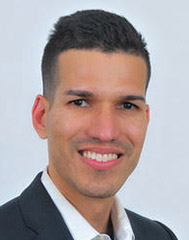 Left: Dr. Hector Colon-Rivera
Left: Dr. Hector Colon-Rivera
By Carmen Robles
In response to the growing opioid epidemic/crisis, the Minnesota Department of Human Services (DHS) sponsored the Hope for our community: Eliminating health inequity en Nuestra Comunidad Conference on Thursday, September 26th, 2019.
Leading the groundbreaking event was Keynote speaker, Dr. Hector Colon-Rivera, a distinguished general, adolescent, and addiction psychiatrist of the Pennsylvania medical community.
Dr. Colon-Rivera serves as a clinical advisor for the Advisory on Alcohol and Other Drugs Committee for the State of Pennsylvania under the Governor Wolf administration and the senior advisor for the Opioid State Targeted Response Technical Assistance for Puerto Rico, helping increase access to assisted medical treatments for patients with substance use disorder.
The program included guest speaker, Jaime Bailey a peer recovery specialist from El Paso, Texas. Moderator Mark Rios from Adult and Teen Challenge Minnesota led a heartfelt panel discussion with individuals who shared their experiences of Treatment and Recovery en Nuestra Comunidad. Speaker Neri Diaz, Minnesota Community Care/La Clinica, shared successful strategies for Reaching Community People.
ALMAS, Henry Sibley High School’s student Latino organization performed a dance of hope for our community through an original message of Hope for our Community, combating the opioid crisis.
Community Services Officer Maria Carmen Moreno, Ramsey County Sheriff’s Office, shared the new administration’s focus and its partnership with public health. Representing the Minneapolis Police departments were officers Baies Escobar and Ceilia Robins.
The conference was an informative, educational and valuable first step in the conversation of the opioid crisis-epidemic affecting the Hispanic/Latino/Afro-Latino/Nativo-Latino/LatinX Minnesota communities, yielding a Next Steps-Action Plan for release in October 2019.
For more information please contact Carmen Robles afrolatino.news@yahoo.com

Take a fall stroll through Glendalough State Park
By Harland Hiemstra, Minnesota DNR
July may get all the glory for its patriotic displays of fireworks, but when it comes to a true explosion of colors, it’s tough to beat the show put on each year by September and October.
As the days get shorter and the nights grow cool, trees undergo chemical changes that cause them to swap their summer greenery for the fiery hues of fall. It’s a process that turns even the daily drive to work into a breathtaking excursion, while providing a forceful reminder of nature’s complex workings.
Tree leaves may look like mere ornaments clustered on branches, but they’re actually miniature solar collectors and food factories. In a process known as “photosynthesis,” substances inside the leaves use sunlight to turn water and carbon dioxide from the air into sugars that feed the tree. The chemical mainly responsible for capturing the sun’s energy and putting it to work this way is a green pigment called chlorophyll. It’s what makes leaves green throughout the growing season. When the amount of sunlight decreases as the days shorten, photosynthesis slows, the tree quits making chlorophyll, and what’s left breaks down, taking the green color with it.
But the green chlorophyll isn’t the only show going on inside the leaves. It’s just a bit of an attention hog, overpowering other chemicals that produce other colors. When the green fades those other hues can shine through. Chemicals known as carotenoids produce the bright yellows and oranges seen on trees like elm, birch and maple. Shades of red and purple, seen on dogwoods and sumac, are produced by anthocyanins, and tannins give rise to the brown leaves of oak trees. Fall colors vary from year to year largely as a result of weather, both in the fall and during the growing season that precedes it. A growing season with ample rain and warm weather, followed by a sunny, dry autumn with cool frostless nights and warm days will produce the best display. Fall rain and cloudy skies can result in muted colors, while heavy winds will cause the leaves to drop early.
With the leaves no longer providing a useful service to the tree after photosynthesis shuts down, a brittle, corky layer of cells begins to form where the leaves attach to the tree. Wind, rain and gravity soon conspire to separate the leaves from the tree, producing occasional blizzards of color as they fall to the ground. In forested areas, the fallen leaves provide habitat for insects and small animals before rotting and enriching the soil, which then feeds the trees and other plants in the great cycle of life.
This fall, before the leaves in your yard turn into just another weekend chore, take some time to appreciate the visual feast nature provides. Go for a drive along one of the region’s big rivers, like the Mississippi, the Minnesota or the St. Croix to enjoy the panoramic scenery. Visit a park. Take a walk in the woods and try to catch a brightly colored leaf as it spirals down from above. Pause for a moment to reflect on what’s around you, and how, as French author Albert Camus said, “Autumn is a second spring, when every leaf is a flower.”
Enjoy Fall with the Minnesota DNR
You can keep track of fall colors and how the leaves are changing from north to south by checking out the Minnesota Department of Natural Resources’ Fall Color Finder at www.mndnr.gov/fall_colors.
Many Minnesota State Parks offer programs highlighting the natural processes of fall, including: Secrets of the Season Hike – Sept. 14, 10 to 11:30 a.m., Interstate State Park; Fall Color Walk – Sept. 28, 9 to 10:30 a.m., Brown’s Creek State Trail (Stillwater trailhead); Fall Color Walk – Oct. 5, 1 to 2:30 p.m., Wild River State Park; Autumn Color Walk – Oct. 12, 1 to 3 p.m., Afton State Park.
Get more information about these and other events at www.mndnr.gov/state_parks/events.html
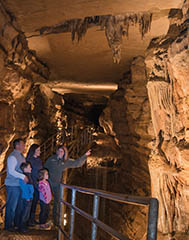
Families can take a trip to the Forestville/Mystery Cave State Park
By Deborah Locke, DNR Information Officer
If like me, you find 48 degrees to be a nearly perfect temperature, visit the cave and beat the heat.
If like me you seek a family-friendly day trip that offers something valuable for both children and adults, visit the cave.
If like me you have a strong affection for all things historical in Minnesota, visit the cave first discovered in 1937. Forestville/Mystery Cave State Park in far southeastern Minnesota is 40 miles southeast of Rochester. The park features hiking and horseback trails, trout streams, campgrounds, and lots of plant and wildlife.
It also features a nearly 13-mile long cave, the longest cave in Minnesota. This was my first venture into the park and then into the cave that came complete with damp air, a pool, stalactites and stalagmites and ancient fossils.
A word of advice first: cell use can be iffy in this remote region, so don’t rely on a GPS to get there because the maps are often inaccurate. More on this later. Also, take a sweater, do not wear sandals or open-toe shoes, and register ahead of time online for your tour tickets to be ensured of a place. There is a charge for tours.
A variety of tours are offered throughout the summer, some are physically challenging and require crawling. We were on the easier one-hour scenic tour. The length of tours varies quite a bit, so plan ahead. Also, age limits may apply depending on the level of difficulty so be sure to check online for all details of your tour.
On our tour day and before entering the cave, our guide gave a short history lesson on the age of the cave, when it was discovered, and why it’s called “Mystery” Cave, which has nothing to do with anything mysterious.
We entered the cave and felt the clammy air, our eyes adjusting to the cave lighting. The route was over metal grate bridges and cement-paved trails. We walked down corridors past massive stone walls shiny with moisture in many places. Massive, too, were the many stalagmites and stalactites throughout the cave. Often you can see and hear dripping water.
I wanted to see the turquoise pool, which was worth the walk. It’s a small pool, dimly lit and quite pretty. Of interest, too, was a small fossilized cephalopod shell in the wall estimated to be as old as 450 million years. Yes, 450 million. I spent a couple of minutes taking that one in.
What became apparent by tour’s end is the way the cave was and is a living, breathing entity once covered by a shallow sea 200 to 500 million years ago. Later, the cave formed in rocks left behind by the sea. For those with an interest in geology, the cave is a wonderland. It may appear to be rugged and lifeless, but the cave has a delicate ecosystem that must be protected. For decades DNR staff have worked to remove artificial fill and to reverse other alterations so the cave returns to its natural state.
If you have a full day to explore, be sure to take in the park with its spring-fed streams, and both tallgrass prairie and deciduous forest topography. History buffs will enjoy the Forestville village settlement founded in 1853 and operated by the Minnesota Historical Society. You can walk the many trails past wildflowers, enjoy wildlife and bird sightings, or even bring in your horse for a ride on the ridge tops and through stream valleys. A visit in the fall includes beautiful forest leaf color; winter visitors may ski or snowmobile the bluffs.
In short, it’s well worth the drive. Last summer my cousin and his wife took their young grandchildren to the cave; they still talk about that great day at Mystery Cave. You’ll find a map online at the park website, but I would also recommend use of a printed Minnesota highway map. As you get closer to the park, watch for the “Mystery Cave” brown sign.
You don’t need a reservation to go into the cave as some tickets are sold on a first come, first served basis. There may be a longer wait for a tour without a reservation. If you do have a reservation, be there 15 minutes early to check in and get your tickets. For tour reservations, call 866-857-2757. For a reservation to the Wild Caving Tour, call 507-937-3251.The park website may be seen at mndnr.gov/forestville.

Pictured left: Having a snack at the campsite
By Verónica Jaralambides
Minnesota DNR
When my husband and I decided to start a family, we promised ourselves that having kids wouldn’t mean abandoning our active lifestyle. We knew we’d have to make adjustments, but we also believed that children provide more reasons than ever to get outdoors. Research shows that time spent in nature improves children’s sensory skills, increases attention spans and enhances social and emotional development. It’s also just a lot of fun!
One of our favorite activities is camping. It’s a great way to travel, and it provides a wealth of memories, from gazing up at the countless stars and listening to the creatures of the night, to making s’mores around a camp fire. Doing it together as a family can be priceless.
And baby makes three
We started our oldest daughter camping when she was still a baby. We bought a family sleeping bag and tucked her between us to keep her warm at night. During the day, we’d tote her about in a baby carrier, same as we’d do in the city. On biking trips, she’d ride nicely in a trailer, often napping.
As kids become more mobile (and fearless) camping can become a bit more worrisome, because there’s no way to “toddler proof” the outdoors. But that also provides great opportunities to teach important lessons. Fire is hot, so you stay away. Always keep close to Mom or Dad. If the stick or rock is sharp, handle with care so you don’t get cut. When we found ourselves near a cliff or steep hill, we’d make sure to hold our child’s hand or carry her in a backpack.
A few years ago, while paddling to our campsite, our two-year-old just wouldn’t sit still, so we tried some experiential learning. We had her feel the cold water with her little hands and feet and offered to let her float alongside the boat in her life jacket. That was all much more persuasive than our telling her not to tip the canoe!
Lessons learned close to home
During the first years, we generally stuck to drive-in campsites and made sure to have a quick way to get back home. We stuck to nearby parks with access to basic shopping, in case we forgot some essential gear. You don’t need to spend lots of money but having the right gear is critical. On one of our early trips, we failed to plan for rain, necessitating a quick run to the nearby thrift store for a rain jacket for our one-year-old. It rained every day, but our daughter stayed dry.
Layers are important for campers of all ages, but more so for kids who heat up and cool down quickly depending on their activity. Avoid cotton clothes, as they hold moisture, and bring extra items, because kids will always get wet. On a recent spring camping trip to Lake Maria State Park, our kids were thrilled by the “private waterfall” of snow melt runoff a few feet from our site. Soon, though, their shoes and socks were soaked with ice-cold water. Luckily, I had dry socks for them, but no extra shoes, so they had to stay put the rest of the evening. They learned the consequences of getting wet. I learned to always have extra shoes, and maybe even rain boots, when camping in the spring.
A hungry kid makes an unhappy camper
Food and water are the next most important elements of a camping trip. “Hangry” kids make for unhappy campers – you and them! Always pack extra food. I make sure to bring plenty of snacks, stuffing some in my daughters’ pockets to teach them to manage their own needs on a hike. Make sure you know where to get drinking water. We like to have a big water tote at our campsite so that something to drink is readily available and we stay hydrated on hot summer days.
Great fun and well worth it
I’m always surprised to hear concerns about kids getting bored while camping for a weekend. Kids will find a million things to do outdoors. And if that’s not enough, Minnesota state parks feature year-round naturalist programming, as well as hands-on exhibits. Most state parks also allow you to check out items such as fishing tackle, binoculars and handheld GPS devices for finding geocaches.
The benefits of including our children in our outdoors lifestyle have far outweighed any extra effort. Our kids are growing up with an understanding of and appreciation for the natural world, and loving every minute. The skills they’ve learned on our outings have given them confidence and courage. And Mom and Dad? We get to enjoy doing what we love with those we love most.

Pictured left: Minnesota Timberwolves to introduce President of Basketball Operations Gersson Rosas
The Minnesota Timberwolves today named Gersson (GR-sin) Rosas (RO-sauce) as the team’s President of Basketball Operations. Rosas will be responsible for all decisions made within the Timberwolves basketball operations department.
“We are excited for Gersson to lead our basketball operations department,” said Timberwolves owner Glen Taylor. “We were extremely impressed with him during the process. He brings many years of NBA front office experience with a very successful organization to our team. I’m confident that he will bring success to our organization.”
Rosas, 40, comes to Minnesota after spending 17 years with the Houston Rockets, the last seven as Executive Vice President of Basketball Operations where he assisted in all basketball operations of the franchise. Rosas was an intern in the Rockets basketball operations department for two years before being Personnel Scout/Video Coordinator prior to the 2004-05 season. He was promoted to Director of Scouting in 2007 and Director of Player Personnel in 2008.
“This is a special opportunity in a great place, and I am excited to pursue the franchise’s goal of building a world class organization with a sustainable winning model for Timberwolves fans to be proud of,” said Timberwolves President of Basketball Operations Gersson Rosas. “Minnesota is such a great area of the country, it’s a major market with a multitude of sports and culture passions. Not only am I eager to get to work in my new role, but I’m also excited to be able to raise my family here and can’t wait to become immersed in the community and everything it has to offer.”
“On behalf of our entire organization, I would like to welcome Gersson and his wife, Susana, and their twins, Grayson and Giana, to the Timberwolves family and the Twin Cities,” said Timberwolves and Lynx CEO Ethan Casson. “In meeting with Gersson, it was apparent that he is the best individual to lead our basketball operations into the future. We are confident that his 17 years of experience helping shape the Houston Rockets into one of the most successful franchises in the NBA has prepared him for this opportunity. Gersson’s innovative style along with his focus on player care and development will lay a strong foundation for our organization for years to come.”
During his time with the Rockets, Rosas also served for four years as General Manager for the Rio Grande Vipers, the team’s NBA G League affiliate. Rosas also served a stint as General Manager for the Dallas Mavericks in 2013, becoming the first Latino GM in the history of the NBA.
Rosas’ past experiences include working as a graduate assistant for the University of Houston men’s basketball team (2003-04), as an assistant coach on Westbury Christian High School’s state championship team (2002-03).
Since 2015, Rosas has been an International Player Personnel Scout for USA Basketball’s Men’s National Team and is a current member of the USA Basketball player selection committee for national team competitions. He also serves as Director of the Americas for the NBA’s Basketball Without Borders program.
A native of Bogota, Colombia, South America, Rosas graduated from the University of Houston in 2000 and was recognized by the school as a Distinguished Sales Excellence Institute Alumnus at the Bauer College of Business in 2011.

Este país vive una crisis de fe en la que verdades afirmadas por nuestros antecesores son cuestionadas o simplemente ignoradas por una parte de las nuevas generaciones. La filosofía posmodernista afirma lo relativo de todas las verdades. La falta de principios que apuntalen nuestra cultura ha desembocado en una sociedad sin los valores que en un pasado cercano dieron unidad y dirección a nuestra gente. La fe cristiana es uno de esos valores.
Cuando en este mes recordamos la vida, pasión, muerte y resurrección de nuestro Señor Jesucristo es común encontrar escépticos que niegan todo ello tratándolo como mitos de gente ignorante que al no tener el valor de vivir su realidad necesitan crear la narrativa de un Dios poderoso a quién recurrir en sus debilidades.
Para negar la vida de alguien tan influyente como Jesús hay que ir contra la historia y la tradición. Lo más cuestionado es la resurrección de Jesús. Para muchos eso nunca pasó. Muchos libros y películas se han producido para negar ese hecho. Por supuesto, todo ello niega los relatos históricos no solo de los evangelios sino también de historiadores de esa época. No aceptan el testimonio de los testigos presenciales del Cristo resucitado ni el de todos aquellos que sellaron con su sangre ese testimonio.
Si Cristo no resucitó resulta muy difícil creer que miles de personas incluyendo a los doce apóstoles se dejaran torturar y aún matar para sostener una mentira. Si Cristo no resucito resultaría incomprensible que el cristianismo sea una fe de billones de personas ¿y todo alrededor de una mentira? Pero aún más difícil es negar el testimonio de personas contemporáneas que afirman tener una relación personal con Dios y el impacto que dicha relación causa en su vida. Ellos afirman la presencia real de Jesús en ellos.
Recientemente un medio de comunicación cuestionó la salud mental del Vicepresidente de la república porque él afirmó que hablaba con Dios. La respuesta del Vicepresidente fue: “Esa es mi fe”. Quién puede negar un argumento como ese. Lo más importante de eso es que esa fe enseña valores tan importantes como el amor al prójimo, el respeto a las autoridades, la ética basada en la virtud y la vida digna. Enseñanzas que hoy hacen tanta falta a nuestra sociedad.
Talvez es tiempo de que demos lugar en nuestra mente contemporánea a esas narraciones que siguen impactando la vida de personas y de pueblos. Hemos permitido que toda clase de argumentos y enseñanzas guíen nuestra existencia. Si el Cristo al que se recuerda en Semana Santa realmente existió y resucitó. Si muchas familias testifican del impacto positivo que ha sido en su vida. Por qué no darle la oportunidad de manifestarse en tu vida. Muchas personas han orado “Dios si existes muéstramelo”. Cómo sería este país si la fe de aquel que dijo que nos amemos unos a otros, que nos apartemos del mal y que vivamos en abundancia la vida que a Dios agrada guiara nuestra vida. La Biblia testifica que Jesús es la manifestación del amor que Dios tiene para cada uno de nosotros. “Más Dios muestra su amor para con nosotros en que siendo aún pecadores, Cristo murió por nosotros”. Romanos. 5:8
Saúl Carranza llegó de Guatemala a Minnesota hace 11 años para servir a la población hispana del estado. Es pastor de la Iglesia Cristo Para Todas las Naciones en Crystal Minnesota y desempeña un ministerio de ayuda a esa comunidad.
Por favor envíe sus opiniones sobre este artículo a pastorcarranza@gmail.com

The National Institutes of Health research shows that nearly 1 in 7 Latino adults has hearing loss.
#1 Is High Blood Pressure Linked to Hearing Loss?
Research is now linking high blood pressure to hearing loss. Some researchers have even called the ear “a window to the heart.” When high blood pressure (130/80 mm Hg and above) is left untreated, it can directly affect your hearing by serving as an accelerating factor in the degeneration of the auditory system. When blood vessels all over the body —including the ears—are injured, fatty plaque builds up and can affect your hearing.
#2 Is Hearing Loss a Sign of Dementia?
Research suggests that age-related hearing loss is associated with cognitive decline and dementia, a condition marked by memory loss and trouble with thinking, problem-solving and other mental tasks. However, one in three cases of dementia could be prevented by maintaining a healthy lifestyle, which could reduce the incidence of dementia by as much as 20 percent. If your ears can no longer pick up on as many sounds, your hearing nerves will send fewer signals to your brain, which increases your chances for mental decline.
#3 What Causes Ears to Ring?
Tinnitus, an audiological and neurological condition, which is often described as a buzzing, hissing, whistling or clicking sound, is primarily caused by environmental and behavioral factors, with noise exposure and hearing loss being the main catalysts. In most cases, tinnitus is a sensorineural reaction in the brain to damage in the ear and auditory system, causing less external sound stimuli to reach the brain. Tinnitus is the brain’s way of filling in the missing sound frequencies it no longer receives from the auditory system.
#4 Can Yoga Improve My Hearing?
Cardiovascular exercise is vital to maintaining hearing health. Whether you are doing vinyasa yoga or jogging, taking just 30 minutes a day to exercise may create the heart rate and level of circulation that could protect your hearing. Certain yoga poses may even help by increasing circulation in your ear and brain, which helps improve nerve function and removes waste and toxins.
#5 Can Prescription Medication Damage My Hearing?
Some medications called ototoxic drugs can damage the ear, resulting in hearing loss, tinnitus or balance disorders. They are far more prevalent than you may have realized. According to the American Speech-Language-Hearing Association, there are more than 200 ototoxic drugs on the market. Some of the most common prescription medications known to cause hearing loss are used to treat serious infections, cancer and heart disease.
#6 How Do I Protect My Ears When I Fly?
Takeoff and landing are the loudest moments, when noise levels inside the cabin can reach 105 decibels (dB). On an older plane, noise levels may be closer to 90-100 dB for the duration of the flight, especially towards the back of a plane, where the engine is. Even if you don’t fly too often, you may want to consider wearing hearing protection during takeoff and landing and avoiding the noisier areas of the plane—in the rear of the cabin and near the engines or propellers.
#7 Can Hearing Loss Impact My Retirement Fund?
When you have untreated hearing loss, you are more likely to face hurdles with effective communication, underemployment and mental health issues that may affect job performance. These factors may lead to less money saved for retirement. A survey of 40,000 households using the National Family Opinion panel found hearing loss negatively impacted household income on average up to $12,000 per year, depending on the degree of hearing loss.
Early detection key to positive outcomes
According to the Hearing Loss Association of America, adults wait an average of seven years from when they first notice symptoms until they seek help for hearing loss. Early detection is key to achieve better results. That’s why the Campaign for Better Hearing and other hearing-focused organizations advocate for early treatment and annual hearing assessments for adults 60 and over.
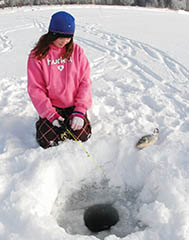
Ice fishing in Lake Bemidji State Park
By Ray Ruiz, Minnesota DNR
Ice fishing is one of the coolest things you can do during the winter months in Minnesota. It’s like having a huge boat made of ice, which allows you to access every single part of the lake (without the expense or hassle of an actual boat). Way cool, if you ask me!
Even if you’ve never tried it before, it’s easy to start ice fishing. All you need are a few simple tools and pieces of equipment. You’ll need an auger for drilling holes in the ice, an ice fishing rod, wax worms and a bucket. An ice chisel also can come in handy. This basic, inexpensive equipment can get you started ice fishing.
Safety is critical when you’re planning to take your family ice fishing. Always make sure to check on the thickness and condition of the ice. You need at least four inches of solid, clear ice for walking on, and more if you’re driving a vehicle. Check out www.mndnr.gov for more guidelines.
You can use a basic hand auger to make holes in the ice, both for checking thickness and for fishing through. Sometimes you can find a cheap used auger at a second-hand store or a garage sale. You can also use a simple ice chisel to break open old used holes made by others.
Outdoor conditions are always changing, so it’s a good idea to be prepared for any change in the weather. It’s important to dress in layers to stay warm while you and your family are ice fishing. Not having the proper winter clothing can make ice fishing cold, uncomfortable and even dangerous. So make sure to wear a warm base layer, and don’t forget the warm hat, gloves, and boots in order to avoid frost-bite.
I frequently get asked, “What’s the best lake to go ice fishing?” My response is always, “The lake that’s closest to your house or apartment.” If you live in the Minneapolis/St. Paul metro area, you’re surrounded by lakes and ponds. The DNR also has a great family fishing program called FIN (Fishing in the Neighborhood). FiN stocks small lakes with lots of fish that are fun to catch—like bluegills, crappies, perch, northern pike and largemouth bass. With more than 60 FiN lakes around the Twin Cities, there’s probably one near you. Learn more at www.mndnr.gov/fin.
Another recommendation when planning your ice fishing trip is to contact your local bait shops. Local bait shops have the most up-to-date fishing reports and they can give you recommendations on where to fish, and advice on the newest and hottest baits. They also may be able to tell you about local ice conditions.
So get on out there and give it a try. When life gives you lemons, it’s said, you’re supposed to make lemonade. And when Nature gives you ice, go ice fishing! You’ll be glad you did.
Ray Ruiz is a Fishing and Hunting Skills Liaison for the Minnesota DNR’s Division of Fish and Wildlife, focusing on outreach to Minnesota’s Latino communities. An avid outdoorsman and accomplished angler with experience in marketing and education, Ruiz holds a Master of Arts degree in Latin American Studies from the University of Minnesota.Por Saúl Carranza

¿Cómo celebras el año nuevo? Las tradiciones familiares, culturales y nacionales son muy alegres y variadas. Y cada persona ve el año nuevo de una manera diferente. Según nos haya ido en 2018 despediremos el año con nostalgia, con tristeza o con esperanza. Un nuevo año es la oportunidad de enmendar lo torcido, desechar lo malo, mejorar lo bueno. En fin. Es tiempo de repensar la vida y proponerse nuevas metas.
El punto es que según veamos la vida podemos hablar de un año más, o de un año menos. Porque si lo pensamos de otra forma veremos que 2018 es un año que hemos gastado de nuestra vida. En una reflexión muy cruda un motivador preguntó a sus oyentes: ¿Cuantos de aquí tienen 20 años? Y les dijo “ustedes ya gastaron la cuarta parte de su vida”. Luego preguntó ¿cuantos tienen cuarenta años? A los que levantaron la mano les dijo “ya gastaron la mitad de su vida”. Luego preguntó ¿cuantos tienen 60 años? “Han agotado el 75% de su vida les dijo”. No siguió preguntando, pero en el ambiente quedó la sensación de “mi vida se está gastando más rápido de lo que yo quisiera”.
La Biblia dice que la vida del ser humano son 70 años y en los más robustos 80 años. La experiencia nos muestra a unos pocos que llegan a los noventa y muy, muy pocos, que llegan a los cien años de vida. Con todo esto dice la Biblia, esos años pasan pronto y volamos. Por eso el mensaje del salmo 90 es “Enséñanos a pensar cómo vivir para que nuestra mente se llene de sabiduría”.
Lo bueno o malo que hayamos hecho ha quedado atrás y no podemos cambiarlo, podemos usarlo como base para el futuro y aprovechar lo aprendido para mejorar. La Biblia nos habla de un hombre que en momento importante de su vida decidió cambiar su destino de dolor y sufrimiento y se encomendó a Dios pidiéndole: “Te ruego que me des tu bendición y un territorio muy grande, que me ayudes y me libres de males, para que yo no sufra.” y la historia termina con la afirmación: “Dios le concedió lo que le había pedido”.
Este hombre se llamó Jabes. Y es testimonio de que la sabiduría en la vida es comprender que yo solo puedo controlar algunas cosas. Que hay asuntos que yo puedo cambiar y otros que solo Dios puede cambiarlos, porque no tengo nada que hacer en ellos. Como el tiempo y la vida. No los manejo, son inexorables, solo los vivo y por lo tanto debo hacerlo con sabiduría. Y el principio de la sabiduría es el temor a Dios. Si te encomiendas a Él y pides por ti. Por tu trabajo y familia, sin duda, descubrirás grandes bendiciones. Como Jabes. Feliz año 2019. Dios te bendiga.
El Rev. Saúl Carranza es el Pastor de la Iglesia Cristo Para Todas las Naciones en Crystal MN. Para más información contacte: pastorcarranza@gmail.com o llame 763-245-2378.
Por Saúl Carranza

El domingo 23 de diciembre en la Iglesia Cristo Para Todas las naciones presentaremos un drama llamado “El milagro de la Navidad”. Es la historia de un hombre alcohólico a punto de perder su familia y aún la vida por el vicio. Pero, un milagro en la época navideña cambió su destino.
Saben, no hay milagro más grande ni que afecte más profundamente a la humanidad que el nacimiento de Cristo. Fue un evento tan grande que aún dividió la historia en Antes de Cristo “AC” y después de Cristo “DC”. Es muy significativo que el número de cada año hace referencia a ese evento. Aunque los historiadores discuten cuál realmente fue el año uno y señalan algunos errores que podrían moverlo de uno a seis años. Si nosotros tomamos nuestra fecha calendario podemos decir que han transcurrido 2018 años desde la primera navidad. Cuando usted dice “yo nací en 1980”, por ejemplo, está diciendo yo nací mil novecientos ochenta años después del año en el que nació Jesús.
Los que estudiamos la historia del cristianismo vemos ese hecho como una irrupción de Dios en la historia de la humanidad. Los evangelios como documentos históricos fijan fecha, lugar y contexto de esos eventos. “El evangelio de Lucas dice: “Por aquellos días salió un decreto del emperador Augusto (27ª.C. a 14 d.C), por el que se debía proceder a un censo en todo el imperio. 2 Este fue el primer censo, siendo Quirino gobernador de Siria. 3 Todos, pues, empezaron a moverse para ser registrados cada uno en su ciudad natal. 4 José también, que estaba en Galilea, en la ciudad de Nazaret, subió a Judea, a la ciudad de David, llamada Belén”. Si bien la historia trata con lugares, personas y fechas. La Biblia habla de la obra de Dios. Como Dios inicia todo el milagro enviando a un ángel a anunciar el nacimiento del Hijo de Dios. A partir de entonces el mundo no es el mismo.
Ahora bien, si nos quedamos en el factor histórico solo podríamos hablar de lo acaecido. Pero cuando vemos vidas transformadas y otras transformándose cuando buscan a Jesús no podemos menos que reconocer que el milagro de la navidad sigo sucediendo. Toda persona que busca a Jesús recibe su milagro. Dios entra a su vida y le cambia de manera significativa. Quienes celebramos la navidad buscamos en cada detalle recordarle del amor de Dios. Los regalos recuerdan que Jesús fue el regalo de Dios para la humanidad. El verde de los árboles que Jesús es la esperanza para la humanidad, las luces que Jesús es la luz del mundo y el rojo de los ornamentos que sólo la sangre de Cristo limpia pecados. Por favor recuerde. Jesús es la razón de la estación. Feliz navidad, Dios te bendiga.
Bendiciones de parte del Pastor Saúl Carranza, Pastor de la Iglesia Cristo Para Todas las Naciones en Crystal MN. Para más información contacte: pastorcarranza@gmail.com o llame 763-245-2378.Por Saúl Carranza

Por Saúl Carranza
Lamentos como “a mí no me quieren, la vida no es justa, yo merezco tener eso, etc,. “ brotan continuamente y no de personas que tienen poco o nada, sino de personas que tienen mucho pero que no aprecian lo que tienen, porque no pueden verlo. Ante sus ojos solo se muestra lo que él o ella codician. Es bueno recordar el décimo mandamiento de Dios. Ese que muchos solo resumen en “no Codiciarás”, pero, que en realidad dice: “No codicies la casa de tu prójimo. No codicies su mujer, ni sus servidores, su buey o su burro. No codicies nada de lo que le pertenece.” Exodo “20:17
La única forma de no amargarnos es siendo agradecidos. La envidia, el egoísmo y el orgullo carcomen y enferman a muchas personas y las hacen mezquinas y solitarias. El problema para muchos es que viven añorando aquello que no tienen o lo que otros poseen. En su orgullo, muchas personas olvidan todos los beneficios, favores y bondades recibidas y simplemente miran aquello que no es parte de sus posesiones y les duele no tenerlo.
El Dr. Samuél Sánchez dice: “Si hay un pecado que prevalece más hoy día, especialmente entre los creyentes, es la ingratitud. Dios hace tanto por nosotros cada instante de nuestras vidas, y sin embargo, rara vez le damos gracias o el crédito que se merece por Sus bendiciones.”
En muchos hogares hasta han olvidado dar gracias por los alimentos, por la familia, por la salud y la vida. Vivir en el primer mundo significa tener acceso a casi todas las cosas por las cuales trabajamos y que recibimos con mucha más facilidad que personas en otras partes del mundo. Mientras en otros países las personas se preocupan por tener el alimento del día, aquí se preocupan por un televisor más grande, un teléfono más moderno o el carro más caro. No es malo desear esas cosas si podemos tenerlas honradamente.
La celebración de acción de gracias se basa en el principio de ser agradecido por lo que se tiene. Ser agradecido por aquellos que te rodean y quienes se preocupan por ti. Agradecer la vida, la salud y las cosas simples que disfrutamos. Este tiempo de celebración es para hacer un alto en las preocupaciones cotidianas. Hacer una lista de todas las cosas buenas que te rodean y que disfrutas en la paz de la familia. Y por sobre todo, darle gracias al Creador quien te permite disfrutarlas. Este día de acción de gracias recuerda practicar el arte del agradecimiento. Feliz dia de Acción de gracias!
Saúl Carranza es originario de Guatemala. Vive en Minnesota desde hace once años y es pastor de la Iglesia Cristo Para Todas las Naciones en Cristal MN. Tel. 7632452378 email pastorcarranza@gmail.com
Por Saúl Carranza

Hace poco escuché a un congresista testificar que él fue el primer hijo de Inmigrantes indocumentados en llegar al congreso de los Estados Unidos. Él dijo: “cuando yo era joven no se hablaba de dreamers” pero yo fui un dreamer.” Poder soñar y anticipar el futuro, aunque a veces parezca irrealizable, es una característica distintiva del ser humano. Tres frases famosas del creador de las películas animadas, Walt Disney ilustran esta realidad. El Señor Disney dijo: “Todos tus sueños se pueden hacer realidad, si tienes el valor para perseguirlos. La manera de comenzar es dejar de hablar y comenzar a actuar y si lo puedes soñar lo puedes lograr”.
Muchos jóvenes inmigrantes han contribuido significativamente para engrandecer el país que los ha recibido, su segundo hogar. Al estudiar la historia de la nación encontramos bravos guerreros, ilustres científicos, destacados deportistas, profesionales de éxito y muchísimos hombres y mujeres que han dado lo mejor de sí para que sus destrezas cualidades y educación contribuyan a hacer un mundo mejor para ellos y para todos. La mayoría de migrantes van buscando un mejor futuro para ellos y su familia. Los padres que hemos traido a nuestros hijos a este país lo hemos hecho con la esperanza de darles mejores oportunidades de estudiar y trabajar. Pero cada uno tiene que hacer su mejor esfuerzo.
Un mejor futuro, en la mayoría de las ocasiones, está ligado a esfuerzo y educación. La persona que quiere destacar en un oficio o profesión tiene que pagar el precio de la disciplina y la constancia. Educación es el medio de adquirir conocimientos, es lo que te permite aprender cómo ser útil a los demás, es el conocimiento que te acerca a tu vocación y la profesión que ejerce esa vocación y te abre la puerta a salarios competitivos en ese campo de acción. A través de la educación se obtienen mejores salarios y reconocimiento profesional.
Una de las más tristes realidades contemporánea de muchos jóvenes hispanos es que abandonan la escuela secundaria para unirse a la fuerza laboral o dedicarse a la vagancia. Algunos porque se ilusionan con ganar su primer salario pues deben contribuir a la economía familiar, otros son obligados por embarazos no esperados y otros porque no tienen la disciplina o el apoyo para continuar estudiando. Si estos jóvenes pudieran ver el futuro promisorio que una buena educación les ofrece seguramente lo pensarían más detenidamente antes de dejar la escuela. La falta de educación y de un título les cierra muchas puertas y los confina a bajos salarios o trabajos con mucho esfuerzo físico.
En la Biblia encontramos el ejemplo de jóvenes inmigrantes que en condiciones totalmente adversas pudieron cambiar su futuro y el de la nación en la que vivieron. Jóvenes como José príncipe de Egipto, Moisés el líder, Josué el guerrero, Daniel el gobernador y muchos más que son ejemplo de como un joven puede triunfar y destacar para lograr un futuro mejor. Aprendemos de ellos que tuvieron que educarse, aprender la lengua y costumbres de los países a los que llegaron y que, a la manera del congresista antes mencionado, llegaron a ser gente influyente e inclusive gobernantes del país en el que vivieron.
Salomón fue probablemente el joven más rico y exitoso de su tiempo. Y él, en el libro de proverbios, dio este consejo a los jóvenes. “ Lo que realmente importa es que cada día seas más sabio y que aumentes tus conocimientos, aunque tengas que vender todo lo que poseas. Valoriza el conocimiento, y tu vida tendrá más valor; si haces tuyo el conocimiento, todos te tratarán con respeto”. También dijo Porque Jehová da la sabiduría, Y de su boca viene el conocimiento y la inteligencia. El provee de sana sabiduría a los rectos; Es escudo a los que caminan rectamente. Prov. 4:7y 2:6 Aún Jesús de Nazaret, en lo poco que la Biblia menciona de su adolescencia y juventud dice: “Y Jesús crecía en estatura, en sabiduría y en gracia para con Dios y con los hombres”. Lucas 2:52. Cuando tenemos que pensar en el futuro, Dios dice: “Esfuérzate, se valiente, no temas, no desmayes. Jehová tu Dios está contigo a dondequiera que vayas y todos los días de tu vida”.
Una buena educación no es barata, hay que invertir mucho esfuerzo y recursos, pero sus frutos se continúan cosechando toda la vida.
Saúl Carranza es originario de Guatemala. Vive en Minnesota desde hace once años y es pastor de la Iglesia Cristo Para Todas las Naciones en Cristal MN. Tel. 7632452378 email pastorcarranza@gmail.com
Por Saúl Carranza

From 1989, when the Congress of the Republic authorized the celebration of the month of the Hispanic Heritage between the September 15 to October 15. Those of us who have roots in one of the Latin American countries celebrate our glorious past, our customs and traditions, our present and promising future in this great country.
We come from many countries, through our veins runs a mixture of European and American blood. We are descendants of proud civilizations such as Maya, Aztec, Inca or some other of those great cultures in which the mythical and magical is intertwined with the Western and Christianity. Giving origin to that mosaic of colors, flavors, aromas and customs that in the United States we call “Hispano / Latina culture."
And we really have reasons to be proud of who we are, what we do and of our people. Hispanics are the fastest growing minority in the United States and we cooperate greatly in the development and economy of this nation. In the sciences, arts, sports and business every day, Hispanic names occupy more important positions. According to the United States Census in July 2016, Hispanics constitute 17.8% of the population with 57.5 million people.
Rightly so, former President Obama said in his 2016 proclamation “Hispanics have had a deep and positive influence in the United States through their strong commitment to family, faith and hard work and service. They have improved and molded the national character with hundreds of traditions that reflect the multi-ethnic and multicultural customs of their community."
The message of the prophet Jeremiah to the people that God had brought to distant lands was: “Build houses and settle down; plant gardens and eat what they produce. Marry and have sons and daughters; find wives for your sons and give your daughters in marriage, so that they too may have sons and daughters. Increase in number there; do not decrease. Also, seek the peace and prosperity of the city to which I have carried you into exile. Pray to the LORD for it, because if it prospers, you too will prosper.” Jeremiah 29:5-7
What a good message for those of us who have emigrated here and we are proud of our heritage. Let us seek the peace and prosperity of the nation of our family and our own. In our prosperity the nation is blessed and in the blessing of the nation, we are blessed.
That’s why when I say, God bless you, I also tell you “echale Ganas”.
Saúl Carranza is the pastor of Church Cristo Para Todas las Naciones in Crystal MN. He is originally from Guatemala and serve as Coordinator for Hispanic Ministries of the Church of the Nazarene for Minnesota, North Dakota and South Dakota. Please call: 763-245-2378 or email: pastorcarranza@gmail.com
Por Saúl Carranza

Goool, es el grito más esperado en estos días de mundial de futbol. Cada país participante en Rusia espera con ansias la participación de su selección nacional o de alguno de sus equipos favoritos. Los primeros encuentros han echado por la borda algunas ilusiones y han dado también gratas sorpresas como la de las selecciones de México y Sur Corea derrotando al campeón del mundo, y dejando fuera a la poderosa selección de Alemania. Se goza y se sufre el futbol.
Por supuesto, el futbol es así. Muchas veces no gana el que tiene el mejor equipo o el que invierte más dinero, ni siquiera el que juega mejor. Gana el que mete más goles. Aunque algunas veces sea por casualidad o con el odiado autogol. Lo que emociona es que esa esfera a la que llamamos balón cruce la línea de la meta contraria y mejor si hincha las redes para gritar gooooool a todo pulmón. Gana el que anota más.
Los que disfrutamos el buen futbol sabemos lo tedioso que es un juego en el que los jugadores no pasan del medio campo. Toman el balón y lo mueven un poco y de un lado a otro, lo regresan, pero les hace falta ese talento que distingue a los grandes delanteros. Saber llevar la bola a la meta. El “olfato de gol”. Esos juegos están condenados a un empate a cero porque no hay quien tenga la visión y habilidad para conducir el ataque.
Hay muchas personas que viven su vida solo en el medio campo. Olvidándose que la única forma de triunfar es alcanzando metas. Así como se critica a un técnico que abusa de los planteamientos estrictamente defensivos. Así es criticable la gente que vive la vida sin deseo de superarse. Aquellos que lo único que les interesa es poder vivir este día y se olvidan del mañana. Se preocupan de tener que comer hoy, reunir para la renta de este mes y la gasolina de la semana. Y nada más. Estas personas solo mueven la pelota de un lado a otro, pero no avanzan hacia ningún lado.
Cada equipo tiene 90 minutos para anotar, y un dicho del futbol es que “goles que no haces te los hacen a ti”. Así es la vida, si no te esfuerzas por alcanzar tus propias metas alguien se aprovechará de tu esfuerzo y falta de ambición y se beneficiará a tu costa. Dios nos ha dotado de increíbles capacidades para alcanzar las metas en la vida. Inteligencia, creatividad, fuerza, destreza y mucho más. Con todo esto solo tienes que “esforzarte, no temer, no desmayar” y a su tiempo alcanzarás aquello que te propongas.
Lo importante es proponerte metas en la vida. Estar consiente de todas tus virtudes y habilidades y aprovechar las oportunidades que te lleguen. Como buen delantero, si la bola está frente a ti, dale con todo y al mejor ángulo. Las oportunidades llegarán. En la palabra de Dios se expresa un deseo que es lo que Dios quiere para cada uno de nosotros. “Amado, yo deseo que tú seas prosperado en todas las cosas, y que tengas salud, así como prospera tu alma.”3 Jn 2 Y si ese es el deseo de Dios y te anima a esforzarte. Dale con todo. Si se puede, si se puede. No temas. Tampoco estas solo o sola. Hay promesa para ti: “No temas, porque yo estoy contigo; no desmayes, porque yo soy tu Dios que te esfuerzo; siempre te ayudaré, siempre te sustentaré con la diestra de mi justicia”. Is 41:10 Mientras la bola rueda, sigue jugando. La meta está allí y tú eres parte del mejor equipo, gánale a la vida por mucho. Si se puede.
Saúl Carranza es originario de Guatemala. Vive en Minnesota desde hace once años y es pastor de la Iglesia Cristo Para Todas las Naciones en Cristal MN. Tel. 7632452378 email pastorcarranza@gmail.com
Por Saúl Carranza
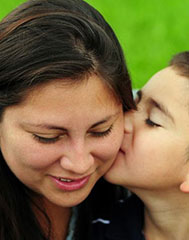
Mayo es el mes de la madre. Y a todas las esforzadas, sacrificadas y dulces madres deseamos un feliz día. Animamos a nuestros lectores a celebrarlas de la mejor manera posible.
Personalmente yo agradezco a mi madre por haberme dejado vivir. Cuando en su situación de pobreza extrema y otros problemas, ya criando a otros dos niños ella supo que estaba embarazada. Alguien le propuso que era mejor que me abortara porque no iban a poder criarme. Ella tomó la decisión correcta, aunque fue la más difícil y la más valiente decidió no cortar la vida, no matar a su bebe.
Hay en todo el mundo opiniones encontradas respecto a si una madre tiene o no el derecho a interrumpir su embarazo. Personalmente creo que cada niño tiene derecho a la vida y que una vez que ha sido concebido es una vida independiente de la vida de la madre. Es cierto que se está formando dentro del cuerpo materno y que depende de él, pero eso no significa que sea parte del mismo. También es cierto que hay casos especiales en los cuales la madre corre peligro y se debe decidir entre la persona ya nacida y la no nacida. Y también hay casos médicos especiales en los que se debe considerar la interrupción de un embarazo. Fuera de ello, son muy pocos los casos en los que éticamente el aborto es una opción.
Me gusta la forma en la que la Biblia toca el tema de los bebes y lo desarrolla.
• La vida es un regalo dado por Dios. (El Dios todopoderoso me hizo, y con su espíritu me dio vida Job 33:4 ).
• Muchas célebres mujeres afirman “Por voluntad de
Dios he concebido”. Como cuando Eva dijo: (“Ya tengo un hijo
varón. El Señor me lo ha dado”) Génesis 4:1.
• Cada hijo es una bendición. (“Los hijos que tenemos son un
regalo de Dios. Los hijos que nos nacen son nuestra recompensa.”)
Salmos 127:3
• Dios conoce personalmente a cada niño antes de que
nazca (Mi embrión vieron tus ojos, y en tu libro estaban escritas
todas aquellas cosas que fueron luego formadas, Sin faltar una de
ellas.) Salmos 139:16
• Dios tiene un maravilloso plan para cada bebé. (” Antes
que te formase en el vientre te conocí, y antes que nacieses te
santifiqué, te di por profeta a las naciones.)” Jeremías 1:5
• Dios responde a la oración de la madre. (“Le pedí al Señor que me diera este hijo, y él me lo concedió”.) 1 Samuel 1:27
En la cultura hispana la madre es sinónimo de amor, de cuidado y de sacrificio. Son ellas las que dan equilibrio y formación a la familia. Por todo ello sabemos que no solo el 10 de mayo sino cada día del año ellas son merecedoras del amor y respeto de su esposo e hijos. Gracias madrecitas. Dios las bendiga.
Por Saúl Carranza

Este país vive una crisis de fe en la que verdades afirmadas por nuestros antecesores son cuestionadas o simplemente ignoradas por una parte de las nuevas generaciones. La filosofía posmodernista afirma lo relativo de todas las verdades. La falta de principios que apuntalen nuestra cultura ha desembocado en una sociedad sin los valores que en un pasado cercano dieron unidad y dirección a nuestra gente. La fe cristiana es uno de esos valores.
Cuando en este mes recordamos la vida, pasión, muerte y resurrección de nuestro Señor Jesucristo es común encontrar escépticos que niegan todo ello tratándolo como mitos de gente ignorante que al no tener el valor de vivir su realidad necesitan crear la narrativa de un Dios poderoso a quién recurrir en sus debilidades.
Para negar la vida de alguien tan influyente como Jesús hay que ir contra la historia y la tradición. Lo más cuestionado es la resurrección de Jesús. Para muchos eso nunca pasó. Muchos libros y películas se han producido para negar ese hecho. Por supuesto, todo ello niega los relatos históricos no solo de los evangelios sino también de historiadores de esa época. No aceptan el testimonio de los testigos presenciales del Cristo resucitado ni el de todos aquellos que sellaron con su sangre ese testimonio.
Si Cristo no resucitó resulta muy difícil creer que miles de personas incluyendo a los doce apóstoles se dejaran torturar y aún matar para sostener una mentira. Si Cristo no resucito resultaría incomprensible que el cristianismo sea una fe de billones de personas ¿y todo alrededor de una mentira? Pero aún más difícil es negar el testimonio de personas contemporáneas que afirman tener una relación personal con Dios y el impacto que dicha relación causa en su vida. Ellos afirman la presencia real de Jesús en ellos.
Recientemente un medio de comunicación cuestionó la salud mental del Vicepresidente de la república porque él afirmó que hablaba con Dios. La respuesta del Vicepresidente fue: “Esa es mi fe”. Quién puede negar un argumento como ese. Lo más importante de eso es que esa fe enseña valores tan importantes como el amor al prójimo, el respeto a las autoridades, la ética basada en la virtud y la vida digna. Enseñanzas que hoy hacen tanta falta a nuestra sociedad.
Talvez es tiempo de que demos lugar en nuestra mente contemporánea a esas narraciones que siguen impactando la vida de personas y de pueblos. Hemos permitido que toda clase de argumentos y enseñanzas guíen nuestra existencia. Si el Cristo al que se recuerda en Semana Santa realmente existió y resucitó. Si muchas familias testifican del impacto positivo que ha sido en su vida. Por qué no darle la oportunidad de manifestarse en tu vida. Muchas personas han orado “Dios si existes muéstramelo”. Cómo sería este país si la fe de aquel que dijo que nos amemos unos a otros, que nos apartemos del mal y que vivamos en abundancia la vida que a Dios agrada guiara nuestra vida. La Biblia testifica que Jesús es la manifestación del amor que Dios tiene para cada uno de nosotros. “Más Dios muestra su amor para con nosotros en que siendo aún pecadores, Cristo murió por nosotros”. Romanos. 5:8
Saúl Carranza llegó de Guatemala a Minnesota hace 11 años para servir a la población hispana del estado. Es pastor de la Iglesia Cristo Para Todas las Naciones en Crystal Minnesota y desempeña un ministerio de ayuda a esa comunidad. Por favor envíe sus opiniones sobre este artículo a pastorcarranza@gmail.com
Por Saúl Carranza

El catorce de febrero pasado ocurrió lo que algunos han dado en llamar “la matanza del día de San Valentín”. 17 personas inocentes murieron en manos de un perturbado manipulando un arma de ataque que nunca debió haber estado a su alcance. Lo más triste de esa situación es que no es un hecho aislado. Según algunas organizaciones en lo que va de 2018, apenas dos meses, se han registrado dieciocho tiroteos en escuelas y en diez de ellos hubo muertos o heridos. Según la organización mundial de la salud el 91% de menores de 15 años muertos por armas de fuego en los países de primer mundo vivían en Estados Unidos. Hay un mal en la sociedad norteamericana.
Nuestros sentimientos y simpatías van para las familias que perdieron a sus seres queridos. Mientras los políticos siguen echando culpas y tratando de jalar agua para su molino, Las familias sufren, jóvenes inocentes mueren y la sociedad se corrompe. Algunos culpan al negocio de las armas llamándola “la industria de la muerte”. Otros culpan a los alienados que sin respeto por la vida humana y movidos por su enferma razón dirigen su locura contra gente inocente. Debemos encontrar soluciones para que nunca más el dolor de Parkland vuelva a sentirse y que nuestros niños, jóvenes y Maestros puedan ir tranquilos a su escuela, iglesia o cualquier lugar público.
Un querido amigo, a quien no conozco por religioso, me dijo hace poco. “Lo que necesitamos es que las familias enseñen mejor a sus hijos, que los niños vuelvan a ser formados en la familia y que vuelvan a la iglesia a aprender sobre el respeto a la vida humana.” Este pensamiento me recordó la entrevista en la que le preguntaron a la hija del recientemente fallecido predicador Billy Graham ¿Por qué Dios permitió el atentado del 11 de Septiembre? Aquí les presento parte de la respuesta: Anne Graham dio una respuesta sumamente profunda y llena de sabiduría.
“Al igual que nosotros, creo que Dios está profundamente triste por este suceso, pero durante años hemos estado diciéndole a Dios que salga de nuestras escuelas, que salga de nuestro gobierno y que salga de nuestras vidas.
¿Cómo podemos esperar que Dios nos dé Su bendición y Su protección cuando le hemos exigido que no se meta en nuestra vida? ... creo que todo comenzó cuando Madeleine Murria O’Hare se quejó de que no quería que se orara en nuestras escuelas… Y dijimos que estaba bien.
Pero Madeleine fue asesinada. Luego alguien dijo que mejor no se leyera la Biblia en las escuelas, aunque la Biblia nos habla de no matar, no robar, de amar a nuestro prójimo... Y dijimos que estaba bien.
Luego el Dr. Benjamín Spock dijo que no debíamos pegarle a nuestros hijos cuando se portan mal porque sus pequeñas personalidades se truncarían y podríamos lastimar su autoestima… Y dijimos que estaba bien, que los expertos deben saber lo que están diciendo… Pero el hijo del Dr. Spock se suicidó.
Luego alguien dijo que los maestros y directores de los colegios no deberían disciplinar a nuestros hijos cuando se portan mal… Ellos también dijeron que más valía que ningún miembro de las escuelas tocara a ningún estudiante que se portara mal porque no queríamos publicidad negativa y por supuesto no queríamos que nadie nos demandara. (Hay una gran diferencia entre disciplinar, tocar, golpear, dar un cachete, humillar, patear, abofetear, etc.) Y dijimos que estaba bien.
Grabemos música que incite a la violencia, al sexo, las drogas, al suicidio y los temas satánicos… Y dijimos que estaba bien. Y dijimos, que no era más que diversión, que no tenía efectos negativos, de todos modos nadie se lo toma en serio... Y dijimos que estaba bien.
Y ahora nos preguntamos:
• ¿por qué nuestros niños no tienen conciencia?
• ¿por qué no saben distinguir entre el bien y el mal?
• ¿por qué no les preocupa matar a desconocidos, a sus compañeros de escuela, o a ellos mismos? Probablemente, si lo pensamos bien, encontraremos la respuesta. “RECOGEMOS, LO QUE SEMBRAMOS”
Por razones de espacio en este artículo he recortado algunas partes de lo que dijo la señora Graham. Pero el lector puede encontrarlo en Internet buscando la frase “dijimos que estaba bien” o “And we said OK.” Con base en lo leído es importante meditar en el daño que se le ha hecho a nuestra sociedad al alejar de nuestros niños y jóvenes los principios que durante siglos fueron la guía de paz y buenas costumbres en la sociedad norteamericana. El amor al prójimo, el respeto a nuestros semejantes, respeto por la vida, el temor a Dios y tantos valores enseñados en la familia a la luz de la Biblia ya no se discuten hoy en día. Todos queremos dar un mejor país a nuestros hijos, también debemos preocuparnos por dar mejores hijos al país. Para mí, la única guía de moral y ética que durante siglos ha guiado eficientemente a la sociedad es la Palabra de Dios. Ella es fuente de sabiduría, norma de buenas costumbres y guía de virtud para el Ser humano. Creo que es tiempo de decir con el profeta: “Hagamos un examen de conciencia y volvamos al camino del Señor” Lam.3:40. Solamente bajo la dirección de Dios el ser humano puede cambiar lo destructivo y malvado de su ser. ¿Cuándo fue la última vez que leyó la Biblia con sus hijos? “Dios es nuestro amparo y fortaleza. Nuestro pronto auxilio en las tribulaciones”. Dios les bendiga.
Saúl Carranza es originario de Guatemala. Coordinador de ministerios hispanos de la Iglesia del Nazareno, Pastor de la Iglesia Cristo Para todas las Naciones en Crystal MN. Profesor de Ética en la Escuela Nazarena de Teología Especializada. Mande un corréo electrónico a saulcarranza@yahoo.com o llame al Tel 763-245-2378.
Por Saúl Carranza

“Una esposa se despertó en medio de la noche y no vio a su esposo en la cama. Ella se levantó y fue a buscarlo alrededor de la casa. De repente lo escuchó en el sótano llorando. Cuando ella bajó al sótano le preguntó: ¿Mi amor, por qué estas llorando? Y él le dice: Te acuerdas 20 años atrás, cuando tu padre me amenazó que si no me casaba contigo yo iría a prisión. Ella le dice: Sí, ¿Por qué? Luego él le contesta: Porque, ésta noche ya yo hubiera salido de la cárcel y se terminaba la condena”. Por supuesto, esto es un chiste. Pero expresa muy bien lo que algunos piensan del matrimonio.
Este año mi esposa Cony y yo celebraremos 32 años de vida matrimonial. En ese tiempo hemos procreado dos hijos y hemos enfrentado muchos retos y vencido muchos problemas. Ni para ella ni para mí ha sido fácil. Pero cada problema, cada desvelo, cada pobreza o enfermedad han servido para hacer más fuerte esa unión. Al mirar atrás y preguntarnos qué es lo que ha permitido que nuestro matrimonio perdure. No encuentro una respuesta o fórmula mágica que nos haya funcionado. Creo que más bien ha sido la gracia de Dios y la conciencia plena de lo que significa el matrimonio lo que ha mantenido vivo nuestro amor.
Recientemente pregunté a algunas parejas de nuestra iglesia porqué se casaron. Aunque las respuestas fueron diversas casi todos, tanto hombres como mujeres de alguna forma se unieron en una sola razón. Todos queremos amar y ser amados o sentirnos amados.
Al llegar al mes del romanticismo y la celebración del amor es bueno recordar algunos de los principios que hacen que el matrimonio pueda ser la sublimación del amor.
Primero, el matrimonio fue creado como una institución bendita que Dios describió diciendo: “Dejará el hombre a su Padre y a su madre y se unirá a su mujer y los dos serán una sola carne”. En el matrimonio nos fundimos en amor para desarrollar un proyecto de vida. Es el encuentro de dos seres que emprenden la maravillosa aventura de formar una familia.
En segundo lugar, el matrimonio es el encuentro de dos personas que se necesitan mutuamente y se complementan. Es la respuesta divina de lo que les faltaba en su estado de soledad. No es lo mismo vivir solo que vivir con alguien que es complemento idóneo. Dios dijo: “Le haré ayuda idónea para él” Gen. 2:23. La palabra idónea significa aquella que complementa perfectamente. Donde cada uno aporta lo mejor que Dios le ha dado. Carácter, bienes, fuerza, voluntad, cualidades y por sobre todo amor. Cuando podemos vernos como complemento perfecto entendemos la grandeza de nuestra unión. Juntos para enfrentar cualquier adversidad y disfrutar a plenitud la vida.
Y lo tercero, es crear un vínculo de pertenencia y relación para toda la vida. No una relación desechable o débil sino una relación profunda de pareja que surge de conocernos. De saber quiénes somos, cualidades y defectos, lo bueno y lo malo de cada uno. Y a pesar de ello nos aceptamos. Es entonces cuando el vínculo se fortalece y crece el amor. Solo así un matrimonio puede durar porque no se construye sobre bases débiles o engañosas. Cada uno sabe lo que puede esperar de su pareja y también sabe dónde debe ayudarle. Tu eres mía y yo soy tuyo. En exclusividad y hasta que la muerte nos separe. No una condena sino el placer de vivir plenamente juntos.
El problema de muchas parejas es que han desarrollado su relación sobre bases falsas, cuanto me gustas, qué me puedes dar, qué tienes. Son relaciones egoístas donde el amor se confunde con el placer o los bienes que se puedan atesorar. El problema de eso es que el placer es efímero y solo durará hasta que la fuente de ese placer se termine o se encuentre otra fuente de satisfacción. El verdadero amor es descrito en la Biblia de la siguiente manera: El amor es sufrido, es benigno; el amor no tiene envidia, el amor no es jactancioso, no se envanece; no hace nada indebido, no busca lo suyo, no se irrita, no guarda rencor; no se goza de la injusticia, más se goza de la verdad. Todo lo sufre, todo lo cree, todo lo espera, todo lo soporta. El amor nunca deja de ser; Aun así, no es fácil, pero si ambos están dispuestos a amar de esa manera, podrán enfrentar todos los problemas que surjan en su camino y vivir una vida feliz. Dios los bendiga. Feliz día del cariño, del amor y la amistad. Saul Carranza es originario de Guatemala. Pastor de la Iglesia Cristo Para Todas las Naciones en Crystal MN. pastorcarranza@gmail.com 763 245 2378.
By Harland Hiemstra, Minn. Dept. of Natural Resources
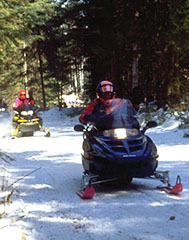
Spend time outdoors with your family this winter!
If you’ve ever enjoyed the rush of sledding down a steep, snowy hill only to wish the slope went on forever and you didn’t have to walk back up to do it again, you might want to look into snowmobiling, one of Minnesota’s most popular outdoor winter activities.
“It’s a great way to get out in nature and see a lot of beautiful areas you might not otherwise be able to see,” says Andrew Korsberg, snowmobile program consultant for the Minnesota Department of Natural Resources. “It’s also just a great way to spend time with family and friends.”
Minnesota has the most extensive snowmobile trail system in the country, with about 22,000 miles of groomed trails. That’s more than the miles of state and federal highways we have! In a year with plenty of snow, a rider could, theoretically, ride a snowmobile from Iowa to the Canadian border.
The extent of Minnesotans’ enthusiasm for snowmobiling is reflected in the fact that 21,300 miles of those snowmobile trails are largely managed and maintained by volunteers affiliated with more than 200 local snowmobiling clubs all across the state. The DNR oversees a grant program that provides much of the funding for their maintenance and grooming work, and it offers technical assistance and other support. The remaining 700 miles are state trails maintained and groomed by the DNR.
That trail system provides the backbone for much of the winter tourism in the state. According to the Minnesota United Snowmobile Association, the total economic impact of snowmobiling in Minnesota is an estimated $1 billion each year. Two of the four major snowmobile manufacturers, Polaris and Arctic Cat, started in Minnesota and remain based in the state. Getting started in snowmobiling can involve some upfront investment, with the cost of a new sled running about $8-15,000. But used sleds can be found for as little as $2,000. If you want to try before you buy, a quick online search will turn up a number of rental opportunities spread around the state. In addition to the machine itself, you’ll need proper cold-weather gear: well insulated snow pants and coat, mittens or gloves, warm boots. A helmet is technically only required for those younger than 18, but it’s a smart safety precaution for everyone, and with the addition of a balaclava worn inside the helmet, is a good way to keep your head from getting cold. Staying warm is a critical factor in having any kind of outdoors fun during a Minnesota winter!
As important as having the right equipment is, you also need to know how to use it safely and legally. Minnesota law requires anyone born after Dec. 31, 1976, to complete a snowmobile safety course, online or in-person (youth ages 11 to 15 must complete at least part of their training in-person). Go the DNR’s website at www.mndnr.gov and search for “snowmobile safety” to get more details.
Capt. Jason Peterson, a regional enforcement supervisor for the DNR, stresses the importance of using common sense to remain safe while having fun on a snowmobile. Don’t go too fast, especially at night. Be cautious when riding on frozen waters; there should be at least seven inches of clear ice – and no ice is ever 100 percent safe. Don’t drink while riding – it’s not only dangerous, it can lead to the same legal consequences as a DWI.
Peterson also emphasizes that all snowmobiles operated in Minnesota must be registered. Registration fees provide funding for the trails system, he notes, so it’s not only the law, it’s a matter of pitching in to help pay for the opportunity to ride all around the state. And make sure you stay on those trails to avoid a citation for trespassing.
Some of the best and most scenic riding opportunities in Minnesota are in the northern part of the state. Popular winter travel destinations, such as Brainerd or Grand Rapids, have extensive state and grant-in-aid trail systems that are both beautiful and well connected to lots of amenities, like restaurants and small towns. The Taconite Trail, which runs from Grand Rapids to Ely, is a favorite. The North Shore State Trail is another great snowmobile ride, winding its way through forests on the ridgeline overlooking Lake Superior for 146 miles from Duluth to Grand Marais.
Since adequate snow is critical to good snowmobiling, it’s smart to check local conditions for your planned destination before loading up and heading out. The DNR website includes an interactive map that provides information on snow depths around the state; it’s updated weekly on Thursdays. Go to www.mndnr.gov and search “current conditions.”
DNR’s website also features trail maps that can be downloaded to a GPS device, so that you can keep track of where you are and where you’re going. A GPS device also is useful for making sure one stays on designated trails. That’s important because much of the statewide trail system crosses private land, and it’s critical to maintain good relations with landowners if they’re to continue allowing access.
So, if the prospect of another two or three months of cold and snow has you feeling down, consider getting in winter’s face on the back of a snowmobile. It might just provide you with a new way to spell F-U-N!
By Harland Hiemstra, Minn. Dept. of Natural Resources
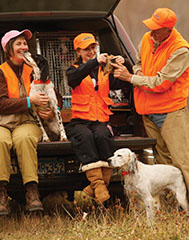
Spend time outdoors with your family this fall!
With its brilliant displays of color, weather that’s neither too hot nor too cold, crisp apples fresh off the tree and college football, fall already has a lot going for it. But for many Minnesotans, autumn also is the season for a tradition that’s as old as humans themselves.
Hunting.
Close to half a million Minnesotans take to the fields and woods and waters each fall. The state has about 30 species of animals that are commonly hunted, ranging from deer, elk and bears to rabbits and squirrels, as well as upland birds such as pheasants, and migratory birds like ducks and geese.
People hunt for a variety of reasons, says Mike Kurre, an avid hunter himself who also works to get others involved in the sport as the hunting and angling mentorship coordinator for the Minnesota Department of Natural Resources (DNR). Many do it to spend time outdoors with friends or family. Others hunt to continue a tradition passed down from their parents and grandparents. Some go for the satisfaction of providing their own meat or the challenge of outwitting a wild animal “Here’s a healthy activity that’s fun, it can provide quality time outdoors with friends and family, it offers good exercise, and it can even put food on the table,” Kurre says. “What’s there not to like about all that?”
And with nearly 1,500 wildlife management areas encompassing nearly 1.3 million acres of land open to public hunting across the state, you’d be hard pressed to find any place with better opportunities. If you’re new to hunting, though, there are some basic rules you need to know about and follow.
First, to hunt in Minnesota, you need the appropriate type of license. And to get a license, anyone born on or after January 1, 1980, needs a MN DNR Firearms Safety/Hunter Education Certification, or a Hunter Safety Education Certificate issued by another state. Making sure hunters are informed about safe handling of firearms and safe practices in the field is a major reason why hunting has grown into such a safe sport, with some studies indicating a person is more likely to be injured riding bicycle or playing tennis than while pursuing wild game.
Adults can take an online course to satisfy the safety training requirement. Youth 11 to 17 can take an online course, or better yet, find a classroom course nearby; a field day is required of youth to show that they’re competent in the safe handling of a firearm. Youth 12 and under can hunt without the certification as long as they are accompanied by a licensed parent or guardian. Adults without the training also can get an Apprentice Hunter Validation which allows them to hunt in the presence of a licensed hunter for up to two seasons before getting their certificate. More information on requirements, including online and classroom instruction, can be found at www.mndnr.gov.
Kurre strongly endorses the idea of novice hunters “apprenticing” with someone more experienced. That way a person can learn about finding game and understanding wildlife habits, as well as enjoying the social camaraderie of hunting, which is part of the fun. Partnering with a seasoned hunter also might lighten the burden of determining what gear (including an appropriate firearm) is needed for a particular type of game. More information on mentored hunting opportunities can be found at www.mndnr.gov/discover.
It’s also important to find a suitable place to hunt. In addition to Wildlife Management Areas, hunting is allowed in most state forests, and on some Scientific and Natural Areas. DNR’s website provides great information, and a mobile version of the DNR Recreation Compass can even be used on a smartphone to help hunters in the field make sure they stay on public lands and avoid trespassing: www.mndnr.gov/compass/mobile.
Finally, anyone planning to hunt in Minnesota should spend some time getting familiar with the “Minnesota Hunting and Trapping Regulations” booklet published each year by the DNR. It provides details on seasons and limits, spells out rules regarding appropriate firearms, safety, trespass and a host of other things to know. The free booklet is available in hard copy, online and through a smartphone app.
By Deborah Locke

Spend time outdoors with your family this fall!
Looking into a crystal ball for answers to any question can be risky, especially when it comes to a Minnesota weather season. But your Minnesota Department of Natural Resources staff have been around for a pretty long time and feel confident with this prediction: fall will be beautiful in Minnesota almost everywhere. So get out to your state parks with the kids and your cousins and your abuela and admire the rich, gorgeous leaf color.
We said “almost everywhere” because summer rainfall is a strong predictor of vivid leaf color. Less rain has fallen in the west central and northwestern parts of the state, and that could actually increase the color display -- if a little rain should fall soon and ease drought conditions.
There’s also a very good chance that south central and southeastern Minnesota will see an early fall, due to extra rainfall in July.
All of the above begs a seasonal question that we get often at the Department of Natural Resources. Just why do those leaves change color? Longer days and shorter bouts with sunshine as well as cooler nights trigger the color change. The most brilliant leaves you’ll see show their hues after many warm and sunny days and cool nights.
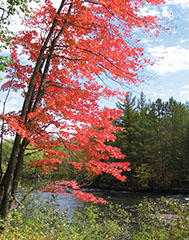
The stunning beauty found at Banning State Park located near Sandstone.
Those shorter periods of daylight mean a closing off of the leaf veins that carry liquid sugar in and out of leaves. As a consequence, sugars in the leaf permit the red and purple colors to develop. You’ll find purple-like and red pigments in the leaves of maple and oak, some varieties of ash, and tall shrubs like cherry, sumac and viburnum.
Yellow is always present in leaves all summer long, but the color is revealed when the green pigment in chlorophyll breaks down. The yellow leaves, found in ash, aspen, basswood, birch, cottonwood and elm, may be short in lifespan due to drought conditions. If it’s dry, not as much sugar is produced so there isn’t as much color.
To check out any of the above for yourself, do check out a state park! Find peak color on our online Fall Color Finder at mndnr.gov/fallcolor every Thursday starting Sept. 7. If you’ve never been to a state park, know that you’ll find one within about 30 minutes of nearly every town and city in the state. Find you favorite at mndnr.gov/parkfinder.
As a general rule, colors typically peak between mid-September and early October in the northern third of Minnesota, between late September and early October in the central third of the state, and between late September and mid-October in the southern third, which includes the Twin Cities.
So throw a sweater over your shoulders and head for the great outdoors into a world of red and yellow.
By Deborah Locke

Take a stroll through Fort Snelling State Parks
Looking into a crystal ball for answers to any question can be risky, especially when it comes to a Minnesota weather season. But your Minnesota Department of Natural Resources staff have been around for a pretty long time and feel confident with this prediction: fall will be beautiful in Minnesota almost everywhere. So get out to your state parks with the kids and your cousins and your abuela and admire the rich, gorgeous leaf color.
We said “almost everywhere” because summer rainfall is a strong predictor of vivid leaf color. Less rain has fallen in the west central and northwestern parts of the state, and that could actually increase the color display -- if a little rain should fall soon and ease drought conditions.
There’s also a very good chance that south central and southeastern Minnesota will see an early fall, due to extra rainfall in July.
All of the above begs a seasonal question that we get often at the Department of Natural Resources. Just why do those leaves change color? Longer days and shorter bouts with sunshine as well as cooler nights trigger the color change. The most brilliant leaves you’ll see show their hues after many warm and sunny days and cool nights.

The stunning beauty found at Banning State Park located near Sandstone.
Those shorter periods of daylight mean a closing off of the leaf veins that carry liquid sugar in and out of leaves. As a consequence, sugars in the leaf permit the red and purple colors to develop. You’ll find purple-like and red pigments in the leaves of maple and oak, some varieties of ash, and tall shrubs like cherry, sumac and viburnum.
Yellow is always present in leaves all summer long, but the color is revealed when the green pigment in chlorophyll breaks down. The yellow leaves, found in ash, aspen, basswood, birch, cottonwood and elm, may be short in lifespan due to drought conditions. If it’s dry, not as much sugar is produced so there isn’t as much color.
To check out any of the above for yourself, do check out a state park! Find peak color on our online Fall Color Finder at mndnr.gov/fallcolor every Thursday starting Sept. 7. If you’ve never been to a state park, know that you’ll find one within about 30 minutes of nearly every town and city in the state. Find you favorite at mndnr.gov/parkfinder.
As a general rule, colors typically peak between mid-September and early October in the northern third of Minnesota, between late September and early October in the central third of the state, and between late September and mid-October in the southern third, which includes the Twin Cities.
So throw a sweater over your shoulders and head for the great outdoors into a world of red and yellow.
Diversity In Public Health Approaches for Latinos

Not all Latinos face the same health challenges, suggesting that public health approaches may need to be tailored based on needs of the diverse groups within the Latino population, new research from Oregon State University indicates. Much of the health research today tends to focus on Latinos as a single racial/ethnic group. But in reality, that group includes people from a diverse range of backgrounds, including Cuban, Mexican, Puerto Rican, Dominican, Central American and South American, and the health risks they face may vary from group to group, said lead researcher Daniel López-Cevallos, assistant professor of ethnic studies in OSU’s College of Liberal Arts.
“What we found is that it’s important to be careful not to make assumptions that everyone who is considered Hispanic or Latino can be put into the same basket,” he said. “There are differences within the group that are important to take into consideration when it comes to addressing public health issues such as cardiovascular health.”
The study was published this month in the journal Ethnicity and Health. The findings underscore the need for further examination of differences within the Hispanic/Latino population, particularly when developing medical treatments or public health interventions, said López-Cevallos, who also is associate director of research for the Center for Latino/a Studies and Engagement at OSU.
“As the Latino population continues to grow, these differences between groups will be more and more important to addressing health needs,” López-Cevallos said.
The Hispanic/Latino population is the largest and one of the fastest-growing racial/ethnic minority groups in the United States. Cardiovascular disease is one of the leading causes of death among Hispanic/Latinos.
López-Cevallos set out to examine the relationship between wealth and cardiovascular disease risk factors, including obesity and high blood pressure, and wealth among Hispanic/Latinos of diverse backgrounds.
Past research has shown that increased wealth – defined as the accumulation of property such as homes and cars, savings and more - has been linked to better cardiovascular health across various racial and ethnic groups. But among Hispanic/Latinos, the association between wealth and heart health has been inconsistent.
An analysis of health data for nearly 5,000 Hispanic/Latino people ages 18 to 74, collected for the Hispanic Community Health Study/Study of Latinos and the Sociocultural Ancillary Study, showed that on whole there was no strong association between wealth and cardiovascular health among Hispanic/Latinos.
More than a third of the participants, about 37 percent, had low wealth, while 45 percent were in the middle wealth category and 18 percent were in the high wealth category. Among Hispanic/Latinos with high wealth, Mexicans were the largest group represented, with 55 percent, and Central Americans had the lowest share of high wealth, at 4 percent. As researchers began to examine the links between health and wealth among subgroups of the Latino population, they found that health and wealth were closely associated for some groups but not others. For example, wealthier Central Americans were less likely to be obese, while wealthier Puerto Ricans were more likely to be obese.
“Within this group, there is a diversity of experiences,” he said. “What is it about the experience of wealthy Puerto Ricans that is different from the experience of wealthy Central Americans? Unless we explore those differences further, we won’t be able to understand and address health risk factors appropriately.”
Further research is needed to understand and tailor public health messaging and health interventions for sub-groups within the Hispanic/Latino population, López-Cevallos said.
“As the Latino population continues to grow, these differences within groups will become more and more important,” he said. “We really need to amp up our study of these deeper differences.”
About the OSU College of Liberal Arts: The College of Liberal Arts includes the fine and performing arts, humanities and social sciences, making it one of the largest and most diverse colleges at OSU. The college’s research and instructional faculty members contribute to the education of all university students and provide national and international leadership, creativity.
By Harland Hiemstra (DNR)

Have fun outdoors by fishing!
By Harland Hiemstra (DNR)
Forget what the calendar says about summer starting on June 20. If you like getting outside and having a great time, the real summer fun begins a whole month earlier, on May 13.
That’s the date when Minnesota’s fishing season officially opens this year. Fishing is enjoyed by close to 1-1/2 million Minnesotans because it’s a great way to spend quality time with family and friends. It doesn’t require a lot of fancy equipment, and you don’t need to travel far—especially if you live in the Minneapolis/St. Paul metro region.
That’s largely the result of the region’s quantity and quality of water, encompassing a wide variety of angling opportunities. Three of the state’s major rivers converge in the metro region—the Minnesota, Mississippi and the St. Croix —as well as numerous smaller rivers and streams, including the Rum and the Crow. You can catch a wide variety of different species, from walleye to bass to catfish. There are even trout streams, such as the Vermillion River in Dakota County, home to a naturally reproducing population of big brown trout, and stocked each year with rainbow trout as well.
The Twin Cities region also features numerous lakes, from big bodies like Minnetonka and White Bear, to smaller lakes such as Cedar, Harriet and Calhoun. Many of the region’s lakes provide ample opportunities for shorefishing, so you don’t need a boat. There’s also the DNR’s FiN program (Fishing in the Neighborhood), which stocks catchable size fish in more than 60 smaller bodies of water around the metro region. Those small lakes (like Wolfe Lake in St. Louis Park) are an excellent choice for getting some big grins and squeals of excitement from young anglers. Lakes both large and small can also be counted on if you’re looking for something for the frying pan, although anglers are advised to consult fish consumption advisories and stick to smaller fish for eating.
If you haven’t fished before and want to try it out, visit one of Minnesota’s state parks, like Fort Snelling. Many state parks have fishing rods and tackle that you can check out for free, and in most state parks, you don’t even need a fishing license. A growing number of city and regional parks also have fishing tackle you can borrow, but if you’re fishing outside of a state park, anyone 16 years or older needs to buy a fishing license.
State parks also provide “I Can Fish” programs to teach people how to fish. Visit the DNR website at mndnr.gov to find out when and where the classes will be offered. The DNR website also offers basic information about how to fish, and where to go. Introduce a kid to fishing, and you’ll have provided him or her with a lifetime of healthy outdoor fun.
For more information visit www.mndnr.gov/ican, or contact the DNR Information Center at info.dnr@state.mn.us or 888-646-6367 (8 a.m.-8 p.m. Monday through Friday; 9 a.m.-1 p.m. Saturday).
By Harland Hiemstra (DNR)
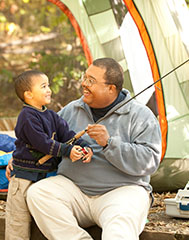
Have fun outdoors by camping!
Hey Dad, can you canoe? Si, se puede! Hey, Mom, can you catch a fish, or pitch a tent and camp in the woods? Yes, you can. Even if you’ve never touched a paddle, baited a hook, or slept anywhere without a solid roof over your head, you can become an outdoors hero to your kids through a program offered by the Minnesota Department of Natural Resources. The DNR’s “I Can!” program provides hands-on training that will give you the know-how you need to enjoy a variety of outdoor activities that are fun, low-cost and family friendly.
The “I Can!” program started in 2010 to address one of the main barriers preventing more people from getting out to enjoy nature through activities such as camping, fishing and canoeing: a lack of skills and knowledge about how to do those things. That first season, 582 people spent a night or two at a state park learning how to start a campfire, pitch a tent and other basic skills through the “I Can Camp” program. In 2011 and 2012, DNR added program components focused on other outdoor recreational skills:
• “I Can Paddle!” teaches participants how to safely handle a canoe or a kayak;
• “I Can Fish!” covers the basics of angling: what kind of equipment to use, how to use
it, fish identification, etc.;
• “I Can Climb!” provides opportunities to try rock climbing;
• “I Can Mountain Bike!” gets participants out enjoying trails on two wheels;
• “Archery in the Parks” gives you a chance to shoot a bow and arrow.
DNR Parks and Trails provides all the equipment needed for these programs, and experienced staff offer training and assistance. With the exception of “Archery in the Parks,” the programs require advance registration and charge a small fee for participation. People are encouraged to sign up early, as some programs, especially those at highly popular parks and those near the metro region, can fill up quickly.
“Anyone who’s wanted to learn outdoor skills, but hasn’t felt comfortable, they should sign up,” says program coordinator Eric Pelto. “They’ll learn the skills they need so they can come back and do it on their own.”
For more information including program dates, times, locations, and minimum age requirements—visit www.mndnr.gov/ican, or contact the DNR Information Center at info.dnr@state.mn.us or 888-646-6367 (8 a.m.-8 p.m. Monday through Friday; 9 a.m.-1 p.m. Saturday). To register for a program, visit www.mndnr.gov/reservations, or call 866-857-2757 between 8 a.m. and 8 p.m. daily (except holidays).
The “I Can!” series of introductory programs is made possible by the Parks and Trails Fund, created after voters in 2008 approved the Clean Water, Land and Legacy Amendment to the Minnesota Constitution. That amendment dedicates a portion of sales taxes to parks and trails of regional or statewide significance. More than 12,800 people have participated in these programs since they were first offered in 2010.
By Harland Hiemstra (DNR)
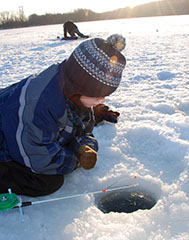
Ice fishing at Fort Snelling State Park
February may be the shortest month of the year, but here in Minnesota, it can seem like the longest, with cold and snow dragging on and spring still weeks away. So, what’s the best cure for the winter blues? Get out and meet the season head-on.
Go ice-fishing!
With warm clothes and a little basic gear, you can enjoy some good outdoors family fun -- and likely catch a mess of fish for the supper table. You can fish in places you might not normally be able to get to. And it’s a chance to walk on water without drawing upon any super-powers.
“If you don’t have a boat, ice-fishing provides a great opportunity to fish waters you wouldn’t be able to reach during the warmer months,” says Jon Hansen, with the Minnesota Department of Natural Resources’ FiN program. FiN (Fishing in the Neighborhood) provides close-to-home angling opportunities around the Twin Cities.
You don’t need fancy equipment to go ice-fishing. Many people use a special short fishing rod with a spinning reel and lightweight line. Attach a tiny weighted jig and bait the hook with what are called “waxworms,” little worms that are the larval stage of insects (disgusting to us, tasty to fish). Go into any bait shop, and you can probably get a basic set-up for $20 or less. Some big-box discount department stores also carry inexpensive ice fishing gear. You’ll also need some way to make a hole in the ice. Hand augers can be found for about $50. Or you can find a lake where others are fishing and fish in an unused hole that someone else drilled. Fishing around others is also a good way to know that the ice you’re on is strong and safe and where the fish might be. Check www.mndnr.gov for more ice safety guidelines.
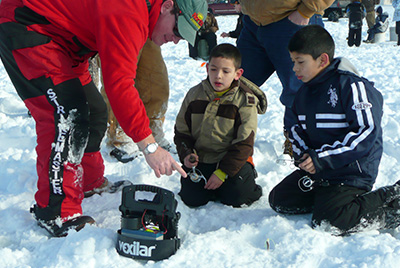 Ice fishing at Pleasant Lake near St. Cloud
Ice fishing at Pleasant Lake near St. Cloud
There are many excellent places to try ice fishing around the Twin Cities. The FiN program manages more than 60 metro lakes offering fun and easy fishing opportunities. If you go fishing in a Minnesota State Park, you can fish without a license. Otherwise, anyone 16 years or older will need a fishing license. Snelling Lake in Fort Snelling State Park (near the airport and the Mall of America) is a great place to catch fish through the ice, as is Lake Alice in William O’Brien State Park just north of Stillwater.
“Ice fishing is great to do with the kids,” says DNR’s Hansen. “On many of these lakes, with just a simple set-up, you’ll be catching bluegills till your arm gets tired.”
Go to www.mndnr.gov and search “ice fishing” for more information about where to go and how to do it. It might be the most fun you’ll have until Spring!
By award-winning author and chef Amalia Moreno-Damgaard (AmaliaLLC.com)
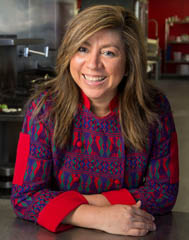
Every time I need to come up with a delicious yet quick appetizer menu, I resort to the flavors that I truly enjoy. Then I decide on balance, proteins versus vegetables and fruits. But most importantly, I take into consideration the needs of my guests.
When planning a festive menu, there are no rules, but planning is key. It may take a couple of revisions of the original menu to get you to the point where you are comfortable with what you will be serving during your event. To be successful, include foods that appeal to a variety of tastes, including vegan, vegetarian, gluten free, plus other fare that targets the special requirements of some guests.
When deciding on flavors, think of sauces, herbs and chiles, and other key elements that will add pizzazz to every item on the table. Also, consider proteins that take little time to cook, or that are purchased already cooked and can be easily combined with other ingredients to elevate them to a higher status. Sweets, such as fruits and chocolate desserts, are classics during the holidays.
Five or six heavy appetizers might be enough for a reception held during business hours. To make a heavier meal out of small bites, then either modify your existing menu to include more proteins, or extend it by adding heavier bites, such as mini sandwiches or miniature tacos filled with animal and vegetable proteins.
For tighter budget menus, choose chicken and cheese as your base animal proteins, and complement them with vegetable proteins such as garbanzo beans, lentils, black beans and others that can be easily puréed and made into a dip, or used a base as a spread to build a heartier appetizer. Garnishes are the cherry on top of the cake. While they are not a requirement, they add eye appeal and style to the final product.
Below is a quick yet delicious appetizer made in a matter of minutes. It wasn’t a last minute decision item, but rather one key piece of the planned menu for a party that I hosted recently. Use it as is, or modify it according to your taste and make yours!
I wish you the very best holiday season in harmony with your family, close friends, and relatives. May the New Year bring you peace, happiness and prosperity.
Shrimp with Attitude
By Chef Amalia Moreno-Damgaard
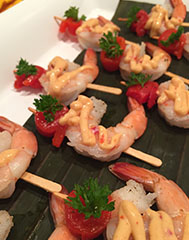
Serves 4
12 medium shrimp, cooked, deveined, tails on
Lime juice + Tabasco + Kosher salt and pepper
Toothpicks or tiny skewers
Roasted jarred pimientos, cut into 1-1/2-inch-long strips
Parsley sprigs
½ cup chipotle mayonnaise + lemon juice + chopped cilantro
Brush the shrimp with lime juice, add tabasco to taste, and finish with a light sprinkling of salt and freshly ground black pepper. Skewer the shrimp. Roll the pimiento strips and secure them with the toothpick and the shrimp.
Arrange the shrimp attractively on a platter. Put one sprig of parsley in the center of each pimiento roll.
In a small bowl, combine the mayonnaise with the lemon juice and cilantro to taste. Add more heat with tabasco, if desired. Pipe the sauce on top of the shrimp.
By award-winning author and chef Amalia Moreno-Damgaard (AmaliaLLC.com)
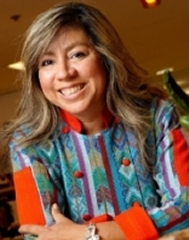
Every time the holiday season is near I have a conflict of sorts. Do I go in the American or Latin direction, or both? This is how fusion begins for me.
When we are young we grow accustomed to what our elders do. Our brains are sponges that absorb and record everything that comes back to haunt or delight us later in life. Our taste buds are shaped by the flavors and eating habits we are exposed to early on. Whether we like it or not, these traits are hard to break.
When I think of food, I navigate a multicultural landscape of flavors. This I discovered later in life. Living in a diverse country there is no way to avoid this. I like it. It makes me think outside the box and then I realize that I am not alone in this space. Many immigrants may feel this way.
The good news is that that my deeply ingrained background always comes to the forefront at menu planning time. So the decision of what to eat for a particular celebration is automatically decided by what foods evoke feelings of hominess and wellbeing. My menus tend to be a combination of what I truly enjoy paired with components from other culture’s flavors that I am fond of.
Growth in the food space happens out of need to explore and create something that comes from within. Like art. Food indeed is an art form. This is the reason that the same recipe varies from maker to creator. Taste, color, and flavor enhance the cultural canvas furthermore.
Thanksgiving is an acquired holiday for me. I enjoy the feast and what it represents. The menu has commonalities with the Latin diet. Turkey, squash, and potatoes are all native to the Americas and they occupy a special place in many homes which adapt them to their ways and eating styles.
This holiday season I encourage you to venture a bit out of the traditional menu and explore complementary flavors that can add some spice at the table such as pairing the pumpkin pie with a cup of Latin hot chocolate. You will be in for a treat!
Happy Thanksgiving!
CHOCOLATE
Guatemalan Hot Chocolate with Chantilly Rum Cream
By Chef Amalia Moreno-Damgaard
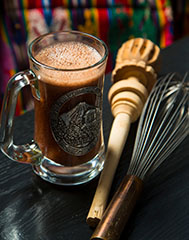
Traditional Guatemalan hot chocolate is thick and foamy. The froth is achieved by stirring the chocolate in a deep ceramic pitcher or a deep pot with a molinillo (a special wooden whisk). The flavor and texture of Guatemalan chocolate are best appreciated when you make this recipe with hot water. This is the traditional method. However, children and some adults may prefer to make it with milk. Chantilly rum cream is not a traditional garnish, but it adds another layer of flavor and eye appeal to the drink.
Serves 2 people
6 to 8 ounces Guatemalan chocolate (3/4 to 1 cup of chocolate)
2 cups hot water or hot milk
Adorno (Garnish)
Chantilly rum cream (optional)
Ground canela (Ceylon cinnamon) (optional)
Combine the chocolate and hot water in a heat-resistant ceramic pitcher, deep pot, or saucepan. Whisk vigorously with a molinillo to dissolve the chocolate, holding the molinillo between your palms and rotating it back and forth quickly. Once the chocolate is dissolved, continue whisking until the mixture is thick and frothy (about 5 minutes). Alternatively, you can use a stainless steel whisk in place of a molinillo.
Serve the hot chocolate in cups, garnished with Chantilly rum cream and ground cinnamon.
Amalia's Notes
Buy Guatemalan or Mexican chocolate at Latin grocery stores in the Twin Cities area.
Guatemalan chocolate comes in different shapes and sizes (thin rounds, long thick tablets, and short thick tablets), depending on the brand. The chocolate is very hard (and sweet) and must be broken for measuring. To break the chocolate, put it in double ziplock bags, wrap it twice in a kitchen towel, and pound it with the smooth side of a metal meat mallet until the chocolate is almost powdery. Then transfer it to a measuring cup and measure the desired amount.
To make Chantilly rum cream: Whip 1/2 cup of heavy whipping cream (at room temperature) until firm peaks form (2 to 4 minutes). Add 2 teaspoons of confectioners’ sugar, 1/2 teaspoon vanilla extract, 1/2 teaspoon almond extract, and 1/2 tablespoon dark rum, and whip to combine (about 1 minute).
By award-winning author and chef Amalia Moreno-Damgaard (AmaliaLLC.com)

If you find yourself scrambling for healthy meals during busy weekdays, you are not alone. Many people resort to convenience and as long as you choose wisely, store bought meals can alleviate your daily routine. Having a plan can ease your mind and pocket too.
When I established my kitchen routine some time ago, I decided to cook meals for two or three days on Mondays. We eat that meal on Monday evening and then on Tuesday, depending on leftovers, I build a different meal adding a fresh vegetable dish or side salad. Sometimes I’d cook two proteins, one starch and one vegetable dish and we would eat one of the proteins on day one and the second protein on day two.
Simple menus allow you to accomplish more in less time and to do healthier meals in the process. Think balance, freshness, lean meats, lots of vegetables, rice dishes, or potatoes. What I like about balancing meals is that I can do individual dishes or one-dish meals, such as rice and beans sometimes complemented by additional vegetables or plantains. An easy to do menu can be thin, fat-trimmed pork chops cooked on the stove top paired with sautéed potatoes with bell peppers and onions accompanied by a vegetable salad. Legumes (garbanzo or beans) can be the base for a delicious stew with a combination of chicken, pork, and beef served with a simple cucumber and onion salad with lime vinaigrette.
I am a fan of roasted chickens sold at most grocery chains because they lend themselves to a variety of preparations. One of my favorites is chicken picadillo, which contains a sofrito (onion and tomato fried sauce) base plus a variety of vegetables of choice cut into small pieces. This dish can be the main protein on the plate, or can be a filler for tacos topped with lettuce and tomatoes.
Potatoes can also serve as the base for a meal either for lunch or dinner. Think baked potatoes stuffed with either chicken picadillo or with ground turkey prepared as a base for taco salad and complemented with chopped onions, tomatoes, lettuce, shredded cheese, and hot salsa. Potato hash prepared with left over meats and vegetables and served with a sunny side egg on top is another casual and delicious dinner.
When planning meals, think outside the box in terms of components and how you can make a balanced meal out of them. Chances are that any creation you come up with at the last minute based on what you have on your refrigerator plus a new dish will be well received by hungry mouths who long for home-style meals and a cozy family time.
Papas con Cebolla y Chiles Pimientos
Sautéed Potatoes with Bell Peppers and Onions
By Chef Amalia Moreno-Damgaard
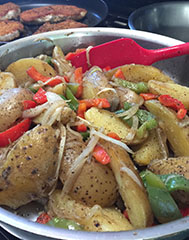
Serves 2-4
1 avocado, pitted, in cubes
4 boiled Yukon gold potaoes in quarters (wedges)
2 tbsp olive oil
1 red bell pepper, in strips
1 green bell pepper in strips
2 medium yellow onions thick julienne
Kosher salt and freshly ground black pepper to taste
Spices: ½ tsp. thyme, ½ tsp. paprika or Spanish pimentón, ½ tsp oregano
Sauté the red and green bell peppers and the onion in the oil and season with salt and pepper and the spices. Cook until the onion is translucent, about 2 minutes.
Add the potato potato wedges and combine with a rubber spatula using folding strokes to keep the potatoes whole. Sauté for 3 minutes making sure the potatoes are well coated with the oil and spices.
Serve immediately.
About Amalia
Amalia Moreno-Damgaard is an award-winning author and chef born and raised in Guatemala City with a prior career in international banking. Amalia creates awareness about Latin culture’s nuances and educates individuals and companies through consulting, bilingual speaking and writing, and healthy culinary experiences. Her book Amalia’s Guatemalan Kitchen-Gourmet cuisine with a Cultural Flair is a nine-time award winner and best seller. Learn more about Amalia and her upcoming events at AmaliaLLC.com.

PLOMO, un elemento tan común pero tan peligroso. El plomo esta en nuestras casas, en la tierra, en el aire, jugetes, platos, jarras, joyas y en muchas cosas mas. Es difícil evitar contacto con plomo en la vida diario.
¿Por que estamos preocupados por el plomo en nuestos ambientes? Porque plomo hace daño irreversible a los niños. Les causa daños al cerebro que son para siempre.
La pintura en casas construidas antes de 1978 contiene plomo. Pintura a base de plomo es el fuente principal del envenenamiento por plomo. Pintura que esta deteriorando, descarapelando, cayendo o que está siendo lijado o quitado con máquinas es toxico.
Cuando los niños tienen plomo en la sangre puede afectar casi todos los sistemas del cuerpo. Puede causar discapacidades de aprendizaje, problemas de conducta y en niveles muy altos, convulsiones, coma e incluso la muerte. Es importante recordar que los niños pequeños absorben el plomo con mucha más facilidad y rapidez que los adultos y los daños son para siempre.
Hay recursos gratis y bilingues en la comunidad que puede ayudar a usted y su familia identificar si hay plomo en su hogar. CLEARCorps es una agencia comunitaria que ofrece muchos servicios para que las familias pueden vivir sanas y salvas en sus hogares.
Contáctanos al 651-603-8000 o por email a megan@clearcorps.org para programar la visita. ¡Todas familias merecen un hogar libre de plomo!
By award-winning author and chef Amalia Moreno-Damgaard
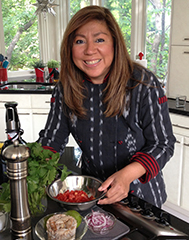
Summertime is for having fun in the sun in the company of family and friends enjoying delicious foods.
Every summer I look forward to the endless possibilities of preparing the season’s harvest quickly and easily using herbs and spices to enhance the flavor of grilled meats and vegetables. One advantage of cooking outdoors is that the whole experience can happen on your deck or at the picnic table making cleanup easier.
In many countries and in the United States people venture outside as soon as the weather is pleasant and look for parks with gathering spaces with grills and benches to celebrate birthdays and other special events. This is such a great way to connect with nature in a wholesome and inexpensive way.
When was the last time you and your family organized a family reunion in a pot luck fashion? What a great opportunity to enjoy a variety of foods under the sun! Minnesota has many picturesque places and lakes to enjoy the warm weather which can be conducive to turn a party into a fiesta. Think food, cool drinks, music, and dance.
Marinating chicken, meats, and other proteins is a time saver and a flavor booster. For best results, immerse your proteins in a Ziploc bag with plenty of the sauce you are using and marinate in the refrigerator for 2-3 days. Then complement your menu with grilled corn, grilled vegetables dressed with herbs and lemon juice, leafy greens salads, and light fruit desserts.
I can’t think of a healthier way to embrace nature! Below is a recipe to get you started.
Ensalada Al Flash
By Chef Amalia Moreno-Damgaard
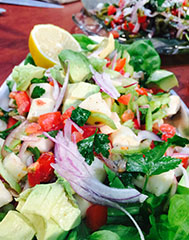
Serves 4
1 avocado, pitted, in cubes
1 vine ripened tomato, diced
1 head of romaine, torn into small pieces
½ cup shaved red onion
1 bunch parsley leaves, roughly chopped
Dressing: the juice of 2 lemons (or limes), 2 tbsp olive oil, salt and pepper
Prepare the vegetables and combine in a bowl.
Toss with the dressing right before serving.
About Amalia Moreno-Damgaard Amalia creates awareness and educates about Latin cultural nuances through consulting, bilingual speaking and writing, and fun healthy culinary experiences. Learn More at AmaliaLLC.com.
By award-winning author and chef Amalia Moreno-Damgaard

Our food attitude determines who we are, literally.
Every time a new diet comes around, I think about the bounty the Latin diet has to offer. In it there are plenty of choices for everyone, from people with food intolerances and allergies and aversions and vegetarians, to others observing special diets due to illness or to achieve weight loss.
Latin (and many world cuisines) food is ancient. Before colonization, there were cuisines that already existed which happened out of need while taking advantage of the gifts of the land. These foods were rustic and wholesome in nature and embraced what the times and mother earth offered. Fusion continues to transform gastronomy globally and higher awareness about the potential benefits of food and trends suggest that we make smarter food choices while statistics persistently show chronic disease.
One thing is certain, fresh, unprocessed, and wholesome food will always be in vogue, no matter what the new wave or trend is, and eating healthy will reign for eternity. Changing behaviors is the challenge. Finding the right approach is essential. Tweaking one’s diet toward adopting a healthier lifestyle is easier than adopting a whole new way of life. Cultural traits are deeply ingrained within communities and a cultural-relevant strategy might be the key.
Here is a recipe to bring awareness to your existing diet. It highlights wholesome ingredients to heighten flavor (fresh herbs, vegetable variety, and vinegar), a good-for-you oil, and a healthy cooking method.
¡Buen provecho!
RELLENO DE POLLO
Chicken and Vegetable Stuffing
Recipe by Chef Amalia Moreno-Damgaard (AmaliaLLC.com)
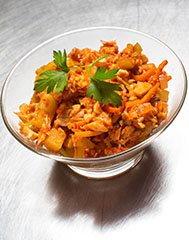
Relleno (also called picadillo) means “filling,” “stuffing,” or “hash” in Latin America. This delicious dish can be used for stuffing chicken or turkey or as a stuffing for empanadas, rolled crispy tacos, chiles rellenos, or sandwiches. Or eat it as a side dish with corn tortillas, rice, and beans. Relleno can be made with beef, pork or turkey, and with varying vegetables. Substitute the meat with cooked garbanzo beans or lentils for a tasty vegetarian dish.
1 cup finely diced yellow onions
2 teaspoons finely chopped fresh thyme leaves (or 1 teaspoon dry thyme)
2 fresh bay leaves
2 tablespoons canola oil
3/4 cup julienned green beans
3/4 cup julienned carrots
3/4 cup finely diced potatoes
2 teaspoons minced fresh garlic
1 cup canned crushed tomatoes
1 tablespoon plus 2 teaspoons champagne vinegar or white wine vinegar
1 teaspoon kosher salt
Freshly ground black pepper
4 cups chopped skinless store-bought rotisserie chicken
In a large skillet over medium heat, sauté the onions, thyme, and bay leaves in the oil for about 2 minutes. Add the green beans, carrots, and potatoes and sauté until aromatic, about 5 minutes. Add the garlic, tomatoes, and vinegar, and sauté 3 minutes. Season with salt and pepper.
Add the chicken, stir well to combine all ingredients, and sauté 3 minutes. Adjust the heat to low and continue to cook the chicken and vegetable mixture uncovered, stirring from time to time, until the vegetables are tender and all liquid has evaporated (10 to 15 minutes). Taste and adjust seasonings, if needed.
Serve immediately with warm corn tortillas. If you’re using the mixture for stuffing, let it cool completely.
About Amalia Moreno-Damgaard Amalia creates awareness and educates about Latin cultural nuances through consulting, bilingual speaking and writing, and fun healthy culinary experiences. Learn More at AmaliaLLC.com.
By award-winning author and chef Amalia Moreno-Damgaard

Did you know that one of the best ways to encourage kids to eat healthier is to include them during meal preparation?
When my son was born, my priorities as a woman changed immediately. As a young mother, I was ready for my new role and when it came time to start feeding him real food, memories of my mother raising my younger brother came into mind. Instead of buying jarred foods, she puréed from vegetables and fruits, to home-cooked meals. A good way to prepare young taste buds for later.
In a culture where farmers market shopping is almost a daily routine, crafting food for all meal times is common practice. Today’s artisan dishes, were meals made at home then, so it is no surprise that I grew up enjoying and making my food at home along with my own family.
One of the best ways to spend quality time with the family, is to involve them in the kitchen. From the very beginning I fed my son what the adults ate. The notion of preparing a separate meal for him never crossed my mind because of my upbringing. My son had a plastic serrated knife and his own cutting board as a child and as he grew older and matured, he earned the right to own a junior chef knife.
The rewards today of our time cooking are manifold, from his ability to recognize ingredients and follow and execute a recipe, to recognizing what is and is not good for good health. As a teenager, I trust my son to shop at the grocery store on my behalf. This helps me so much when our schedules are hectic and don’t have time to stop at the grocery store. and I am confident that this exposure to the kitchen in his early years will benefit him when he goes to college and beyond!
It never is too late to start!
Here is a recipe perfect for kids and adults. It is easy, healthy and delicious!
Recipe by Chef Amalia Moreno-Damgaard (AmaliaLLC.com)
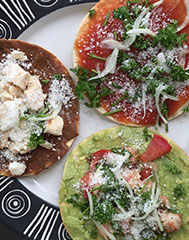 Serves 2
Serves 2
4 corn tortillas, baked in a toaster oven until crispy (about 3-5 minutes, keeping a close eye as they can burn easily)
The pulp of one avocado
The juice of ½ lime
2 Roma tomatoes
½ yellow onion roughly chopped
½ tsp minced garlic
¼ cup water
A pinch of oregano and a pinch of thyme
Salt to taste
1 tbsp. canola oil
½ cup chopped onion
2 garlic cloves, minced
1 can whole beans
Garnishes: 1 cup rotisserie chicken, cotija cheese, onion slices, chopped parsley
Mash the avocados with the lime and salt. Set aside.
Make the sauce by combining the tomatoes, onion, garlic, water, spices and salt to taste in a small sauce pan. Bring to a quick boil, reduce the heat, and simmer until all the vegetables are tender (3-5 minutes). Purée in a blender.
Make the bean puree by pan frying the onion until medium brown. Add the garlic and beans and cook for 5 minutes. Puree in a blender until smooth.
Assemble the tostadas: Use either, the avocado mash, sauce, or bean purée as a base, and then garnish.
Buen provecho!
About Amalia Moreno-Damgaard Amalia creates awareness and educates about Latin cultural nuances through consulting, bilingual speaking and writing, and fun healthy culinary experiences. Learn More at AmaliaLLC.com.
By award-winning author and chef Amalia Moreno-Damgaard

Companies reinvent products and people reinvent themselves so why not reinvent Easter?
Traditions and celebrations come and go year after year and people seldom change anything because they simply don’t take the time to think about it, or they just don’t want to disrupt customary practices. Repetitive work is tedious to me so I constantly look for ways of doing the same task in a different way.
Easter is such a special time of year so I look forward to eating a special meal after 40 days of observing special diets every Friday. For takers, the usual ham and trimmings can be substituted for a Latin-style fresh ham or tenderloin (recipe below) and sides that are delicious, healthy, and easy to make. Less is more. A menu of four dishes is more appealing to people doing the cooking than a wide array of dishes.
The benefit of cooking from scratch versus eating processed foods is priceless from an economic and health standpoint. It may take the same amount of time and effort to prepare a home-style meal than one with mixed processed and fresh components. In the short and long run, what we cook with fresh ingredients usually ends up having less calories and more nutrition, and it tastes better too.
So I invite you to rethink your menu this Easter and try something new. Below is a recipe to get you started.
Happy Easter!
LOMITO ADOBADO
Pork Tenderloin marinated in grilled guajillo, achiote,
and tomatillo sauce
Recipe by Chef Amalia Moreno-Damgaard (AmaliaLLC.com)
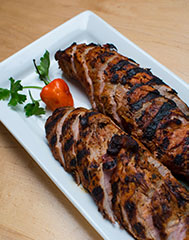 Keep it simple. Accompany this meal with a zesty guacamole, roasted potatoes and a salad made with freshly made vinaigrette.
Keep it simple. Accompany this meal with a zesty guacamole, roasted potatoes and a salad made with freshly made vinaigrette.
Serves 4-6 people
1 batch adobo sauce (recipe below) 2 pork tenderloins (1 lb. each) or 2-1/2 lbs. boneless country style-pork ribs
Prepare the adobo. Marinate the pork in the sauce in a ziplock bag overnight or up to 3 days.
Preheat the grill. Grill the pork over natural charcoal to an internal temperature of 135F (15-20) minutes. During grilling time, turn the pork every 2 to 3 minutes until it’s evenly brown.
Rest the pork tented with a piece of foil for 5-10 minutes to help it reach an internal temperature of 145F. Slice the tenderloins on the diagonal and serve.
Adobo Sauce: ½ cup chopped tomatillos; 1 cup chopped tomatoes; 1 of each chiles: guajillo and ancho deveined and torn into pieces; ¼ cup water; 1/3 cup chopped yellow onion; 1 tbsp garlic; ¼ tsp oregano; ¼ tsp. cumin; 1/8 tsp. ground cloves; 1/8 tsp. ground canela (cinnamon); ¼ tsp ground achiote; 1 tsbsp+1 tsp white wine vinegar; 1 tbsp canola oil; 1 tsp Kosher salt; freshly ground black pepper.
Cook the tomatillos, tomatoes, and chiles in the water until soft (about 5 minutes). Let cool.
Put the mixture with the remaining ingredients in a blender and puree to a fine consistency. The sauce should be thick and pasty so it will stick to the meat. Taste.
About Amalia Moreno-Damgaard Amalia creates awareness and educates about Latin cultural nuances through consulting, bilingual speaking and writing, and fun healthy culinary experiences. Learn More at AmaliaLLC.com.
By Carlos Santiago, Santiago Solutions Group

Multicultural segments continue to lag significantly behind the enrollment rate of the White Non-Hispanic segment, less than 100 days away from the third Open Enrollment period despite so much additional effort put behind Hispanic, African American and Millennial efforts. What can we as Marketers learn from this?
A deep analysis into each segment reveals a much more concerning reality. Hispanics are trailing much further behind than any other group despite all the additional resources that went specifically behind that group in the last open enrollment. While Hispanics make about 15 percent of those enrolled, they are about a quarter of those eligible, net of undocumented in FPL 139-400 —an index of only 63, that is equivalent to 37 percent below where the segment should be given its proportion of exchange eligibles. Similarly, the African American segment shows an index of 84 or 16 below where it should be. It is the Asian/Other segment that skews the Multicultural trends with an index of 241 or 141% above where it should be given that it only represents 5 percent of eligibles versus 11 percent of those enrolled so far.
On the eve of the third open enrollment period, the national trends clearly suggest that there are major barriers still standing in front of Hispanic and African American eligibles. There appear to be five major factors at play:
Lack of Trust in the Government: Mixed status families don’t want to risk exposing immigration status of certain members to official entities, preferring to remain without insurance.
Poor value: Deductibles for current plans under the affordable care are far from affordable for many. The plans are still above what many middle-income families can afford relative to their income and other living expenses. Many of them choose to continue to pay-as-they go using urgent care/community clinics, gladly paying the tax penalty. Introduction of cheaper plans is critical to engagement.
Ineffective Messaging: Two-fold messaging problem.
1. Mass media messaging is over-promising and reality is under-delivering.
2. Insurance ‘fine print’ is too complex to easily understand and clearly evaluate.
Both result in negative word-of-mouth and skepticism, with many consumers not even bothering to seek official information in-person or digitally.
Poor Culture & Language Relevancy: While exchange communications and messages from the government and insurers have improved, they are mostly translations or adaptations of communications intended for audiences with high levels of health care and health literacy. For the most part, Hispanic-nuanced messages, addressing specific barriers and the most effective triggers to adoption, have not evolved and been brought to the forefront.
Lackluster Customer Experience: The customer experience of those newly enrolled is rampant with stories of poor on-boarding, repeated incorrect bills, systems that don’t reflect conversations with customer service, physicians not in the promised network, communications that are very difficult to understand, inconsistency of in-language communications, and very mixed experiences with call-centers. These unsatisfactory experiences are surpassing the exceedingly good ones in community and digital circles of influence, keeping the undecided eligibles at bay.
At the end of the day, half of the remaining exchange eligibles in these states are Multicultural and 1 in 3 of the overall remaining eligibles (net of undocumented) are Hispanic. This source of growth will add critical pressure to getting multicultural engagement, acquisitions and retention properly focused on the needs of this vast potential.
About Santiago Solutions Group (SSG): SSG guides clients to identify the highest ROI opportunities, simplify business decision-making through advanced analytics & insights, and craft effective marketing strategies that advance sustainable total growth fueled by Millennial, Multicultural & Hispanic segments.
Sources: SSG analysis of the Department of Health and Human Services reported enrollment in Federal Facilitated States from Nov 15, 2014 until Feb 22, 2015 special enrollment extension, the Family Kaiser Foundation, Estimated Number of Potential 2015 Marketplace Enrollees, applying eligibility by income and household size, by race, and geography from the US Census and Nielsen-Scarborough 2012-2015. Many of the largest multicultural states in the country, representing 80 percent of the country’s population (including Arizona, California, Florida, Georgia, Illinois, Nevada, New Jersey, North Carolina, Pennsylvania, Texas, and Virginia) were among the 38 states reporting detailed data indicating the ethnicity of those newly enrolled and renewed in exchange Qualified Health Plans. Included amongst these are all the Federally-facilitated marketplaces and state-partnership and most of the state-based marketplaces with notable exceptions like New York, Connecticut and District of Columbia.
By Award-winning Author and Chef Amalia Moreno-Damgaard

Celebrating the holidays with family and friends should be a motive to celebrate, not to stress out.
Life in the United States seems more rushed than in Latin America, however, the holiday season adds a higher level of stress to everyone’s lives. One easy way to manage a busy schedule and have a good time doing it is by writing a weekly checklist to achieve one or two major activities per day. This short checklist routine can make you feel more at ease because as you cross over items, you achieve a sense of accomplishment and transfer any leftover items to the following week.
I write separate checklists for everything that requires time and significant effort and time, from business and house chores to kitchen tasks. Checklists allow me to stay organized and focused on what is important and I definitely feel more relaxed. With family visiting from out of the country over the holidays, I need to stay vigilant on taking care of their needs and at the same time keep my eye on the Christmas celebration menu.
You can too take advantage of the calming effect of checklist, not only during the holidays, but as a fun life management tool.
Happy Holidays!

TIPS FOR AN EASY HOLIDAY MENU Find recipes at AmaliaLLC.com
1. Choose the protein of your choice (turkey, ham, or pork roast).
2. Select two easy sides (vegetables and a starch).
3. Make a simple festive salad.
4. Buy fruit to complement ice cream or your favorite cake.
5. Find a good value wine at a liquor store and buy a non alcoholic-sparkling wine for children at the grocery store.
AMALIA’S UPCOMING EVENTS (View more events at AmaliaLLC.com)
Holiday Kitchen Delights
December 8 @ 7:00 pm - 9:00 pm
Nordic Ware Factory Store
4925 Highway 7
St. Louis Park, MN 55416
Get fired up, it’s the holiday season, a time to celebrate and enjoy great food from around Latin America and elsewhere crafted by award-winning chef and author Amalia Moreno-Damgaard. These delightful appetizers can be the stars of your special gathering. Indulge in Fire Roasted Chiles Stuffed With Bison Picadillo, Spicy Shrimp Cognac Flambé Fondue, Latin Chocolate Crepes with Dulce de Leche and more!
Register: 952-924-9672.
By Award-winning Author and Chef Amalia Moreno-Damgaard

Being thankful year-round, rather than just during Thanksgiving, can be beneficial to your health and those around you.
In this age of rushed lives, we become so immersed in day-to-day activities that we rarely stop to think about how we can make our life quality better. Everyone at some time reaches a point of frustration, helplessness, and despair, and this is compounded by work and life demands. Having an escape is good and whether you are religious or not, adopting the practice of being thankful is better than living in anguish.
Thanksgiving is good for many reasons, —to reflect on the meaning of the celebration, family time and eating delicious traditional foods, but it is also a good time to ask ourselves if we are at peace and happy. As simple as this sounds, these have always been precious jewels in people’s lives and as such how many of us actually experience these states that naturally go hand in hand?I want to leave you with this thought, —next time you experience ill feelings about anything, wouldn’t it be nicer to redirect your thinking into a state of gratitude? When was the last time you reflected about your life’s blessings?
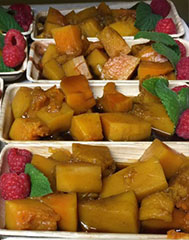
AYOTE EN DULCE
Receta creada por la chef Amalia Moreno-Damgaard
Esta es una receta tradicional para el Dia de Los Muertos, pero también puede ser una buena opción para el Dia de Acción de Gracias dado a que el ayote es también parte de la celebración.
Para 2 personas
Miel
2 tazas de agua
1/4 raja de canela
1/8 cdita. anis
2 clavos
3 pimienta gorda (dulce)
3/4 a 1 taza de panela (piloncillo)
1 ayote pequeño como el acorn (o cualquier otro ayote de su gusto), lavado, cortado en cuartos (piel y semillas incluidas)
En una olla mediana, combine el agua con las especias y la panela y sirva rapidamente. Luego baje la llama y cocine lentamente hasta que los sabores se concentren y la mezcla este aromática y se vea como miel (unos 20-30 minutos). Quite las especias y tírelas.
Agregue el ayote y sumerja en la miel, y cocine hasta que este suave (unos 20 minutos). Mientras mas tiempo este el ayote en la miel, mejor sabor. Por esta razón es mejor prepararlo el día anterior.
Sirva a temperatura ambiente o frio bañado con la miel.
AMALIA’S UPCOMING NOVEMBER EVENTS (View more events at AmaliaLLC.com)
Girls Dare To – a Guatemalan Benefit
November 5 @ 5:00 pm - 8:00 pm
Summit Brewing Company, 910 Montreal Circle
Join us for Beer ‘N Bites to benefit “Girls Dare To” of Guatemala by Asociacion Mujer Atrevete, a fundraiser for Guatemalan youth afflicted by social issues. This event is open to the public, but requires registration.
More information: pbutters@aol.com
Wine, Women and Wishes
November 5 @ 6:00 pm - 9:00 pm
Warners Stellian, 3533 W 70th St
Edina, MN 55435
An elegant evening for women featuring light bites and wine. Start on your holiday shopping and get great every day gift ideas while enjoying a variety of food, beverages and entertainment and supporting wishes.
Holiday Kitchen Delights
December 8 @ 7:00 pm - 9:00 pm
Nordic Ware Factory Store, 4925 Highway 7
Minneapolis, MN 55416
Get fired up, it’s the holiday season, a time to celebrate and enjoy great food from around Latin America and elsewhere crafted by award-winning chef and author Amalia Moreno-Damgaard. These delightful appetizers can be the stars of your special gathering. Indulge in Fire Roasted Chiles Stuffed With Bison Picadillo, Spicy Shrimp Cognac Flambe Fondue, Latin Chocolate Crepes with Dulce de Leche and more!
By Award-winning Author and Chef Amalia Moreno-Damgaard

A great way to celebrate Hispanic Heritage Month (or any occasion) is through the versatile and delicious tortilla. The corn tortilla dates back to pre-Columbian times and continues to make history as it passes from generation to generation.
As the bread of the southern region of North America (Mexico, Guatemala, and other Central American countries), it is a unifying force that feeds millions providing not only a high nutritional value, but great texture and flavor along the way. Tortillas are easy to make using a modern special tool, yet traditionally they are the work of art of expert hands that pat a ball of dough between their palms with such precision until it reaches just the right size and thickness.
The tortilla’s versatility transcends recipes and cooking styles, lending itself not only as a meal complement, but as a base for building a delicious dish and as a conduit for thickening soups and stews, and as a tasty crunch for casual foods. Whether you enjoy a scrumptious taco bursting with all kinds of delicious toppings, or a flauta filled with savory stuffing and topped with spicy sauce, you are always in for a treat with this special food that is so common yet so special for many. For Latins, the tortilla is an important flavor that brings memories of happy times with friends, family and home.
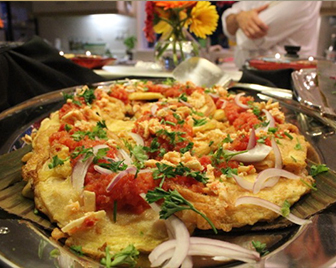
CHILAQUILAS DE QUESO FRESCO CON SALSA DE TOMATE
Fresh Cheese–Stuffed Corn Tortilla Pockets with Tomato Sauce
Recipes by Chef Amalia Moreno-Damgaard
Serves 2
Chilaquilas (not to be confused with chilaquiles) are a delicious and easy-to-make treat. They consist of stuffed corn tortillas dipped in egg batter and then panfried and topped with tomato sauce. You can make chilaquilas with leftover ingredients, roasted pork, or another tasty filling of your choice. You can also make them with güisquil (chayote squash) in place of tortillas.
Makes 6 chilaquilas
Salsa de Tomate (Tomato Sauce)
1 tablespoon canola oil
2 cups chopped Roma tomatoes
1 cup chopped yellow onion
Kosher salt and freshly ground black pepper
1 cup crumbled queso fresco (fresh Latino cheese)
6 corn tortillas, gently heated to make them flexible
Huevo Batido (Egg Batter)
2 large eggs, separated
1/8 teaspoon kosher salt
1 1/2 tablespoons all-purpose flour
Canola oil
Adorno (Garnish)
Chopped flat-leaf parsley
Put the oil in a hot skillet. Add the tomatoes and onion and season them. Cook until saucy (3 to 5 minutes). Taste and adjust seasonings if necessary.
In a bowl, combine the queso fresco and 3/4 cup of the tomato sauce. Divide the mixture into 6 equal portions. Stuff each tortilla with the mixture. Fold gently in half and set aside.
Beat the egg whites until stiff peaks form. Add the yolks, salt, and flour. Beat 1 minute to make a soft batter.
Top the chilaquilas with the sauce and the chopped parsley.
AMALIA’S UPCOMING EVENTS (View more events at AmaliaLLC.com)
Our Savior’s Lutheran Church for Guatemala
October 11 @ 10:00 am - 12:00 pm
Our Savior’s Lutheran Church, 9185 Lexington Ave N.
Circle Pines, MN 55014
Consecrating (Stewardship) Sunday to benefit Guatemala. The two events (10am and 12pm) feature worship services with a Guatemalan meal after each service. The event is free, but registration is required. Register: 763-784-1971
Stovetop Smoking & More!
October 20 @ 7:00 pm - 9:00 pm
Nordic Ware Factory Store, 4925 Highway 7
Minneapolis, MN 55416
Take a step up from everyday life and embark on new culinary experiences. Award-winning chef and author Amalia Moreno-Damgaard will demonstrate how delicious and easy it is to pre-pare dishes on a stove top smoker and the grill. Enjoy Salmon Ahumado, Smoked Spice-Rubbed Fresh Atlantic Salmon and Spicy Jalapeno Shrimp, Grilled Potatoes with Cotija Cheese, and Grilled Gazpacho Salad with avocado sauce. Register: Nordic Ware Factory Store
Guatemala’s Day of The Dead – Dinner With A Chef Series
October 29 @ 6:30 pm - 8:30 pm
Arboretum at UofM, 3675 Arboretum Dr
Chaska, MN 55318
Friends and families in Guatemala come together every year to prepare and eat Fiambre, an elaborate dish with anywhere between 30 and over 50 ingredients, eaten on All Saints Day. Ex-perience “El Dia de los Muertos” the Guatemalan way with award-winning-bestselling author and chef Amalia Moreno-Damgaard. Amalia loves to share the food and culture of this bizarre celebration and combine it with delicious food and story-telling. On the menu is Amalia’s own Fiambre, Ayote con Dulce, acorn squash in spiced…
By Award-winning Author and Chef Amalia Moreno-Damgaard

Learn about what is new and unique about an old institution that draws communities together from all lifestyles.
During a recent visit to the Minneapolis Farmers Market, I rediscovered a newly energized place where people from all cultures converge to celebrate the fresh bounty of the season. I love fresh delicious meals, especially when made with seasonal ingredients grown nearby. The added bonus is having access to organic ingredients and supporting the local economy.
There is nothing more delicious than a salad or salsa made with vine-ripened tomatoes so I decided to buy all ingredients for dinner that night. I bought luscious Chinese spinach, mint, red beets, cucumbers, baby potatoes, and bison steaks. By the way, bison is at the top of the list in wholesomeness and nutrition of proteins as it is low in fat and higher in vitamins and more delicious than beef because it is grass-fed.
Besides shopping for produce, there is a very nice and reasonably priced flower market. As I strolled through, I came across roasted corn, which I could not resist, -for a short while I felt a state fair ambiance. At lunchtime, I purchased a freshly made grilled brat topped with sautéed onions and peppers, and to quench my thirst, I bought icy freshly squeezed lemonade. As I moved through the crowd in search of a place to sit to enjoy lunch, I encountered a cozy area filled with picnic tables and umbrellas. Despite the scorching heat, people seemed to be having a great time, so I joined an inviting group of friends at their table. As I ate, I watched people go by and realized this is such a very nice place to visit on a Saturday morning. I felt relaxed and reenergized.
When I returned home, I planned my menu around the grill and stove. Some things I would cook at the stove and others at the grill. So my menu looked like this (see picture): Grilled bison steaks topped with grilled chirmol salsa, skin-on baby potatoes drizzled with olive oil, beet and red onion seasoned with fresh lime, cucumbers in seasoned vinegar, and Chinese spinach topped with the beets and cucumbers. On a beautiful summer evening, this meal was the perfect way to enjoy the company of my loved ones!
¡Buen Provecho!
 BISON STEAKS WITH CHIRMOL SALSA AND BABY POTATOES
BISON STEAKS WITH CHIRMOL SALSA AND BABY POTATOES
Recipes by Chef Amalia Moreno-Damgaard
Serves 2
2 bison steaks (strip sirloin cut) rubbed with a little olive oil and seasoned with garlic and onion powder, salt and pepper. Grill to desired doneness and top the with chirmol salsa (recipe below).
Chirmol salsa: 2 salad tomatoes grilled whole until charred and mushy then chopped (skins included); ¼ red onion finely chopped, 3 tbsp. chopped mint, 1 tsp. lime juice, salt to taste.
Baby Potatoes: 10 baby potatoes (soaked and scrubbed) cooked al dente in enough water to cover with 1 tsp. of salt. Drain and drizzle with olive oil and season with salt and pepper.
Note: the spinach salad topped with beets and cucumbers is made as follows: cook the beets in water until tender (but not mushy) about 45 minutes. Cool and peel with hands (skins slip off easily). Slice or dice. Season with shaved red onion, lime juice and salt. Cucumbers: slice and season with Nakano Vinegar (Japanese seasoned vinegar or any other seasoned vinegar of choice.)
AMALIA’S UPCOMING EVENTS (View more events at AmaliaLLC.com)
Stovetop Smoking & More!
October 20 @ 7:00 pm - 9:00 pm
Nordic Ware Factory Store
4925 Highway 7, Minneapolis, MN 55416
Take a step up from everyday life and embark on new culinary experiences. Award-winning chef and author Amalia Moreno-Damgaard will demonstrate how delicious and easy it is to prepare dishes on a stove top smoker and the grill. Enjoy Salmon Ahumado, Smoked Spice-Rubbed Fresh Atlantic Salmon and Spicy Jalapeno Shrimp, Grilled Potatoes with Cotija Cheese, and Grilled Gazpacho Salad with avocado sauce.
Guatemala’s Day of The Dead – Dinner With A Chef Series
October 29 @ 6:30 pm - 8:30 pm
Arboretum at UofM, 3675 Arboretum Dr, Chaska, MN 55318
Friends and families in Guatemala come together every year to prepare and eat Fiambre, an elaborate dish with anywhere between 30 and over 50 ingredients, eaten on All Saints Day. Experience “El Dia de los Muertos” the Guatemalan way with award-winning-bestselling author and chef Amalia Moreno-Damgaard. Amalia loves to share the food and culture of this bizarre celebration and combine it with delicious food and story-telling. On the menu is Amalia’s own Fiambre, Ayote con Dulce, acorn squash in spiced panela sauce and more along with wine pairings! Amalia will be signing cookbooks after the presentation. More: AmaliaLLC.com
By Award-winning Author and Chef Amalia Moreno-Damgaard

The old saying declares, “The way to a man’s heart is through his stomach.” I think the way to anyone’s heart is through the stomach. My heart is in my grandmother’s and mother’s home cooking. This is the everyday food I looked forward to eating while growing up in Guatemala. It is simple yet nutritious food that anyone can cook.
Guatemalan home cooking in Guatemala City is mild but not bland with spicy sauces on the side. It is the food that most Guatemalans eat daily. It is closer to Spanish cuisine than to Mayan cooking, although it does have a Mayan touch. For example, tamales are consumed at least once a week by most Guatemalans, this is a Mayan-Spanish fusion food. One dish, Chao Mein, is neither Spanish or Mayan, but rather a Chinese transplant. It’s a nostalgic dish for me because my dad liked it so much. In Guatemala, Mayan stews and other elaborate traditional meals are eaten only on special occasions and at restaurantes típicos (traditional Guatemalan food restaurants).
Many dishes that came to Latin America from Spain went through a transformation in name and ingredients as home cooks in the New World blended them with native ingredients and adapted them to local tastes. This is why there are many versions of the same dish from country to country and from family to family throughout Latin America. For example, the dish called Hilachas in Guatemala is called Ropa Vieja in Cuba and Carne Mechada in Venezuela. The basic dish, shredded beef in tomato sauce, is the same, but the recipe varies a bit from country to country. The original recipe likely came from Spain. Another good example is paella. Many versions, including Fideua (a paella-like dish made with vermicelli noodles instead of rice), exist within Spain as well as in Latin America.
Guatemalans today still shop at the mercados abiertos (open markets) routinely for their daily cooking. My sister shops once a week on market day to buy the freshest produce. It is customary to bargain over the price of fruits and vegetables. Locals seldom pay what vendors ask. Shopping at a Guatemalan market is a game of give-and-take. Many people are bargaining experts. They wheel and deal with vendors until they agree on a price. If they are losing the battle after a few minutes of bargaining, they may threaten to go to the next stall—and that is when vendors give in. Bargaining over small-ticket items may seem senseless, but it is common practice in Guatemala. It’s a trait of a thrifty culture. Guatemalans do it because it feels good to save money—even if it’s just a penny.
If you are interested in learning more about Guatemalan food and culture, I have published Amalia’s Guatemalan Kitchen-Gourmet Cuisine With A Cultural Flair, which is available through AmaliaLLC.com.
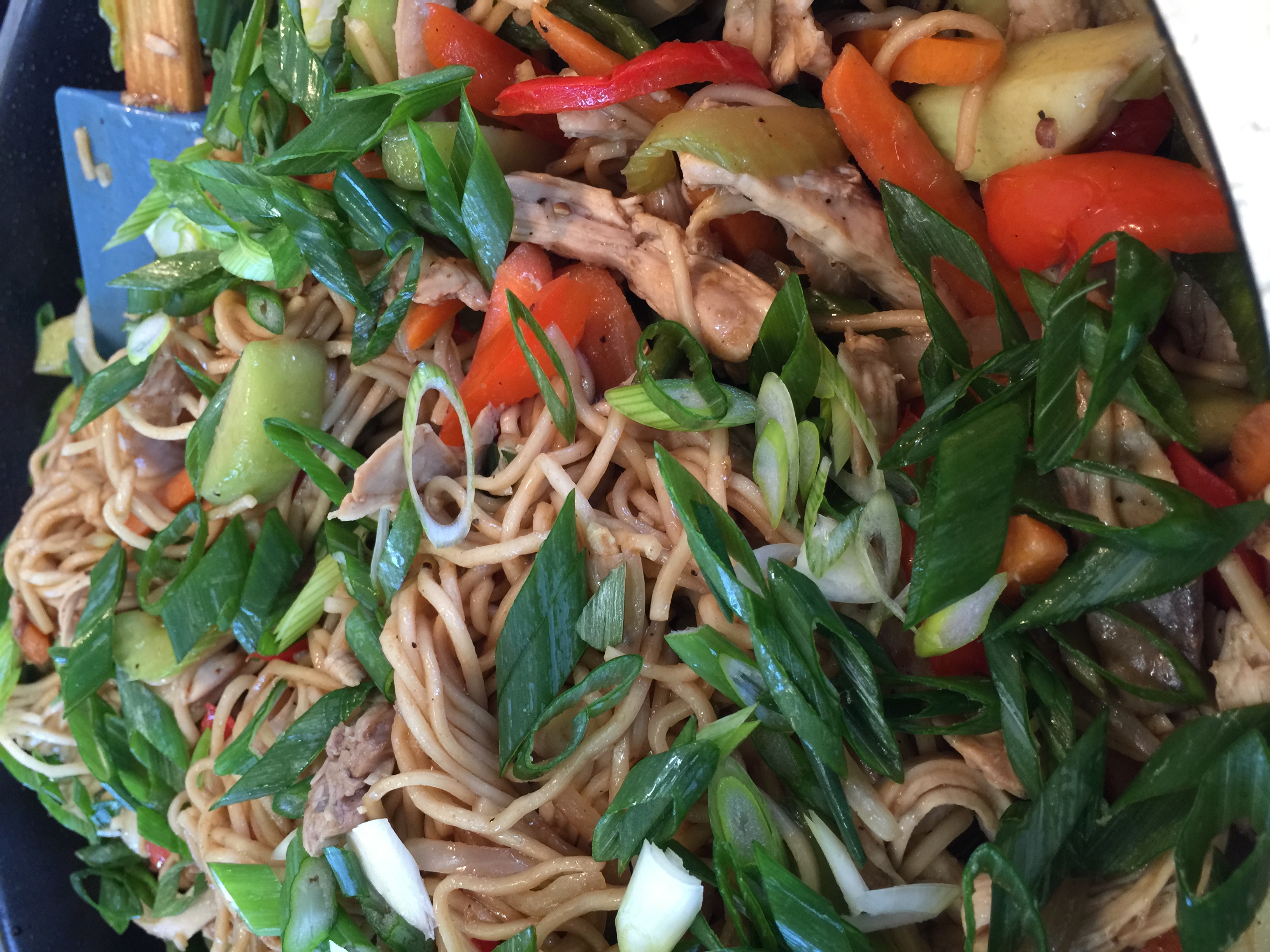
CHAO MEIN
Guatemalan-Style Chicken Lo Mein Stir-Fry
Recipe by Chef Amalia Moreno-Damgaard
Serves 6 to 8 people
Condimentos (Condiments)
Canola oil
1 cup julienned carrots
1 cup julienned celery
1 cup julienned chayote squash, peeled
1 cup julienned multicolored bell peppers
2 cups julienned yellow onions
Salsa (Sauce)
3 teaspoons minced garlic
2 teaspoons freshly grated ginger
1/2 tablespoon canola oil
2 tablespoons cornstarch
1 1/2 cups fat-free, low-sodium chicken stock
3 to 4 tablespoons low-sodium Chinese soy sauce
2 teaspoons Maggi sauce
Freshly ground black pepper
4 cups lo mein noodles, cooked al dente in salted boiling water
3 cups shredded rotisserie chicken, cooked shrimp, or any other protein
Adorno (Garnish)
1/2 cup thinly sliced green onions
1. Add about 1/2 teaspoon of oil to a hot wok or a medium skillet and sauté the fresh vegetables one at a time in the order listed. Transfer each batch of vegetables to a bowl after you cook it. Adjust the oil as you cook each batch, adding about 1/2 teaspoon each time. Cook all the vegetables al dente, about 2 minutes per batch.
2. Make the sauce in the same wok or skillet used for the vegetables. Sauté the garlic and ginger in the oil for 1 minute. Dissolve the cornstarch in the chicken stock. Add the stock and starch mixture and cook, stirring constantly, until the sauce thickens (about 2 minutes). Season with soy and Maggi sauce and freshly ground black pepper. Do not add any salt, as soy and Maggi sauce are high in salt.
3. Return the vegetables to the wok or skillet and combine with the sauce. Add the noodles and the chicken and mix well. Taste and add more soy sauce and freshly ground black pepper, if you like.
4. Serve the chao mein garnished with green onions.
Amalia’s Note
Guatemalan packaged chao mein typically contains noodles, about 1 tablespoon of Chinese soy sauce, and 2 small packets of saborín (MSG). I choose not to use MSG because I have an adverse reaction to it. This recipe is very tasty without it. Use MSG at your own discretion.
UPCOMING EVENTS JULY 2015
Cooking and Wellness – Urban Roots
July 7 @ 1:00 pm - 3:30 pm
Amalia participates in the Cooking and Wellness Program at Urban Roots to teach kids hands-on cooking while incorporating produce from their gardens. Urban Roots has three programs: our Market Garden Program, Conservation Program and Cooking & Wellness Program. Each program contains three components: youth internships (ages 14-18 residing or attending school on Saint Paul’s East Side. More: Urban Roots.
Peruvian Delights
July 14 @ 6:30 pm - 8:30 pm
Byerly’s St. Louis Park
3777 Park Center , St. Louis Park, MN 55416
Amalia shares some of her culinary and cultural experiences from her recent trip to Peru through a fun demonstration that includes classics such as Causa, spicy chicken with potatoes, hard-boiled eggs and olives, Lomo Saltado, beef stir fry with rice and fries. Register: Byerly’s St. Louis Park.
Delish Desserts from the Grill
July 28 @ 7:00 pm - 9:00 pm
Nordic Ware Factory Store
4925 Highway 7, Minneapolis, MN 55416
Summer is finally here and we are ready to kick it off with a sweet cookout! We will be taking advantage of the beautiful weather and barbecue delicious desserts while you enjoy delicious small plates of these easy to make treats. Enjoy Granizadas, grilled pineapple and orange smoothies; Fresas y Queso Con Crema and more. Register: NordicWare.
By Award-winning Author and Chef Amalia Moreno-Damgaard

When we are born we are conditioned to a certain culture and from there we learn everything else. We inherit the habits of our parents, grandparents and surroundings, and later we acquire other customs and traditions. Eating is such an important part of who we are because it stays with us for the rest of our lives. If we have the privilege to grow in abundant food cultures, we develop a sense of identity that stays with us forever.
Food is such an important ritual of the Latin culture as it plays a role in just about everything we do. I understand more about my own food culture now that I am physically removed from my home country than when I lived in it. With that understanding came a deeper level of appreciation of who I am and where I come from and that gives me a great perspective of the world around me. I know now with certainty that I was very fortunate to grow in a nurturing and healthy food environment.
Is there such a thing as good eating and bad eating? Mmmm… I would say yes, but someone else may disagree as the truth lies in the eye of the beholder. I can preach my good eating habits to someone until I am blue in the face, but not until there is acknowledgement and understanding of what good eating is, that acceptance comes into place. We are what we eat…and then we evolve.
Food culture matters because it identifies us and gives us a sense of belonging, but most importantly, it gives us a sense of comfort and nostalgia. When we eat that particular food, we feel closer to home or to a situation that we cherish from our childhood. Having a connection to culture is important yet we may have a foot in another culture. That is the reality of most immigrants, which is not at all bad, but very enriching and interesting as this new environment gives us the opportunity to share proudly about ourselves.
The recipe below is near and dear to my heart because it brings me back memories of times going to the movies with my sister while we were growing up. The recipe is for a street food that reminds me of the street food carts nearby my school and home. I also remember this food and connect it to a humble restaurant where I used to go eat Guatemalan style hot dogs with my dad. Enjoy it!
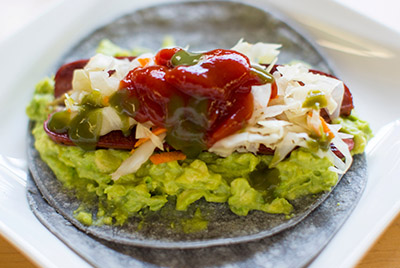
MIXTAS Y SHUCOS
Guatemalan Hot Dogs
Mixtas are stacked open-faced corn tortilla sandwiches. In Guatemala City, mixtas are a common street food. They contain salchichas (hot dogs), guacamole, and herbed pickled cabbage slaw. Mixtas may have originated with German settlers in Guatemala. Shucos are similar to mixtas, except shucos are made with pirujos (Guatemalan bread) or hot dog buns instead of tortillas.
Shucos may contain chorizo colorado (red sausage), longaniza (white sausage), salchicha (hot dogs), and other ingredients. They are topped with condiments such as mayonnaise, ketchup, mustard, or hot sauce.
Serves 4-6
8 to 12 corn tortillas or 4 to 6 hot dog buns, halved and grilled on the inside 1 batch Guacamol Chapín (Guatemalan guacamole for mixtas)–quick recipe below 1 to 2 packages low-fat beef hot dogs or sausage of choice, halved lengthwise, griddled until medium brown 1 batch Curtido Crudo (spicy lime cabbage slaw) –quick recipe below:
Condimentos (Condiments)
Mustard
Mayonnaise
Hot pepper sauce
Ketchup
To make mixtas, warm tortillas in a preheated toaster oven for about 1 1/2 minutes or heat them in a nonstick skillet for 1 minute per side. Top each corn tortilla with 1 or 2 teaspoons of guacamole, a half or whole hot dog, slaw, mustard, mayonnaise, hot sauce, and plenty of ketchup.
To make shucos, spread 2 teaspoons of guacamole on one side of the bun and mayonnaise, mustard, and ketchup on the other side. Add a whole hot dog and top with slaw and hot sauce.
Guatemalan Guacamole for Mixtas-combine 2 mashed ripe avocadoes, the juice of one lime and salt to taste.
Curtido Crudo-combine 2 cups shredded cabbage, the juice of one lime, ½ Serrano thinly sliced and salt to taste.
UPCOMING EVENTS APRIL-MAY 2015
APRIL 2015
Make A Wish Star Society Benefit
April 7 @ 5:00 pm - 8:00 pm
An event to benefit the Make A Wish Foundation featuring Kat Perkins from The Voice, great food and more!
Noche de Colores A Benefit for Common Hope
April 17 @ 5:30 pm - 10:00 pm
A very special evening celebrating friendship, family, and the children of Guatemala.
A Charity Affair in Honor of Financial Literacy Month
April 23 @ 4:30 pm - 8:30 pm
This semi-annual events consists of an evening of networking, appetizers, cocktails, marketplace, wall of wine and silent auction. Our goal is to raise money and change lives.
MAY 2015
Moms Rock! expo - Latin Made Easy
May 2 @ 3:30 pm - 4:00 pm
Minneapolis Convention Center,
Cooking demonstrations featuring quick and easy Latin dishes followed by book signing.
Fire in the Garden at the Arboretum
May 2 @ 6:00 pm - 9:00 pm
Arboretum at UofM
A class celebrating Spring with easy recipes on the grill.
Moms Rock! expo -Tapas and Pintxos
May 3 @ 2:00 pm - 2:30 pm
Minneapolis Convention Center
Cooking demonstrations featuring quick and easy Latin dishes followed by book signing.
By Award-winning Author and Chef Amalia Moreno-Damgaard

During Lent season Catholics have the opportunity to renew their spirits, but it can also be a time to review and revise eating and cooking habits. I happen to love fish and seafood, and Cuaresma inspires me to explore, test and create new and delicious dishes.
Salmon is not only a super fish because it is so good for you (omega 3), but it is nutritious and delicious too, and it is versatile in the kitchen. It can be smoked, steamed, poached, grilled, seared, baked and more. Next time you are looking for something scrumptious to make on Fridays during Lent, think of a simply grilled salmon topped with a refreshing cucumber, tomato, onion, mint and lime salsa paired with roasted potatoes coated with olive oil and thyme.
Shrimp cocktail or ceviche can be starters or main meals. The beauty of ceviche is that anyone can make it without a recipe, but by just remembering the main components of the dish… seafood, onions, cilantro, tomato, chile and lots of lime juice. The style, ingredients and pairings change from maker to maker, i.e. Mexican, Puerto Rican or Costa Rican, and the textures, flavors and looks reflect this. Saltine crackers and corn chips are common accompaniments. They are all delicious!
Pastas combined with a quick sofrito of bell peppers and other vegetables of choice, green onion and lots of garlic, olive oil and fresh lemon juice, can also be the base of a meal that you can top with a piece of pan seared fish, quickly sautéed shrimp and scallops, or any other seafood of choice. On top of that, try adding other layers of flavor and gourmet flair with queso seco (or parmesan) and fresh herbs like parsley and basil to the mixture. One-dish meals can be easy and satisfying without having to include any animal protein at all.
Spicy rice and black beans with bell peppers and cilantro gives you the vegetarian nutrition needed for the day. Simply precook rice in vegetable stock and then combine it with a sofrito of bell peppers, onion, cilantro and black beans and add condiments such as Lizano, Worcestershire and Tabasco sauces. This is a very affordable dish that provides a great yield too (recipe below).
¡Buen Provecho!
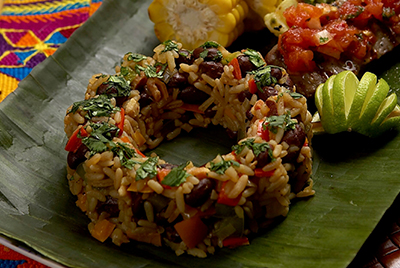
VEGETARIAN GALLO PINTO
Spicy rice and beans with bell peppers and cilantro
Serves 4-6
1 cup finely chopped onion
3/4 cup diced multicolored bell peppers
1/2 to 1 cup canned black beans, drained and rinsed
3/4 to 1 cup washed, finely chopped cilantro incl. stems
2 tablespoons canola oil
1 1/2 tablespoon Lizano sauce (or Worcestershire sauce)
1/2 tablespoon Tabasco sauce
Kosher salt and freshly ground black pepper
2 cups long-grain white rice cooked in fat-free, low-sodium vegetable stock
1/2 cup roughly chopped cilantro leaves for garnish
Sauté the onions, peppers, beans, and cilantro in the oil over medium-high heat for about 3 minutes. Season with Lizano sauce (or Worcestershire or both), Tabasco sauce, salt, and pepper. (Keep in mind that the seasoning sauces already contain salt, so salt with a light hand.) Continue sautéing for 2 more minutes.
Add the rice gradually, making sure it gets well coated with sauce. Use a firm spatula to break any large clumps of rice. Sauté for 2 minutes. Taste and adjust seasonings, if needed. Garnish with cilantro leaves.
UPCOMING EVENTS MARCH 2015
Amalia at Writers Festival & Book Fair
March 28 @ 9:30 am - 5:00 pm
Bloomington Center for the Arts
1800 W. Old Shakopee Road, MN 55431
I will be signing books and mingling with the attendees! I hope to see you there! This program is supported by the Bloomington Theatre and Art Center 12th Annual Celebration of the Literary Arts. Program: Workshops, Book Fair, Author Readings.
By Award-winning Author and Chef Amalia Moreno-Damgaard
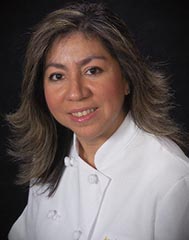
What is comfort food? It depends who you ask. It is subjective and cultural. It is an emotional connection to food by age and gender. It can link people to their home or culture.
Typical American comfort foods are chicken soup, beef stew, mashed potatoes, and others. However, comfort food for men is not necessarily the same comfort food preferred by other groups. Men prefer heartier foods such as steak and potatoes, while women prefer lighter meals that remind them of their childhood or special life experience.
Latin Americans are nostalgic about their culture and especially about their food. They yearn for traditional meals from their countries of origin that remind them of happy memories. Celebrations often tend to include home-style meals with recipes that pass from aunts, moms, daughters and sisters, to cousins. They cherish recipes through time and these eventually become comfort foods. It is a way to reconnect to the homeland.
Comfort food is not always healthy, but there is always a way to modify it to make it healthier paying special attention to fat and salt. Leaner cuts of meat have fewer calories. Roasting in the oven instead of frying can mimic the taste of fried foods. Chicken and fries can be made this way without sacrificing flavor and quality. Sautéing vegetables and other foods in canola or olive oil instead of deep-frying them is a healthier choice. When we cook at home, we can control how much salt goes into the food too.
Some of my favorite recipes for wintertime are soups and stews. They are not only easy and delicious, but often they are hearty one-pot-meals. These dishes often allow us to consume more vegetables in one sitting than when we eat a regular meal. The real bonus here is that we have the option of using a variety of lean and healthy ingredients. We can skim any visible fat that floats to the surface and add as many vegetables and starches as we wish. Also, we can complement soups with avocado, radishes, and fresh herbs.
Below is a classic recipe that I make often for my family.
¡Buen Provecho!

CALDO DE POLLO
Chicken and Vegetable Soup
Serves 4 to 6 people
1/3 cup roughly chopped onion
1/3 cup roughly chopped leek
1/3 cup roughly chopped celery
1 teaspoon roughly chopped garlic
1/3 cup roughly choppped green bell pepper
2 bird’s eye (Thai) chiles, stems removed
1/3 cup roughly chopped Roma tomato
1 1/2 tablespoons roughly chopped cilantro stems
1 1/2 tablespoons roughly chopped parsley stems
1 ½ tablespoons roughly chopped mint
1 tablespoon canola oil
1 fresh bay leaf
2 teaspoons Maggi sauce
1/4 teaspoon kosher salt
Freshly ground black pepper
3 cups fat-free, low-sodium beef stock
1 carrot, peeled, sliced on the diagonal into pieces 1/2 inch thick
1 ear of corn, sliced into pieces 1/2 inch thick
1/2 acorn squash, scrubbed, peeled, cut into 2-inch cubes
1 small russet potato, peeled, sliced into pieces 1/2 inch thick
1 very small yuca, peeled, sliced into 4 to 5 pieces 1 inch thick
1/4 cabbage cut into 2-inch chunks
1 pound boneless, skinless, chicken thighs, visible fat removed, sliced thinly and cut into 2-inch pieces
Garnish
2 teaspoons freshly squeezed lime juice
Chopped cilantro
Avocado slices
1. Purée the first 10 ingredients in a blender or food processor.
2. Add the oil to a hot, medium-size, heavy pot. Add the purée and bay leaf and fry until aromatic, about 2 minutes. Add the Maggi sauce and cook 1 minute. Season with salt and pepper.
3. Add the stock to the purée, stir well, and cook until very hot. Gradually add the vegetables in the order listed. Cook each vegetable for 2 to 3 minutes or until al dente before adding the next one.
4. Add the chicken and cook until cooked, about 8 minutes. Transfer the soup to a serving bowl, season with the lime juice, and garnish it with chopped cilantro and avocado slices.
Amalia’s Notes
Many Latino stores carry sliced, bagged, mixed vegetables for making beef soup. You can use these for chicken soup as well. Maggi sauce is available at most Latino stores and the ethnic section of many grocery stores in the United States.
Amalia’s Upcoming Events
February 24; 7-9pm
Nordic Ware Factory Store, 4925 Minnesota 7, Minneapolis, MN 55416
SOUL WARMERS
Winter is the ideal time to enjoy comforting foods. Learn easy techniques for soulful and spicy soups and stews, such as Sopa de Pollo-chicken soup with cilantro and avocado with freshly made corn tortillas; Carne Guisada-sirloin tips in hearty mole sauce; Pure de Papa-potato puree with olive oil and parsley; Café de Olla-spiced coffee with canela. Register: AmaliaLLC.com.
By Award-winning Author and Chef Amalia Moreno-Damgaard

I anticipate and always welcome the New Year because it gives me the opportunity to renew in so many ways. Throughout the year, we become accustomed to a routine and, at times, it does not seem to have an end. A break from hard work is much needed and it is healthy for the body and mind.
A fresh start not only in business, but also in other aspects of our life can help us put our house in order, breakaway from bad habits, and make New Year’s resolutions. To be successful in our resolutions the goals should be attainable, or we will be frustrated and quit before January is over. This year I will make my goal to complete the research for my second book and will establish milestones monthly. Having a goal (or goals) gives us a sense of purpose in life and it is a way to continue to grow personally.
Another goal of mine will be to make and create new recipes or try new traditional ones. Departing from the old routine of cooking the same thing is fun and wholesome. The kitchen is a therapeutic place for me and I invite anyone to join me for cooking at anytime to create spicy, healthy and delicious food. I enjoy teaching others how to cook, but I am finding even more rewarding teaching my son how to make quick an easy meals that he can create when he is off to college.
How about making it a goal of yours to make a conscious effort to eat and cook healthier this year? You may need some help, but this is the fun part, that you can learn something new while benefiting you and your family’s health in the process. You can start by taking a cooking class or two and by doing research on the internet about the benefits of cooking with healthy oils and fats. You can also find many new recipes that teach healthy cooking techniques and tips for lowering calories that support your goals at WebMD and the American Heart Association website.
Breaking old habits is not easy. It takes 30-40 days to instill any new habit or change in our life. Here is one of my favorite recipes to help you in your new journey, which is not only delicious and healthy, but also super easy to make.
!Feliz Año Nuevo! Happy New Year!
![]() SALPICÓN
SALPICÓN
Beef Salad with Tomato, Mint, and Sour Orange
This scrumptious salad is ideal for entertaining. Traditionally salpicón is made with the beef from Cocido de Res (aromatic beef and vegetable soup) and served as a side dish along with the soup, rice, and warm corn tortillas. But you don’t need to make the soup to cook the beef for this fantastic salad. It is easier to make it this way.
Flank steak is a leaner and healthier alternative to the tougher and fattier cuts used in the traditional version of salpicón. In Guatemala salpicón is made with either sour orange juice or lime juice. A good substitute for sour orange juice is a combination of orange juice and lemon juice.
Serves 4 to 6 people
1 pound flank steak
1/2 teaspoon salt
Freshly ground black pepper
2 to 3 teaspoons oil
1 1/4 cups fat-free, low-sodium beef stock
1/2 onion, halved
2 bay leaves
1/2 cup finely diced onions
1 cup finely diced vine-ripened tomatoes
2 tablespoons finely chopped mint leaves
2 tablespoons freshly squeezed orange juice
1 1/2 tablespoon freshly squeezed lemon juice
1/2 teaspoon kosher salt
Freshly ground black pepper
1/2 Serrano pepper, minced (optional)
Adorno (Garnish)
Lettuce
Mint leaves
Grape tomatoes
Blue corn tortilla crunchies or triangles
1. Season the flank steak with salt and pepper. In a hot, medium-size, deep skillet, sear the meat on both sides in a little oil until medium brown, about 4 minutes per side. Add the stock, onion, and bay leaves, and bring to a quick boil. Lower the heat, cover, and braise until the meat fibers separate easily when pulled (about 1 1/2 hours). Check the meat during the cooking time and make sure the liquid stays at about 1 1/2 cups at all times. (Add 1/2 cup of stock or water at a time as needed). When the meat is done, transfer it to a cutting board and let it cool. Discard the onion and bay leaves. Pour the broth into a cup and freeze it for another use.
2. Cut the meat into 2-inch uniform chunks and chop them coarsely in a food processor. Chop the meat in batches, using the pulsing function for better control.
3. Combine the meat with the rest of the ingredients (except the garnishes). Taste and adjust seasonings, if needed.
4. Serve the salad garnished with lettuce, mint leaves, grape tomatoes, and/or blue corn tortilla crunchies or triangles.
Amalia’s Upcoming Events 2015
Saturday, January 24, 2015; 5:30pm
Thunderbird Aviation, Flying Cloud Airport
Edina Morningside Rotary Gala
More: AmaliaLLC.com (Upcoming Events.)
By Award-winning Author and Chef Amalia Moreno-Damgaard
 The holiday season is my favorite time of the year. Traditions, parties, family, friends, festive meals, presents, lights…. and the list goes on! It is so much fun to visit and chitchat while we sip on our favorite drink and eat many delicious seasonal foods in special company. Indulging is easy, and when the dust settles, many of us find ourselves with a few extra pounds. Mangia bene, or eat well in Italian, seems like an appropriate phrase to describe the holiday eating tradition.
The holiday season is my favorite time of the year. Traditions, parties, family, friends, festive meals, presents, lights…. and the list goes on! It is so much fun to visit and chitchat while we sip on our favorite drink and eat many delicious seasonal foods in special company. Indulging is easy, and when the dust settles, many of us find ourselves with a few extra pounds. Mangia bene, or eat well in Italian, seems like an appropriate phrase to describe the holiday eating tradition.
Being aware of how much we eat is as important as what we eat. However, no one likes being on a diet during a dinner party or celebration, so establishing a smart eating strategy might be a good idea and a way to feel less stressed about uncontrolled eating. It can be as simple as snacking on one or two healthy foods (a banana or a handful of raw nuts and an apple) before going to a party, in that way we do not arrive starved and we are not inclined to overeat. For non-alcohol drinkers, choosing sparkling water with lime or lemon are good zero calorie alternatives to choosing a high calorie soda.
It is easier to control calories at home than at a restaurant or party. We can choose to flavor mashed potatoes with olive oil and chicken stock instead of butter and cream without sacrificing texture and flavor (recipe below). We can sauté vegetables in canola oil instead of butter, or use a small combination of both. We can garnish salads with roasted nuts, dried and fresh fruits, and dress them with lime-honey-fresh herb salad dressing or champagne vinegar, garlic, a bit of sugar and mustard sauce. No fat is necessary to make a salad delicious, but if you must, use olive oil.
Roasting or grilling poultry or meat is a better alternative to deep-frying or cooking in fat. Roasted pork and turkey are healthier cooking alternatives as the fat and the skin can be easily removed after being cooked. Gravies and sauces can be made using store-bought chicken broth or stock instead of using the fat drippings from the roasts, unless they are allowed to cool first to remove the fat. Rather than cooking a bread stuffing, cook a vegetable or chicken-vegetable relleno (stuffing) to pair with your holiday meal (recipe below).
Fresh fruit desserts are healthier alternatives to decadent cakes and pies loaded with whipped cream. If you just cannot resist, use less cream for your dessert, but use skim milk for your coffee and no sugar. Consider plenty of smart eating alternatives and get your smart eating strategy in your head prior to the holiday season start and you just might be surprised how well you did!
Happy Holidays!
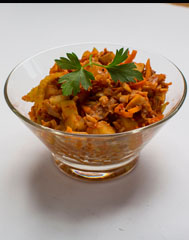
PURÉ DE PAPAS CON PEREJIL
Potato Purée with Olive Oil and Parsley
Side dishes don’t get any simpler than this. For a twist on this delicious recipe, add other herbs or sautéed shallots.
Serves 4 to 6 people
3 cups plain mashed potatoes
1 tablespoon olive oil
3 ounces (3/8 cup) hot fat-free, low-sodium chicken or vegetable stock
2 tablespoons finely chopped flat-leaf parsley leaves
Kosher salt and freshly ground black pepper
1 cup lightly mashed and chunky cooked potatoes
1. Combine the mashed potatoes with the oil, stock, parsley, and seasonings and mix well to blend.
2. Add the chunky potatoes and incorporate them into the mashed potato mixture using folding strokes. Taste and adjust seasonings, if needed.
RELLENO DE POLLO
Chicken and Vegetable Stuffing
Relleno (also called picadillo) means “filling,” “stuffing,” or “hash” in Latin America. This delicious dish can be used for stuffing chicken or turkey or as a stuffing for empanadas, rolled crispy tacos, chiles rellenos, or sandwiches. Or eat it as a side dish with corn tortillas, rice, and beans. Relleno can be made with beef or pork and with varying vegetables. Substitute the meat with cooked garbanzo beans or lentils for a tasty vegetarian dish.
Makes about 6 cups
1 cup finely diced yellow onions
2 teaspoons finely chopped fresh thyme leaves (or 1 teaspoon dry thyme)
2 fresh bay leaves
2 tablespoons canola oil
3/4 cup julienned green beans
3/4 cup julienned carrots
3/4 cup finely diced potatoes
2 teaspoons minced fresh garlic
1 cup canned crushed tomatoes
1 tablespoon plus 2 teaspoons champagne vinegar or white wine vinegar
1 teaspoon kosher salt
Freshly ground black pepper
4 cups chopped skinless store-bought rotisserie chicken
1. In a large skillet over medium heat, sauté the onions, thyme, and bay leaves in the oil for about 2 minutes. Add the green beans, carrots, and potatoes and sauté until aromatic, about 5 minutes. Add the garlic, tomatoes, and vinegar, and sauté 3 minutes. Season with salt and pepper.
2. Add the chicken, stir well to combine all ingredients, and sauté 3 minutes. Adjust the heat to low and continue to cook the chicken and vegetable mixture uncovered, stirring from time to time, until the vegetables are tender and all liquid has evaporated (10 to 15 minutes). Taste and adjust seasonings, if needed.
3. Serve immediately with warm corn tortillas. If you’re using the mixture for stuffing, let it cool completely.
Holiday Themed Events Followed by Cookbook Signing Sessions
Funtastic Holiday Eats
December 5 @ 12:00 pm - 1:30 pm
Byerly’s St. Louis Park,
3777 Park Center, St. Louis Park, MN 55416
Learn quick and easy techniques for delightful appetizers for the holidays.
Wow! Holiday Cocina
December 9 @ 6:00 pm - 9:00 pm
Nordic Ware Factory Store,
4925 Highway 7, Minneapolis, MN 55416
A delicious class featuring Latin cuisine for entertaining during the holiday season.
Teen Kitchen Camaraderie
December 13 @ 12:00 pm - 1:30 pm
Byerly’s St. Louis Park,
3777 Park Center, St. Louis Park, MN 55416
During this son and mother team special class, Jens, a HS sophomore, shows his skills in the kitchen.
To view more events or register, please visit AmaliaLLC.com
By Award-winning Author and Chef Amalia Moreno-Damgaard
 Fall marks the time to begin preparing for seasonal foods associated with the year-end holidays and the colder months. Chilly weather calls for easy comfort fare like soups and stews. These can be light or hearty meals for lunch or dinnertime. To add balance, pair your favorite meal with a quickly tossed salad and top it with proteins of choice.
Fall marks the time to begin preparing for seasonal foods associated with the year-end holidays and the colder months. Chilly weather calls for easy comfort fare like soups and stews. These can be light or hearty meals for lunch or dinnertime. To add balance, pair your favorite meal with a quickly tossed salad and top it with proteins of choice.
Sopa de Nopal (cactus soup), is a nice light option for a quick and healthy meal (recipe at AmaliaLLC.com.) To make it more substantial, add a side salad with lean protein. For vegetarians, make the soup with vegetable broth instead of chicken broth and add legumes (garbanzo, soy, black or any other beans) instead of chicken or other animal protein to a vegetable salad. A hearty Sopa de Pollo y Tortilla (chicken and tortilla soup) with vegetables and corn tortilla pieces, is another hearty alternative. Soups can be made on weekends on the stovetop or Crockpot and are a nice way to break the routine.
Spicy stews like, Jocon (chicken or pork stew with tomatillo-cilantro sauce), and Chile con Carne (spicy turkey chili with beans, mushrooms, and bell peppers), are nutritious, delicious and very satisfying (recipes in Amalia’s Guatemalan Kitchen cookbook available online.) Leftover stews can be frozen for a later time. This can save you time and effort during busy weekdays and give you access to a fresh meal in minutes. Vegetarian stews or soups such as Sopa de Frijoles (black bean soup), can be made from scratch or with a combination of fresh, frozen, or canned ingredients (recipe below). Add chunks of roasted lean meat and quickly sautéed red bell pepper strips to the soup to make it more stew-like.
Ensalada Mixta (mixed salad) is an easy alternative anytime. Simply mix one or a variety of greens with a few vegetables such as tomatoes, red onion, avocado, and cooked potato cubes with a quick lime-garlic vinaigrette. Add store-bought rotisserie chicken pieces to turn the salad into the main meal, or add tofu or other vegetable protein of choice (green peas, edamame, quinoa, nuts, beans, tempeh or tofu and more), to make it vegetarian. Other wholesome salads can be made with bulgur or other ready to cook grains (available at the grocery stores in small boxes with seasonings), chopped spinach or kale, sliced green onions, chopped mint and parsley, and finished with olive oil and lemon juice.
SOPA DE FRIJOLES
Black Bean Soup
More recipes at AmaliaLLC.com
Black beans are high in iron, fiber, and protein. Combined with rice or corn, black beans make a nutritious, affordable, and delicious vegetarian dish. This recipe makes a delicious soup made from scratch, however, to cut the steps use 5 cups of canned beans, skip step 1, and add the cooked beans to step 2 as instructed below.
Makes about 8 cups
2 cups dried black beans, free of debris and rinsed
1 whole medium yellow onion, peeled and t-scored
1 whole unpeeled garlic head
5 cups water
Kosher salt (added after cooking)
1. Combine all ingredients in a medium Crock-Pot set on high. Cover and cook until beans are tender, about 3 1/2 hours. (Alternatively, soak the beans in the water overnight, then cook them in the same water with the onion and garlic on the stovetop over medium-low heat until tender, about 1 1/2 hours.) Discard the onion and garlic.
2. To make the soup, panfry 1 cup of chopped yellow onions in 2 tablespoons of canola oil until medium brown. Add and ½ cup finely diced red bell peppers and 1 tablespoon of minced garlic and sauté 1 minute. Add 1 cup of canned crushed tomatoes and cook for 2 to 3 minutes. Add the cooked beans to this mixture and purée the mixture with an immersion blender.
3. Add 2 1/2 to 3 cups of chicken or vegetable stock and season with freshly ground black pepper, taste, and add salt, if needed. Simmer the mixture to heat it through, about 3 to 5 minutes. Serve with any of the following garnishes: a swirl of crema (Latin table cream), tiny croutons or baked corn tortilla strips, chives, or chopped cilantro.
¡Buen Provecho!
Amalia’s Upcoming Events
Funtastic Holiday Eats
December 5 @ 12:00 pm - 1:30 pm
Byerly’s St. Louis Park, 3777 Park Center, St. Louis Park, MN 55416
Learn to prepare scrumptious dishes in minutes that can be easily adaptable to sides or appetizers. Menu: Mini tostadas topped with guacamole, beans and salsa; Chiles Rellenos-fire roasted peppers stuffed with chicken and vegetables; Tamarind slushies. Cookbook signing follows class. Register at Byerly’s St. Louis Park.
Wow! Holiday Cocina
December 9 @ 6:00 pm - 9:00 pm
Nordic Ware Factory Store, 4925 Highway 7, Minneapolis, MN 55416
Chef Amalia Moreno-Damgaard presents dishes from her award-winning cookbook that are easy, scrumptious and magnificent. Menu: Coctel de Cangrejo y Aguacate-Spicy crab and avocado cocktail; Ponche de Frutas-fresh pineapple and dried fruits holiday punch; Ensalada de Tomate y Huevo-campari tomato and egg salad with garlic vinaigrette; Tortitas de Espinaca-Spinach cakes with red bell pepper sauce. Cookbook signing follows class. Register: Nordic Ware Store.
By Award-winning Author and Chef Amalia Moreno-Damgaard
 Celiac disease is nothing new. It affects children, adults and elders in all parts of the world. More than 2 million people in the US have the disease. Many cases go undiagnosed or misdiagnosed because the symptoms vary by individual and often they can apply to other conditions. Adhering to a gluten-free diet can be challenging for celiac disease sufferers without the proper treatment and information. The food industry has responded with a multitude of gluten-free products to accommodate a rising demand and as a result, main grocery store shelves now stock a great variety of gluten-free foods virtually unseen a few years back.
Celiac disease is nothing new. It affects children, adults and elders in all parts of the world. More than 2 million people in the US have the disease. Many cases go undiagnosed or misdiagnosed because the symptoms vary by individual and often they can apply to other conditions. Adhering to a gluten-free diet can be challenging for celiac disease sufferers without the proper treatment and information. The food industry has responded with a multitude of gluten-free products to accommodate a rising demand and as a result, main grocery store shelves now stock a great variety of gluten-free foods virtually unseen a few years back.
Gluten is present in wheat, rye, barley, bulgur, and their byproducts, such as oats, pasta, breads, cereals, crackers, pies, cakes, cookies, beer, and in many restaurant and home-cooked meals like soups, sauces, and gravies that have been thickened with wheat flour. Other processed foods such as salad dressings, canned soups, candy bars, ice cream, deli cold cuts, instant coffee, ketchup, mustard, pills, vitamins, and even cosmetics, such as lip balm and lipstick, can contain gluten. At times it can be daunting trying to determine which foods have gluten, thus when in doubt, it is best to read labels or ask the maker. The internet is also a great resource (Celiac Disease Foundation, Mayo Clinic, and US Department of Health) for gluten-free foods and information about diet for this chronic condition.
Latin American fare can be a good ally in treating celiac disease. Fruits and vegetables are abundant in many Latin American cuisines and potatoes and rice often complement meals traditionally. Corn in many forms and corn tortillas are also a great and delicious substitute for wheat breads. Gluten-free pasta made with quinoa (a super food from the Andes region), is growing in popularity among not only special dieters, but also with many others who look for new, healthier, and alternative foods. Many Latin balanced meals containing lean proteins, vegetables, fruits, legumes (beans), and gluten-free starches (rice, potatoes, corn, quinoa, amaranth, buckwheat and others), are naturally gluten-free.
Home-cooked meals can be an excellent option for controlling gluten content. A weeknight meal consisting of pan-roasted chicken breast, baked fish or lean pork loin topped with lemon juice and fresh herbs (or a fresh fruit salsa), can be paired with potato purée and a quick salad made with butter lettuce, tomato, avocado and red onion and a quick red wine vinaigrette.
For breakfast, a small bowl containing 3-4 different kinds of fruit, whole grain toast (gluten-free) with a light buttery spread and strawberry preserves (or rice cereal topped with fruit of choice), and paired with a soft-boiled egg, are easy alternatives during a rushed morning. Cutting the fruit the night before eases the routine even more.
Lactose-free milk and dairy products are often part of the diet of people affected with celiac disease. These days it is easy finding all these products at main grocery chains. Licuados (recipe below) are a delicious and nutritious breakfast or snack drinks for the entire familia. Combine lactose-free milk with frozen fruit pulp or frozen fruit chunks, such as mango or strawberries, with a hint of almond extract and sugar to taste, or make a concoction of your own. Alternatively, simply combine various frozen fruits with ice and a bit of orange juice and honey to taste for a lighter and refreshing smoothie treat.
¡Buen provecho!
LICUADO DE BANANO Y FRESA
Banana and Strawberry Smoothie
More recipes at AmaliaLLC.com
 This licuado is a popular, nutritious, and filling drink that takes minutes to make. Both kids and adults love it. It is a nice breakfast drink or afternoon snack. Licuados are sold in most mercados (markets) and in the streets throughout Guatemala and other Latin countries. They are the drink of choice for many Guatemalans. Licuados can contain water or milk and ice as a base. Sometimes they are packaged in a small bolsita (bag) with a straw for convenience
This licuado is a popular, nutritious, and filling drink that takes minutes to make. Both kids and adults love it. It is a nice breakfast drink or afternoon snack. Licuados are sold in most mercados (markets) and in the streets throughout Guatemala and other Latin countries. They are the drink of choice for many Guatemalans. Licuados can contain water or milk and ice as a base. Sometimes they are packaged in a small bolsita (bag) with a straw for convenience
Serves 2 people
1 banana, peeled, broken in half
1/2 cup washed, stemmed, halved strawberries
2 cups milk (lactose-free)
1/2 teaspoon vanilla extract
1/2 teaspoon almond or hazelnut extract
1 tablespoon sugar
Adorno (Garnish)
2 strawberries
1. In a blender, process the first 6 ingredients until smooth. Taste and adjust the sugar, if needed.
2. Serve each licuado garnished with a strawberry.
Amalia’s Notes
You can also make a licuado using ice, water or juice instead of milk. Make a lighter drink by adding more liquid, such as orange juice or any other juice, to the fruit mixture. Strain the licuado and add fruit bits at the end.
In lieu of fresh fruit, use frozen tropical fruit pulp, such as passion fruit, coconut, papaya, guava, tamarind, or others. Fruit pulp is available at Latino grocery stores.
By Award-winning Author and Chef Amalia Moreno-Damgaard
 During September 15 to October 15, the nation’s Latin Americans celebrate their Hispanic heritage in a variety of ways. What a great opportunity and honor to have a whole month to highlight and display our culture, food, music, and more.
During September 15 to October 15, the nation’s Latin Americans celebrate their Hispanic heritage in a variety of ways. What a great opportunity and honor to have a whole month to highlight and display our culture, food, music, and more.
The weeklong observation first began in 1968 by mandate of President Lyndon Johnson and President Ronald Reagan extended it in 1988 to one month to recognize and commemorate the contributions of Hispanic Americans and their ancestors to the US. The celebration, which falls within September 15 and October 15, coincides with the Independence Day of five Latin American countries: Costa Rica, El Salvador, Guatemala, Honduras and Nicaragua, who declared their independence from Spain in 1821. In addition, Mexico and Chile celebrate their independence on September 16 and 18, respectively.
Fifty three million or 17% of the nation’s population is Hispanic. In contrast, Latin America’s population of 595 million is larger than that of the US. National Hispanic Heritage Month today has become a festivity of Hispanics from all Latin nations who proudly embrace their culture and heritage. Within the concept of Latin American, there are 21 Spanish-speaking countries with diverse cultures and traditions, different language enunciations and nuances, varying indigenous languages and ethnicities, and distinctly different gastronomies despite sharing some of the same ingredients. It is amazing how this mass of what we call Latinos in the US coexist harmoniously within the same land having commonalities with each other the main one being Latin American.
Hispanics celebrate this special month in many ways, and as you may have thought, food and music are always at the forefront. Many businesses have office parties during lunchtime, which I often help organize, to bring employees and customers together under one roof with the objective to learn a bit more about Latin culture through the exotic and delicious cuisines. Others celebrate in their own unique way. No matter where and how we celebrate this special occasion, let us always remember what the month represents, -the important contributions of Hispanics to the US that began way before this country was founded.
My favorite way to celebrate the month is with foods from all Latin nations. During special events that I create for business and social groups, I use healthy gourmet cuisine as a platform to educate about cultural synergies in Latin America. I enjoy telling stories during presentations and interactive cooking demonstrations. I often complement my menus with delicious ethnic drinks, music, art, and more. My custom menus are also a way for people to get a taste and appreciation of the cuisines and the cultures of several Latin countries. They may include dishes such as Venezuelan Cachapas (delicious corn pancakes filled with melting mozzarella). A delicious Ceviche Peruano (citrus marinated seafood, potatoes, corn and more).
A succulent Costa Rican Gallo Pinto (rice and beans with bacon, bell peppers and cilantro). A Guatemalan Mayan Pepián (hearty spicy stew with chicken, pork and vegetables). A delectable Cuban pork roast with mojo (garlic-citrus sauce). A delicious Nicaraguan Vigorón (yuca topped with spicy slaw) (see recipe below). Colombian Arepas (corn cakes filled with a variety of delicious goodies), and to end with a sweet refreshing touch, a tangy Rosa de Jamaica (hibiscus drink with canela).
¡Happy Mes Hispano!
Vigorón Yuca with Spicy Lime Cabbage Slaw and Crispy Pork Rind
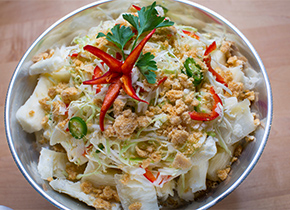
This recipe is shared by a few Central American countries. In Nicaragua, Guatemala and neighboring El Salvador, this dish is often a street food eaten without utensils. It can also be a side dish for home-cooked meals. This recipe was inspired by the street vendors of the east-central region of Guatemala, where buses full of passengers travel from the capital on the Atlantic highway, passing by many food shacks along the way. When the buses stop for fuel, eager street vendors rush toward them with large flat baskets full of cooked treats. Sometimes they even board the buses, filling the air with delicious aromas.
Serves 2 to 4 people
6 cups water
1 teaspoon kosher salt
1 1/2 pounds fresh unpeeled yuca, cut into 1-inch slices
1 batch Curtido Crudo (spicy lime cabbage slaw, recipe below)
1/2 cup crushed crispy pork rind
Curtido Crudo (spicy lime cabbage slaw): In a bowl, thoroughly mix 3 cups shredded cabbage; 3 tablespoons freshly squeezed lime juice; 1/2 cup julienned carrots or red bell pepper; 1 thinly sliced Serrano, jalapeño, or other hot pepper of choice; and 3/4 teaspoon kosher salt. Taste and adjust seasonings, if needed.
1. In a medium saucepan, bring the water to a quick boil and add the salt. Add the yuca and cook it until it is soft, but not mushy (about 15 minutes).
2. Drain the yuca in a colander in the sink. Let the yuca cool slightly. Peel it as you would peel potatoes. Run a paring knife under and around the skin to remove it. Take out the inner core and discard it. With a fork, break the yuca pieces into small chunks, but do not mash them.3. Serve the yuca topped with the slaw and pork rind.
Amalia’s Notes Frozen yuca is available at Latino markets throughout the United States. It is also available fresh at some grocery stores. It takes a bit of time and effort to cut and peel the fresh yuca, but this can save you some money. Crispy pork rind is available at Latino markets by the meat section.By Award-winning Author and Chef Amalia Moreno-Damgaard
 “Your diet is a bank account. Good food choices are good investments.”
“Your diet is a bank account. Good food choices are good investments.”
- Bethenny Frankel
The word diet can signal self-denial, discipline, commitment, eat right, eat less, eat healthy, and more to some people. We learn eating habits early on from our family or caretakers. Our parents or caretakers provide the setting for the eating habits we will have throughout our lives. If the habits are good, we will be in a good situation. If they are not, we could encounter a chain reaction of events that culminate in chronic diseases related to a poor diet and inactivity, excess weight and obesity.
Life is about choices and as adults we are the only ones responsible for ours and our family’s choices and wellbeing. Passing good habits usually translates into making good choices so informed little minds can make educated decisions. Making small changes to curb unwanted behaviors is not easy, but one can start with baby steps and progress onto bigger steps. Easier said than done? Maybe, but if we care about our health and the one of our loved ones, we will make the effort to do the right thing.
Adopting a healthy lifestyle is a gradual and steady process that could start with self-analysis of eating and activity habits. Long ago, with help, I created a food and exercise diary where I tracked inputs and outputs. I recorded calories burned through exercising and calories consumed through what I ate for about 40 days –this is the amount of time needed to change a behavior. The initial process was in my mind, painful, as I had to keep track of food that I normally ate daily while making a conscious effort to choose the foods wisely for nutrition and total calories. I was hungry often because I had not yet learned how to satiate my hunger properly. While I did not have a poor diet to begin with, I re-learned how to eat mindfully. If left unchecked, the weight that I was putting on slowly and gradually yearly as I was aging, could have reached a point of a more difficult return to a healthy weight.
As a chef I have become even more aware of healthy eating and use healthy cooking techniques often to create nutritious delicious meals without sacrificing texture and flavor. I strive to use more wholesome and unprocessed foods (foods in their natural state), which can help us keep our healthy lifestyle and weight in check and our mind healthy too if we exercise regularly (3-5 times a week). A few simple choices can lead us in the right direction, such as cooking with olive and canola oils, and choosing healthy proteins like fish and lean proteins as pork loin or chicken without the skin and visible fat. In addition, it can help choosing fresh dark green leafy foods such as kale and spinach and increasing and varying consumption of fresh or frozen vegetables and fruits, and choosing vinegars and lime or lemon juice to dress salads instead of heavy dressings based on cream or mayonnaise.
Cheers to your new lifestyle!
By Michael Gonzalez-Wallace
 1. Be super smart and exercise your heart
1. Be super smart and exercise your heart
Exercise 1: 15 minutes daily brisk walking or jogging
Cardiovascular activity not only helps us to be physically fit and prevent cardiovascular disease, but it also promotes neuronal growth and helps us get smarter. Kinesiology Professor Charles Hillman from Illinois University found that when you exercise your heart, you also improve your BDNF levels, a protein the enhances neuronal growth improving our cognitive abilities.
2. Brain plasticity and movement
Exercise 2: From a standing position, start clapping your hands and tapping your feet for twenty seconds. Then, pick up some light hand weights and alternate raising your opposite arm and leg for 2 minutes.
Muscles don’t move by themselves; they need specific sections of the brain to help them move. Motor circuits are the networks of nerve cell connections that enable us to perform the full range of our daily movements. Challenge your brain with movement. If you move two muscle groups at once you need to think about it right? You will also be using more brain areas.
3. Agility and balance exercises
Exercise 3: From a standing position, raise one leg up and toss an object into the air, like a tennis ball or a sponge.
Catch it ten times then change legs.
Agility and balance are two of the most important daily activities to enhance our brain muscle connection. When we age, we see how we are not as agile or balanced as before.
Use it or lose it. Challenge that beautiful brain of yours and get ready to feel like never before. Life is about choices and this tips should be on top of your list.
Super Body, Super Brain
www.superbodysuperbrain.com
JOIN THE SUPER BODY, SUPER BRAIN PROGRAM AND GET:
• Individualized Super Body, Super Brain,
Programs (Beginner, Intermediate, Athletes)
• Interactive community
• Meditation routines, Yoga poses, and Stretching
Exercises
• Nutrition tips and recipes for your cognitive
brain and reduce your joint inflammation
• Music Soundtracks for your Brain
• Monthly Conference Calls and Program
Monitoring
By Amalia Moreno-Damgaard

Verano (summer) in Minnesota is my favorite time of the year. A pleasant weather and nature’s fresh colors and textures make an almost perfect season. Butterflies, humming and singing birds, loons, geese and their spring and delicate flowers, decorate lakes and parks like ornaments on a collage.
Kids and teachers off school and parents and siblings on vacation seek the comfort of their cabins or the tranquility of their homes to spend quality family time. Almost simultaneously, the city’s vibe responds with increased outdoor activities, patio and rooftop eateries, and kid’s games and the state fair, as if they had been carefully orchestrated. A smoky aroma permeates the air.
The outdoors invites more get-togethers, cookouts, aquatic sports, and fun in the sun. Fresh lemonade stands and grilled hamburgers and hotdogs create the casual and let it be mood. People respond and behave differently during summer. They even look different. Attitude and dress is more relaxed.
There are physical and mental benefits from all this. Easiness and relaxation adds to one’s well being. Breathing fresh air lifts our spirits instantly while we absorb the much-needed vitamin D from the sun. As a result, we become perkier and happier. Happy people are better neighbors, parents, husbands, wives, and kids with one added bonus. Happiness is contagious and non-toxic. Happy people smile more, have more friends, and work more effectively through challenging life situations.
One good way to have a quality summer in the Twin Cities is to become involved in the many cultural activities the cities have to offer. Checkout what is new in the fine and performing arts and live concerts and music scene, read reviews and eat at some of the new and trendy restaurants, visit one of the many farmers markets, or become immersed in something creative such as taking a class while learning something new. These activities are for everyone and can be very affordable and rewarding. To find even more, just ask Siri what is new in town!
For the grill lovers and cooks, spending time cooking a down to earth meal with friends and family while enjoying some cool drinks and great conversation may be their ideal good time. My idea of a fun and delicious time is to relax sipping a glass of white wine while cooking Latin style bison burgers (recipe below).
Here is to a happy and delicious summer!
HAMBURGUESAS DE BISONTE
Grilled Bison Burgers with Guacamole, Black Beans, Spicy Chile Ketchup, Tomato, Red Onion, and Butter Lettuce
I discovered bison while living in Minnesota. Grass-fed bison is delicious and not at all gamy. It is leaner, lower in calories, and more nutritious than beef.
Serves 2 to 4 people
Tortitas (Patties)
1 pound ground round bison
1 cup finely diced yellow onion
1 cup finely diced Roma tomatoes
1/2 cup finely chopped celery
1 egg, beaten
1/2 cup cornflake crumbs or herbed bread crumbs
Kosher salt and freshly ground black pepper
Adorno (Toppings)
2 to 4 butter lettuce leaves, washed and spun dry
2 to 4 slices salad tomatoes
2 to 3 slices red onions
1 16-ounce can organic, fat-free refried black beans or Frijoles Volteados (refried black beans)
4 to 6 cilantro sprigs
1 batch simple guacamole (1 mashed avocado, the juice of ½ lime and salt to taste)
1/2 cup crumbled queso (Cotija cheese or queso fresco)
Spicy Chile Ketchup
3/4 to 1 cup Heinz ketchup
2 to 3 minced bird’s eye (Thai) chiles
2 teaspoons lime juice
Freshly ground black pepper
2 to 4 Latino buns, sliced and grilled (or whole-wheat buns)
1. In a bowl, combine the bison with the rest of the patty ingredients. Form four equal-size patties (or size them according to taste). Set the patties aside.
2. Prepare all the toppings and arrange them attractively on a platter. Set them aside.
3. Mix all the ketchup ingredients in a small bowl. Taste and adjust seasonings, if needed.
4. Heat the grill (or griddle) and cook the patties over medium-high heat to desired doneness. Slice and grill the buns.
5. Assemble the burgers. Spread some guacamole and sprinkle some cheese on one side of the bun, and then spread black beans on the other side. Add 1 slice of lettuce, then a patty, followed by the spicy chile ketchup, tomatoes and onions, and cilantro sprigs. Serve.
By Amalia Moreno-Damgaard
 Cuaresma or Lent is a time of renewal and opportunity to evaluate ourselves physically, mentally and spiritually, and to make a conscious effort to refresh one’s approach to love and life.
Cuaresma or Lent is a time of renewal and opportunity to evaluate ourselves physically, mentally and spiritually, and to make a conscious effort to refresh one’s approach to love and life.
There are many ways to express love in life and one of my favorites is through delicious healthy food. I relish the time I spend in the kitchen creating scrumptious cuisine for my clients, friends and family because cooking for me is a religious experience. It is also a fun and easy way to bond with people.
Lenten foods abide by the rules of the church for all Christians. Fish and seafood provide such a great opportunity to discover new foods, learn to cook new dishes, learn new techniques, and explore new flavors. As a bonus, fish and seafood are some of the healthiest foods you can eat.
In countries where seafood and fish consumption is high, there are fewer incidents of depression, dementia, cancer, and arthritis because of their diet. Omega 3 fatty acids, the good fat, mainly present in salmon and other fish, spinach, walnuts, flax seed and others, are vital for health because they can help lower the risk of heart disease. The US lags behind in fish consumption in comparison to other parts of the world, making us more prone to these diseases.
Lent is a great time to refresh and renew our health and cooking repertoire. Cooking fish and seafood is easy and faster than other foods. It can be as simple as brushing the fish with a little oil, seasoning it with salt and pepper, and cooking it on a skillet, broiler, steamer, or grill, and making a quick pan sauce for it. The key is to know that one fish filet cooks very fast. How fast? It could be 3 to 5 minutes depending on size and thickness.
Here is a quick and easy recipe to help you lift your spirits this Lent season.
Happy Easter!
ESCABECHE DE SALMÓN
Pan-Seared Salmon with Peppers, Olives, and Capers Herb Vinaigrette
Serves 4 to 6 people
4 to 6 fillets of fresh salmon, sole, corvina, cod, or tilapia (4 to 6 ounces each), rinsed and patted dry
Kosher salt and freshly ground black pepper
Flour
Olive oil
Escabeche (Chunky Sauce)
1 tablespoon olive oil
1/2 cup julienned onions
2 teaspoons minced garlic
2 fresh bay leaves
1 teaspoon fresh thyme (or 1/2 teaspoon dried thyme)
1/4 teaspoon crumbled oregano
1/3 cup julienned poblano pepper
1/3 cup julienned red bell pepper
1/2 cup sliced Spanish olives stuffed with pimentos
2 tablespoons Spanish capers
1/4 teaspoon kosher salt
Freshly ground black pepper
Toque Final (Finishing Touch)
2 teaspoons champagne vinegar or white wine vinegar
1 tablespoon fresh flat-leaf parsley leaves
1. Season the fish generously with salt and pepper on both sides. Dust lightly with flour. Heat a medium nonstick skillet over medium heat. Add the oil and fry the fish 3 to 4 minutes on one side to develop a medium-brown crust. Turn the fillets and panfry the other side until fish appears opaque, flakes easily, and is tender and juicy (2 to 3 minutes). Transfer the fish to a dish, keep it warm, and set it aside.
2. In the same skillet, make the escabeche. Heat the olive oil over medium heat. Sauté the onions, garlic, and herbs for about 2 minutes. Add the peppers, olives, capers, salt, and pepper and sauté 1 1/2 minutes. To finish, turn off the heat, add the vinegar and parsley, and mix well. Taste and adjust seasonings, if needed.
3. Serve the fish topped with the escabeche.
Amalia’s Upcoming April Events
• Spicy Hot CocinaBy Amalia Moreno-Damgaard
 Spring is almost here! Spring is the subtle transition from winter to summer. It is also the time to thaw from a long winter and for rebirth and renewal of all living things and to reevaluate ourselves physically and mentally. Budding trees and shrubs, birds mating and singing, sunshine and lots of color come back to life like magic.
Spring is almost here! Spring is the subtle transition from winter to summer. It is also the time to thaw from a long winter and for rebirth and renewal of all living things and to reevaluate ourselves physically and mentally. Budding trees and shrubs, birds mating and singing, sunshine and lots of color come back to life like magic.
Rebirth
With a new season comes an opportunity for internal and external rebirth. New Year’s resolutions are often short-lived, but spring tends to inspire us in unique ways, from cleaning our homes to getting back into shape. Spring can be an opportunity to look into what needs change in our lives. It is healthy and wise to reevaluate our ways ever so often to replace unwanted behaviors with new energizing ones.
Renewal
As we grow older our tastes and needs change. Renewing our activities in alignment with our current feelings is also healthy and keeps us looking forward to new things. Engaging in nurturing activities can help us stay relaxed and happy and when we are happy, we are inspired to do well for the community and ourselves. The needs out there are endless. We can become mentors or volunteers in support of good causes or we can start a venture of our own to help others grow.
Growth
Internal and physical growth comes from introspection or self-analysis. No one knows ourselves better than us. Experience the joy of growth by reading a new book (or write one), adopt a healthier lifestyle with a healthy diet and exercise, and practice what you preach, especially around children. We can all be good citizens by being conscientious and caring and by loving our hearts and bodies with wholesome actions and good deeds.
Here is an easy and delicious recipe and activity tip to inspire you to spring forward into action.
COSTA RICAN SQUASH AND CORN SAUTÉ
Activity Tip: Farmers markets come back to life in the spring along with the freshest produce. Visit for the vibe and experience of being outdoors in pleasant weather buying fresh ingredients and mingling with local farmers.
Serves 4-6
1 tbsp butterMelt the butter in skillet and sauté onion and garlic for 1 minute. Add corn and chayote squash and sauté 1 minute.
Combine milk, and sugar. Add to sauté pan mixture. Season. Cook for 2-3 minutes more until vegetables are al dente. Taste.
Amalia’s Upcoming March Events
• Essential Living – Keynote Speaker at Body, Life, Mind ExpoBy Amalia Moreno-Damgaard
 February is heart health month. This Valentine’s Day let us celebrate by raising awareness about how precious life is.
February is heart health month. This Valentine’s Day let us celebrate by raising awareness about how precious life is.
According to the American Heart Association, Latin women are likely to develop heart disease 10 years earlier than Caucasian women are and only 1 in 3 Latin women are aware that heart disease is their No. 1 killer. How can we help reverse this trend when culture and habits shape our lifestyle? We know that education is important, but rather than focusing on well-documented statistics, let us concentrate on what we can do each day to help our families and ourselves be well and healthy.
In the Latin culture family plays a central role in everything and women take leading roles in caring for the family, especially in the kitchen, often times disregarding their own self-care. Cooking is an expression of love, and because of tradition and lack of knowledge, it can miss out on healthy eating practices. Assimilating into the American culture often compounds the problem as lack of awareness of another culture’s food system can complicate making healthy choices when buying food. A trip to the store can be easier by learning a few healthy shopping and cooking tips and techniques in order to make healthier choices.
Rather than cooking with lard or corn oil, choose canola or olive oil instead. Substitute traditional cuts of pork and beef for leaner cuts, such as loin, top sirloin, and flank steak and trim any fat. Minimize the consumption of red meat and eat more fatty fish such as salmon and herring. Remove the skin and visible fat from chicken and turkey. Steam, broil, roast, bake, or grill foods instead of deep-frying them (see recipe below). Cholesterol comes from animal meats and their by-products (cheese, butter, milk, eggs, and lard). Free or low-fat cheeses and milk are better choices. Lastly, salt and salty foods and sugar are present everywhere, from fast food to processed foods (canned, bottled, jarred, bagged, and packaged foods). In place of these, choose free or low-sodium, and trans fats-free foods.
Processed foods are not a good substitute for fresh fruits and vegetables because not only can they contain high levels of salt, sugar, unhealthy fats, trans fats, and chemical additives, but also their nutrition level is inferior. Nutrition-dense foods (legumes, grains, fruits and vegetables) contain not only vitamins and minerals, but also healthy fiber that can help satiate hunger longer on fewer calories and help control weight. Basing everyday menus on fresh ingredients and healthy cooking techniques will make your cooking experience easier, more nutritious and delicious. Vegetables should be the stars of our kitchen as they are naturally delicious and need little intervention to enhance their flavor with herbs, lime, vinegar, chiles and spices.
Old habits are hard to break, but ours and our family’s health is worth changing our lifestyle. Good eating behaviors are learned at home and can help guide childrens’ eating habits for a lifetime and switching from a sedentary to an active lifestyle and managing stress with any kind of exercise 3-4 times a week puts us in the right direction of living healthier lives for many years to come. Change is part of life. Make a commitment for change today to make your heart happy!
Happy Valentine’s Day!
PURÉ DE PAPAS CON PEREJIL
Potato Purée with Olive Oil and Parsley
Side dishes don’t get any simpler than this. For a twist on this delicious recipe, add other herbs or sautéed shallots.
Serves 4 to 6 people
3 cups plain mashed potatoes 1 tablespoon olive oil 3 ounces (3/8 cup) hot fat-free, low-sodium chicken or vegetable stock 2 tablespoons finely chopped flat-leaf parsley leaves Kosher salt and freshly ground black pepper 1 cup lightly mashed and chunky cooked potatoes1. Combine the mashed potatoes with the oil, stock, parsley, and seasonings and mix well to blend.
2. Add the chunky potatoes and incorporate them into the mashed potato mixture using folding strokes. Taste and adjust seasonings, if needed.
By Amalia Moreno-Damgaard
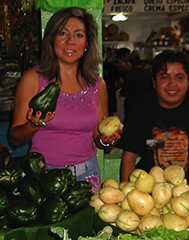 What makes Latin cuisine so hot? It depends who you ask.
What makes Latin cuisine so hot? It depends who you ask.
Despite the recent buzz in the US and elsewhere, let´s clarify that Latin cuisine is still an undiscovered group of cuisines from ancient and diverse ethnicities and cultures. The population of Latin America and land mass as a whole are greater than that of the United States. The Latin region comprises 20 countries with very distinctive customs, traditions, dialects, language (Brazil), topographies, climates, fauna and flora diversity and much more.
There are similarities and commonalities but because of the vast offering, one cannot bundle all Latin countries into one simmering pot of flavors. This is the challenge at fully grasping what Latin cuisine is all about. A systematic approach might shed some light in getting closer to understanding and appreciating Latin cultures in their own right. Trying to wrap one´s arms around the entire continent will prove frustrating and confusing. A better system can be exploring and learning about one country at a time. Think of a puzzle in which every piece has a lot of information to offer.
Throughout my professional culinary journey as an author, chef and cultural strategist, I realized long ago that it takes time and effort to be fully proficient at any one cuisine. Is not that also true about other things in life? It takes constant work, practice, lots of reading and studying, experimenting, testing and tasting lots of delicious flavors. I am referring specifically to Latin cuisine even though the world has a massive cuisine that when broken into regions it´s again huge. For those with a passion for food, the globe is definitely a fun culinary playground to explore.
As a proud Latina and Guatemalan-American chef, I savor every day the beauty and diversity of my own culture. I am motivated to learn more and more because there´s so much unexplored richness and diversity. Often times, the public only sees the surface of Latin cuisine and because of this, I made it my mission to expose the inner beauty. The more I study, write and explore, the more I realize how much more I still need to learn. Briefly, Guatemalan open markets with their bounty of fresh produce and other exotic ingredients, its 22 Mayan ethnicities and other influences, makes for a very interesting land to explore, not only because of the unpretentious delicious colorful cuisines, but because of the majestic sights and traditions and charm of its people. Just think about what each of the other Latin countries has to offer!
Life is an open book -full of delicious surprises for everyone to explore.
¡Feliz Año Nuevo!
AMALIA’S UPCOMING EVENTS - JANUARY 2014
Family Kitchen Time, January 14,
6-7:30PM – Register: Byerly’s, St. Louis Park
Get everyone involved - quality time at home is more precious and fun. There’s no better way to create food awareness than by preparing meals together. Amalia and family demonstrate how to create a fun, festive and dynamic kitchen atmosphere. Enjoy Tortillas con Pollo (freshly made corn tortillas with roasted chicken) and salsa, Mixtas (Guatemalan hot dogs) and chocolate caliente (Latin hot chocolate). Book signing follows class.
¡Asi Me Gusta! January 16, 6:30-10pm – Register: Kitchen in the Market @ Midtown Global Market
A good way to cure the winter blues is indulging in tasty and spicy cuisine, fun cocktails and good company. During this class you will be immersed in Latin America during a culinary journey where you will get a taste of the history and culture while preparing a quick and easy and delicious menu designed by award-winning cookbook author and chef Amalia Moreno-Damgaard. Book signing follows class.
By Amalia Moreno-Damgaard
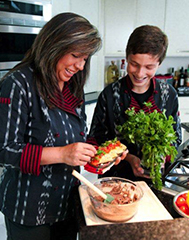 This holiday season let us pay homage to the cocina (kitchen). It is a very special place in the home as it is where everyone in the family spends most of the time every day of their lives. The kitchen brings us together in good and bad times. Often times it is the first place we go to in the morning and the last place we visit in the evening. For some, it may even be the cozy spot on sleepless nights to find comfort with a cup of tea.
This holiday season let us pay homage to the cocina (kitchen). It is a very special place in the home as it is where everyone in the family spends most of the time every day of their lives. The kitchen brings us together in good and bad times. Often times it is the first place we go to in the morning and the last place we visit in the evening. For some, it may even be the cozy spot on sleepless nights to find comfort with a cup of tea.
The kitchen is more than just a gathering place in a home. No matter where you are in the world or what culture you acquire, the kitchen is the place where magic happens. Hands and mind go to work to create beautiful and delicious works of edible art while families can gather to spend quality time. As a bonus, fresher and healthier eating choices can happen organically just by being there.
The official definition of kitchen is “a room where food is prepared and cooked. “ Would it be more appropriate to describe it as a therapeutic place where one can have joy and peace through the creation of deliciousness and nurturing morsels in the company of loving family and friends?
The way we describe places and food creates a picture and perception in people’s minds that can have a positive (or negative) impact. By using words that are appealing, we could entice kitchen-adverse people and children into home-cooking adventures.
Life is a journey, so why not make it into a fun eating adventure cooking as a family and gathering in the kitchen to talk about trivial and important matters. Cooking a multi-course meal from scratch does not have to happen every night to eat right. A simple mixed green salad consisting of dark greens, tomato and onion dressed with light herb vinaigrette accompanied by a store bought rotisserie chicken and a home baked potato one evening can be a healthier option for dinner on a hectic day rather than rushing to the nearby fast food drive-through window. On weekends, lean proteins and vegetable stews and soups cooked on a Crockpot can become one-meal hearty dishes for consumption during busy weekdays.
The kitchen is indeed a very special place for me and for many. It is my sanctuary. This is where I developed my passion for fresh and healthy eating and for quality family time exemplified by a nurturing maternal grandmother. If I could send her a virtual gift to heaven this Christmas, I would tell her −THANKS for inspiring me to eat and live healthy through fresh and delicious home-cooked meals paired with special good family times.
¡Buen Provecho y Felices Fiestas de Fin de Año!
Happy Eating and Happy Holidays!
By Amalia Moreno-Damgaard
Fall is one of my favorite seasons for many reasons. Nature shows off her beautiful colors, weather begins to change along with people’s wardrobes, we start seeing signs of the holidays, and new foods are in season. And, seasonal foods mean fresh foods.
We are in the midst of apple, pumpkin and winter squash season. October is National Apple Month and Minnesota is home to several varieties of apples and other cultivars developed locally, such as Haralson, Honeycrisp, Cortland, Fireside and Zestar, to name a few. Next time you go to the grocery store pick one of each variety of apples available to test the different qualities of each one. Some apples will be more dense and juicy, while others more porous and less juicy. Some will be crisp and sweet and others firm and tart to mildly tart. Apples are native to Central Asia and belong to the rose (rosaceae) family of the malus domestica species.
“One apple a day keeps the doctor away” goes the saying and speaks of the apple’s nutritional power. Although apples are delicious on their own, in the kitchen all varieties of apples can be used in salads, soups, braises and stews, and can even be frozen for a later time. Next time you discover a favorite apple through taste testing, use it in your favorite recipe and remember that by buying local produce you are also supporting local farming.
Pumpkins and winter squash (native to North America) also grown in Minnesota, come in different varieties and pack a nutritional punch, too.They belong to the cucurbit family and so do cucumbers, zucchini and summer squash. Jack O’Lanterns and pie pumpkins are from the cucurbita pepo and c. maxima species, respectively.
Eating pumpkins belong to the first species. Although the flesh of Halloween pumpkins is not ideal for eating, the seeds are edible roasted whole or ground and can be sprinkled on fresh apples to create an easy and tasty Latin-inspired snack, Fruta con Pepita y Chile (see recipe to the right).
Spaghetti, acorn and delicata squash also belong to the cucurbita pepo species, while Hubbard, kabocha and buttercup, belong to the c. maxima species, yet butternut squashes belong to a totally different species, c. moschata. Notice on your next trip to the market, the interesting shapes, sizes and colors of each one. To add variety to your routine and diet, create everyday or elegant holiday meals with the seasonal squash available at your market. Cooked squash (baked, roasted, or steamed) is delicious on its own and need very little enhancement to make it into a scrumptious, wholesome and festive dish.
This Fall celebrate with Autumn’s harvest by eating locally-grown foods and invest the time to nurture your body with nature’s super foods!
In a bowl combine the apples with the lime juice to coat well. Sprinkle with pumpkin seeds, chile powder and kosher salt.
Enjoy!
By Michael Gonzalez-Wallace
Fall time is here and there is not a better time of the year to start a fitness and weight loss program. You maybe want to lose those extra five pounds? Or maybe get stronger arms?
Everyone can do it! Believe in your own potential. It is up to us to define our potential. See where you are at now and envision where you want to be in the near future. You want to get stronger, lose weight, be happier? Then make sure you have a successful plan to accomplish your potential.
• Fast Walking 15 minutes in the morning and in the evening • Strength Training. Pick up two dumb- bells (5lbs), then form a standing position raise the right arm and left leg this is one repetition. DO it 20 times. This is one set.
• Strength Training. Pick up two dumb- bells (5lbs), then form a standing position raise the right arm and left leg this is one repetition. DO it 20 times. This is one set.
• Flamingo Exercise. Ready to challenge your core, agility and strength in one move? This exercise will target two of the most difficult body areas to tone: Your waist and your gluts! You will suddenly get the best of a dancer and a basketball player. Give a try to this movement and bring the best out of you!
Stand tall with one weight held in both hands above your head then cross your right leg behind your left and bend it slightly then raise your right leg to the side with your knee bent while simultaneously bending your waist to the right. Return to the starting position. that is one rep. Do it 10 times then change legs for a full set. Beginners do it three times advanced do it ten times.
• Nutrition and weight loss Tips to Lose 5 lbs in 5 days! Nutrition: Vegging out can lead to weight loss: Superfoods for your Super Body and your Super Brain: Exceptional Free Recipe!If you can’t live without any of them limit quantities to half cup.
Flamingo Exercises


Photos by Beth Bischoff
Vangeline Ortega tells her story, and asks you to do two things: Sign an organ donation form. And get tested for diabetes — especially if you are a person of color.
Twenty-seven years ago, at the age of twenty-four, my kidneys failed because of lupus, an autoimmune inflammatory disease. Lupus causes joint swelling and chronic fatigue. For some people, including me, it also causes kidney failure.
When your kidneys fail, you have two choices: dialysis or a kidney transplant. I must attend a dialysis clinic, where I am hooked up to an artificial kidney (a filter machine) by means of two one-inch-long needles, three days a week for four hours at a time. This procedure cleanses my blood of toxins and excess water, and that allows me to breathe better and have more energy.
I dialyzed for eight years before receiving my first kidney transplant on January 17, 1997. That transplant gave me a pain-free life and energy to share my life with family, friends and community — for ten years. Then, five years ago, my body rejected the transplant, and I had to turn again to the regimen of dialysis.
I believe I have mastered the art of living on dialysis.
Each dialysis “run” leaves me feeling exhausted and consumes all my energy for the entire day. Besides the three days of dialysis, there are two days of the business week to do all the other business of life: work, appointments, errands, housework etc. Then there is the weekend that I use for rest, entertainment and religious functions. I learned time management by necessity! I also learned to ignore the ever-present possibility of failing catheters, potassium imbalances and anemic red blood cell counts that would cause a break in the flow of my activities.
I know I am not alone.
Today there is an average wait of five years for a transplant. In 1997, the wait was three years. Of course, this is average, for patients who match the general population. Multiple factors make my wait longer.
My parents are both from Puerto Rico and I was born in New York City. Hispanics, who are the fastest growing racial group in the United States, are twice as likely to develop kidney failure as non-Hispanic whites, largely due to the increasing prevalence of diabetes mellitus in the Hispanic population, according to an article in the Journal of the National Medical Association.
The increase in the national waiting list time is directly related to the increase in diabetes in the entire U.S. population and even more so in Hispanic communities. Susan Johnson BSN, RN, CNN of Fresenius Medical Care states that about 40 percent of patients with diabetes will go on to need dialysis at some point. The reverse is also true. Kidney patients have a propensity to become diabetic.According to the American Diabetes Association, there are 25.8 million people in the United States, or 8.3 percent of the population, who have diabetes. About seven million of these people don’t know they have diabetes, because they have not been diagnosed. Seven million individuals go undiagnosed. The American Association for Diabetes states that every 17 seconds, someone is diagnosed with diabetes, and diabetes causes more deaths a year than breast cancer and AIDS combined.
I also have an O blood type and many antibodies that make securing a kidney match difficult. Six individuals have gracefully submitted to testing to see whether they were a possible match. They were friends, family, and friends from my congregation. My son and mother were among those who were tested, but to no avail.
All of us, and especially Hispanic communities, need to awaken to the change that must occur. Education about organ donation and diabetes awareness is needed in our communities. If more people become organ donors, the wait time would be reduced. I urge everyone to test for diabetes and to become an organ donor simply by marking it on your drivers’ license, on a notarized note in wallet, or on your health directive.
According to an article in the Journal of the National Medical Association, “Hospitals that serve minority populations have been reported to have the lowest organ procurement rates.” Part of the issue here is lack of information provided to patients and their families about the procurement process, and to overworked social workers and lack of culturally sensitive marketing materials.
Meanwhile, I continue with my regimen and live my life with prayer, entertainment and growth.
By Michael Gonzalez-Wallace
Neck pain is one of the most feared injuries reaching as many as two-thirds of the population of having some form of serious neck pain at some point in their lives.
Neck pain is caused mainly for aging, bad posture either when seating, in front of the computer, walking or even sleeping. Stress, Anxiety, Muscle tightness, cramps and stiffness are minor symptoms that can lead to a more recurrent and serious neck problem. That is why this week exercise will target those muscles supporting the neck improving flexibility, strength and posture alignment.
From a standing position and holding a towel between both hands at a shoulder width level. Raise the towel overhead and pull it back to the point of maximum tension, (you feel tension but not too much) then lower the towel all the way down to the back of your shoulders and return to its original position. This is one rep. Beginners can do it 15 times 3 sets and More Advanced 25 reps 5 sets.

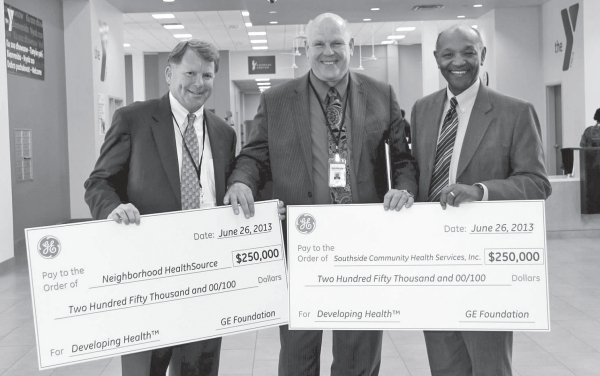
From left to right: Steve Knutson (the CEO of Neighborhood HealthSource),
Joe Buske (CFO of Southside Community Health Services Inc.), and Bill
Tendle (CEO of Southside Community Health Services, Inc.)
Access to primary medical care may become easier for local uninsured and underserved populations, courtesy of $500,000 in grants that have been awarded to two community health care centers from the GE Foundation.
Neighborhood HealthSource and Southside Community Health Services, Inc., both in Minneapolis, were awarded the grants from the GE Foundation as part of the GE Developing Health™ program, which provides funding and support to non-profit health centers across the country. A sizeable volunteer program, to be staffed by GE employees, accompanies the grants.
“We believe our new partnership with GE along with the company’s business knowledge and volunteer support, will only enhance the number of people we can serve and ultimately improve health outcomes,” said Bill Tendle, Executive Director and CEO, Southside Community Health Services, Inc.
“GE employees in the Twin Cities have a strong commitment to volunteerism and improving access to health in the communities where we live and work,” said Deborah Elam, Vice President and Chief Diversity Officer, GE. “We look forward to working with these two health centers and supporting their mission in the Minneapolis community.”
Southside Community Health Services, Inc. and Neighborhood HealthSource are the first two community health centers in Minnesota to be selected as part of the GE Developing Health initiative. Since it was started in 2009, Developing Health has expanded to 37 cities, supporting 108 health centers with $38.9 million and 106,000 community service hours.
 Barbecue season is upon us! Outdoor activities are more fun when we share them
with family and friends. This summer, live on the edge with easy, healthy, and delicious
cuisine.
Barbecue season is upon us! Outdoor activities are more fun when we share them
with family and friends. This summer, live on the edge with easy, healthy, and delicious
cuisine.
The farmers markets are in full swing and the fresh fruit and vegetable bounty is plentiful. Make a fun activity out of visiting a local market and pick seasonal produce that you can make into healthy, quick and scrumptious meals. Your efforts will produce a fresh, more nutritious and delicious feast for the eyes as well as the palate.
What is in season this summer? For starters, corn, tomatoes, a variety of greens, radishes, red and golden beets, berries, micro greens, pea shoots, green beans, herbs, arugula, kale, Swiss chard, head lettuce varietals, spinach, asparagus, fresh mushrooms, baby bok choi, cilantro, carrots, rhubarb, spring greens salad mix, nettles, spring onions, cucumbers, turnips, starter herb plants, and more! With this fresh assortment of locally grown organic produce so easily available, who can afford to not take advantage of it? Fresh organic and unprocessed food is cleaner and better for you, as well as for the farmers and the community as a whole.
Most fresh foods taste delicious without doing much to them. My motto in the kitchen is to make succulent and healthy meals swiftly and efficiently. We all live busy lives and must make use of time in the kitchen as quickly as possible. Contrary to some beliefs, eating fresh meals is easier and in the end less expensive as it translates into a healthier you. Adopting a fresh eating lifestyle can have a very positive impact not only on your health, but also on the waist of the entire family. Lead by example and they will follow.
Below is a delicious recipe that you can make in minutes with minimal effort. For every fresh item on the list above there’s a way of retaining a great deal of nutrients and crunch by simply making salads dressed lightly with lime or lemon, seasonings and fresh herbs, and combined with grilled lean proteins. Alternatively, make side dishes by sautéing vegetables of choice in olive oil and garlic, or steam and top vegetables with a little seasoned herbed butter. Balance your menu with fresh seasonal fruits for dessert. The farmers market is your oyster!
Fresh beets with onion, lime and sea salt
I grew up eating this salad at home. My mother used to make plates with pan roasted pork chops, steamed potatoes topped with seasoned
butter, and fresh beets salad. The combination is superb.
Makes about 2-3/4 cups
3 medium fresh beets, stalks removed, washed,left whole
1/3 cup freshly squeezed lime juice or substitute with champagne or white wine vinegar
¼ cup yellow onion, julienne
Sea salt and freshly ground black pepper to taste
 1. Cook beets in a medium saucepan completely submerged in cold water. Bring to a boil and then lower the heat and cook until tender, about 40 minutes. Transfer the sauce pan to the sink and under running cold water; allow the beets to come to a lower temperature. With your bare hands, peel the beets by squeezing gently while still submerged in the cold water. Transfer to a cutting board.
1. Cook beets in a medium saucepan completely submerged in cold water. Bring to a boil and then lower the heat and cook until tender, about 40 minutes. Transfer the sauce pan to the sink and under running cold water; allow the beets to come to a lower temperature. With your bare hands, peel the beets by squeezing gently while still submerged in the cold water. Transfer to a cutting board.
2. Slice or dice the beets and transfer to a medium bowl. Add the lime juice, onions and season with salt and pepper. Serve immediately, or allow them to sit in the refrigerator until needed.
Amalia’s Notes:
Serve alone as a side or as a nice topping for a salad.
To roast beets in the oven, rinse and pat dry. Rub with a little oil and place in a baking
sheet and bake at 400°F until soft, but not mushy, about 30-40 minutes.
©2013 latino american today. All Rights Reserved.
